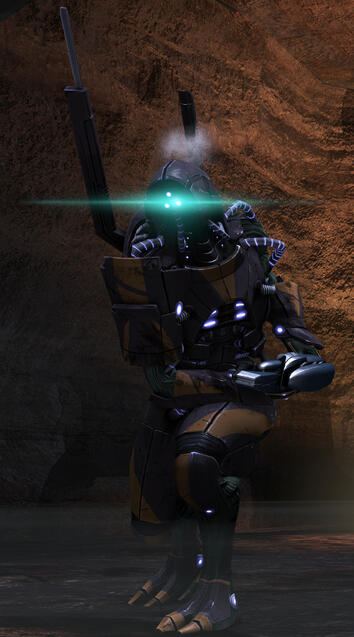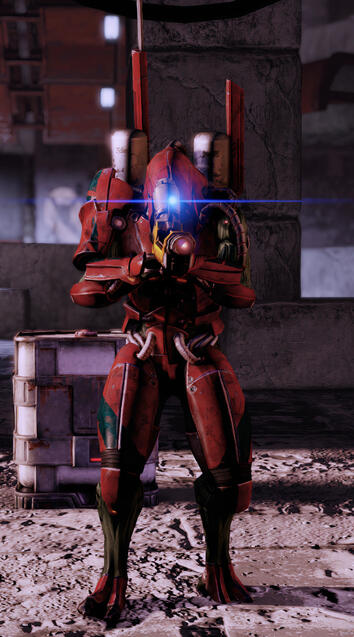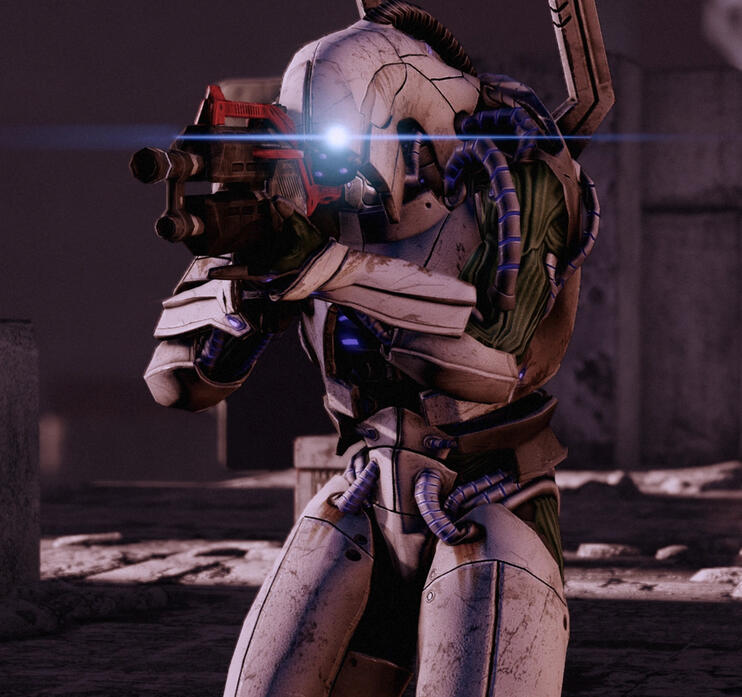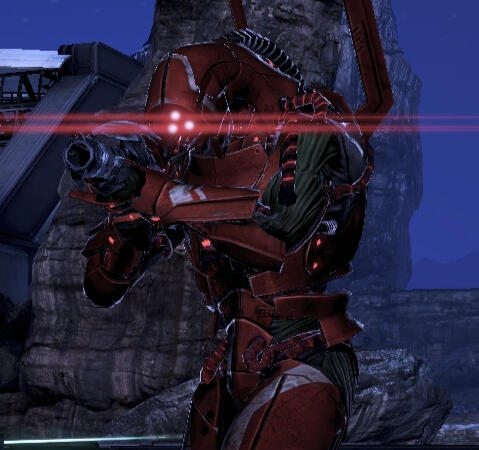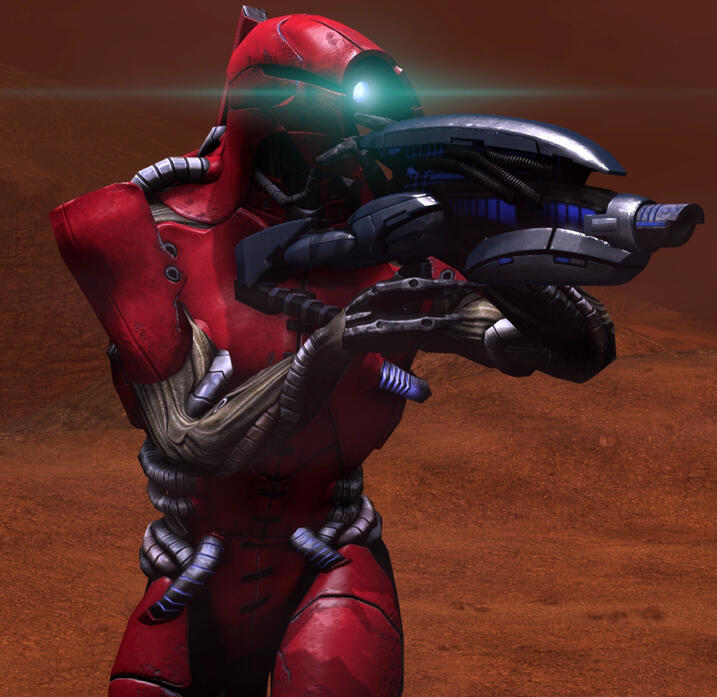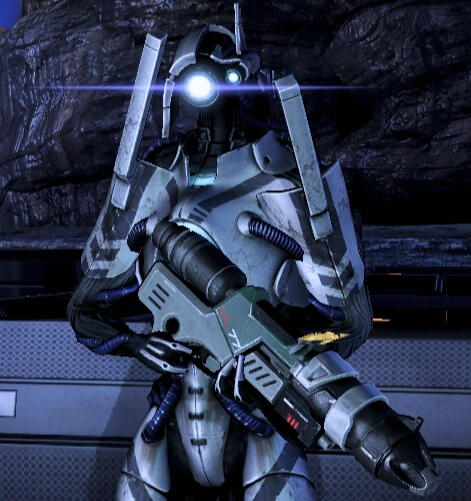Mass Effect Starter Kit
A mobile-friendly carrd designed to provide information (where possible) if you know nothing about Mass Effect, and available for use for anyone with muses in the mass effect universe.
This Carrd is designed to help anyone who is interested in writing in the Mass Effect verse to get started if they're unfamiliar with the verse, or for those who are somewhat familiar but could use a refresher. Much of the information is compiled directly from the Mass Effect wiki, in such a manner that it is easier to navigate than the wiki can be. Currently, this content only covers the original trilogy, and does not cover anything related to Andromeda. Anyone is free to link to it and use it as a resource for crossovers/creating crossover verses/etc.Much of this information is compiled directly from the Mass Effect Wiki and the in-game Codex in a more digestible format than making your way through wiki pages. It may, however, link to specific pages for additional information. Lastly, this guide is written (in general) with the idea in mind that most characters attempting to fit into the Mass Effect universe are human characters, so there may be limited information on the alien races besides a brief, general overview. This information will be added at a later date.
Introduction
WHAT IS MASS EFFECT? Mass Effect is a third-person shooter RPG originally released in the early 2000s by Bioware Inc., a Canadian game development company. If you've ever played Dragon Age, Baldur's Gate, Star Wars: The Old Republic, or Anthem, Mass Effect is another one of their developments. While it is a third-person over-the-shoulder shooter, much of the gameplay is cinematic-based, and Mass Effect is best known for its use of dialogue trees, allowing different responses to conversation by the player-character (known henceforth as Shepard, who will be referred to with gender neutral they/them, as Shepard's gender is up to the player). This approach allows for different conversation paths to, at certain points, lead to alternative game events (including some large-scale decisions) that make changes to the storyline.Mass Effect is categorized into two key storylines: The Mass Effect Trilogy, also known as Legendary Edition (referred to as OT for "original trilogy" or LE for "legendary edition", the latter being the 2021 remaster of the original trilogy) and Andromeda, a spinoff game that takes place in a different galaxy and branches off from the storyline during Mass Effect 2 and takes place 600 years later in the Andromeda galaxy. The original trilogy takes place in the Milky Way galaxy. For the most part, this information carrd will focus on the original trilogy, as it is generally more popular than Andromeda.WHO IS SHEPARD? Commander Shepard is the player-character of the series. By default, "male" Shepard is named "John Shepard", while "female" Shepard is named "Jane Shepard", though there are customization options that are up to the player. Every "Shepard", essentially, is the same base character within the game, but their backstory may vary from player to player. While Shepard is colloquially listed as "male" or "female" within the game, this guide uses the gender neutral "they/them" to refer to Shepard, as Shepard can be any gender identity (i.e. it's up to the individual writer/player to determine via personal headcanon). Much of the overarching game events they will experience are the same, but their reactions to them and the way it affects each Shepard is different. Shepard is unique in the roleplay space that each portrayal is different--effectively making each Shepard fall into an in-between section where they're not exactly a canon character, but not exactly an OC, either; they have elements of both a canon character and an original character. No two Shepards are exactly the same.Shepard has three possible backstory options to choose from:
Colonist: Colonist Shepards were born on the colony of Mindoir, a small farming colony in the Attican Traverse. When they were sixteen, slavers raided the colony, killing or capturing most of them. Shepard survived the attack, but their parents were killed during it. Shepard themselves was saved by a passing Alliance patrol. They enlisted with the Systems Alliance military at the age of eighteen, two years after the attack.
Earthborn: Shepard was an orphan raised on the streets of the great megatropolises covering Earth. Once they were eighteen, they escaped a life of petty crime and underworld gangs by enlisting with the Alliance military. Shepard was part of a gang known as the Tenth Street Reds.
Spacer: Both of Shepard's parents served with the Alliance military, and most of their childhood was spent on ships and stations while their parents transferred from posting to posting, and they never stayed in one location for more than a few years. Shepard opted to follow in their parents' footsteps, enlisting at the age of eighteen.
Shepard also has three possible Service History options to choose from:
Sole Survivor: During their service, a mission Shepard was on went horribly wrong. Pioneers near the colony of Akuze went missing and, as the fifty-man marine unit Shepard was part of settled down for the night after arriving, they were attacked by thresher maws (giant, skyscraper-size carnivorous ground worms). It became an extreme survival situation, and while their comrades were pulled under the sand and killed by the massive creatures, Shepard managed to survive the attack and escaped with their life. This earned them a reputation as a survivor.
War Hero: Shepard was present on the attack on Elysium, an infamous battle known as the Skyllian Blitz (as it took place in the Skyllian Verge). As part of the ground forces, Shepard almost single-handedly repelled the attack by batarian slavers, and was awarded the Star of Terra, considered to be the Alliance's highest honour for bravery in combat.
Ruthless: Shepard was the leader of the team that attacked the moon Torfan, an assault launched in response to the Skyllian Blitz. During this mission, Shepard was ruthlessly efficient, effectively sending three quarters of their unit to death during the assault and, in the process, ruthlessly murdered surrendering batarian pirates and slavers on the moon. This reputation for ruthless efficiency has made other soldiers wary of Shepard.
Some muns may work with these backstories and service history options, but others may opt to chanage the options, tweak them, or work around a couple of them to make their backstory unique.
CLASS SYSTEM. Mass Effect characters are classified into a number of set "classes". Each class has distinct proficiencies in three main areas: general combat using firearms or melee strikes, tech attacks, and biotics. These classes are as follows:
ADEPT. The Adept is the ultimate biotic, able to affect the physical world with the power of the mind. Adepts are durable and powerful manipulators of mass effect fields; they can use biotics to violently manipulate objects in the environment, including nearby enemy targets. Adepts are biotic specialists, capable of disabling and killing enemies with raw biotic power. While they lack advanced combat training, they are the best at defeating enemies without firing a shot.
VANGUARD. The Vanguard is a powerful combatant, able to combine the offensive powers of the Adept and the Soldier. They have access to various weapons and armor, as well as biotics. Vanguards are feared for their high-risk high-reward combat style, closing quickly on enemies and destroying them at close range with weapons and biotic abilities.
SENTINEL. The Sentinel class combines both tech expertise and an aptitude for biotics. Sentinels are support-oriented characters, possessing biotic and tech abilities that allow them to bypass locks and security systems, disable and control enemies, or heal the party. Sentinels are unique, bringing both tech and biotic abilities to the battlefield. While they lack the focus of adepts and engineers, they are versatile and can handle any situation.
ENGINEER. The Engineer is a tech specialist, able to quickly and easily manipulate the environment with specific talents, and repair or modify technical equipment. Engineers are tech specialists, the only class able to employ combat drones on the battlefield. Engineers are the most effective class at blasting through enemy defenses and disabling opponents. Engineers can spawn combat drones to harass enemies or force them out of entrenched cover positions.
INFILTRATOR. The Infiltrator is a tech-savvy warrior, able to win battles by quickly disabling and killing enemies. These soldiers focus on unlocking alternate routes, gaining access to good equipment, and obtaining an advantageous position over enemies in combat. Infiltrators are tech and combat specialists with the unique ability to cloak themselves from visual and technological detection. Their inventory is stacked with a wide variety of weapons, equipment, and powers. Infiltrators are deadly at any range, but particularly so with a sniper rifle. When scoping a target, superior reflexes take over, time momentarily slows down, and the Infiltrator finds an easy picking.
SOLDIER. The Soldier is a tough warrior, able to deal with a range of combat situations. Soldiers are pure combat specialists. No one is tougher or more effective at taking down enemies with gunfire. Soldiers have the most thorough weapons training and can use all special ammo types. High-level operatives are outfitted with ocular synaptic processors that allow them to focus on targets with lethal accuracy. Their major weaknesses are their complete lack of biotic and tech abilities, relying on squadmates to pick up the slack in those areas.
FUN FACT: According to gameplay statistics for Mass Effect Legendary Edition as of July 27, 2021, 40% of players are Soldiers, followed by 21% Vanguards, 15% Infiltrators, 11% Adepts, 8% Sentinels, and only 5% Engineers.
PARAGON/RENEGADE MORALITY SYSTEM. Paragon and Renegade are the two ends of the morality system that exists within the game, though Shepard can fall anywhere on the line between them. Other, in-between options are Paragade (Paragon-leaning, but with some Renegade tendencies) and Renegon (Renegade-leaning, with some Paragon tendencies). Generally, Paragon/Renegade can be summed up as Paragon is "nice", "good", but not necessarily soft, while Renegade is more ruthless, hardass, and generally more aggressive (and at times, morally questionable). A Shepard's Service History determines their starting morality points in the game (Sole Survivor starts with bonus Paragon and Renegade points, War Hero starts with bonus Paragon points, and Ruthless starts with bonus Renegade points. Shepard's service history, however, does not necessarily determine their morality. Remember: every Shepard is different!ROMANCE SYSTEM. In the context of the game, almost every squadmate available has a romance option at some point throughout the trilogy. Some Shepard writers may have a "canon romance" for their Shepard (i.e. the squadmate they pursued a romance with), and some may not. While some squadmates are locked in to certain Shepard portrayals for romance (ex. Steve Cortez and Samantha Traynor in the third game, who both identify as homosexual), this may also vary from writer to writer (ex. Thane and Garrus were options only for female Shepard, while Miranda and Jack were only options for male Shepard). As a result, check and respect the decisions of the individual writer for squadmates' sexual orientations, as they may vary from writer to writer. Lastly, if there is a "canon" romance listed for a particular Shepard, this does not necessarily mean they are not open to other options/ships--you may just have to discuss with them first!
Key Areas
GALACTIC AREAS. The Milky Way galaxy is split into a number of different sections with key locations in each, as detailed below.
INNER COUNCIL SPACE: Inner Council Space is the central region of the area of space under the control of the Citadel Council. In addition to its centrality, Inner Council Space holds great importance to the Council. First, it is home to the Citadel, the seat of galactic government. Second, it contains the homeworlds of several of the galaxy's sapient races. These include the salarians and the turians, two of the races with representation on the Citadel Council, as well as the hanar and the volus, both of which also have Citadel representation. Finally, the homeworld of the krogan, a former Citadel race, is located within this region.
OUTER COUNCIL SPACE: This area consists of the majority of space claimed by the asari as well as the elcor homeworld. It is bordered by Inner Council Space and the Attican Traverse. While the elcor content themselves with their home system and a handful of colonies, the asari have settlements across the territory. Easily the most economically powerful sector of the galaxy, the asari worlds use their financial clout to keep the galactic market stable. Their military fleets patrol shipping lanes and colony space against smugglers arriving via relays from the Attican Traverse.
EARTH SYSTEMS ALLIANCE SPACE: The name of the region is somewhat of a misnomer: While it includes Earth and much of the territory under the control of the human Systems Alliance, not all human colonies are located in this region. Moreover, it also envelops the heart of batarian space, including the batarian homeworld of Khar'shan. Earth has increased its holdings more than tenfold since the discovery of the Charon Relay linked humanity to the rest of the galaxy. Humanity's aggressive expansionism has triggered conflicts with several neighboring species and their governments, most notably the Batarian Hegemony. Despite this, the Systems Alliance shows no signs of slowing its growth.
ATTICAN TRAVERSE: the true frontier of Citadel-controlled space. The area contains many worlds once inhabited by the Protheans, and many mass relays are located throughout the systems of the Traverse. Colonies established in the Traverse are subject to constant raids and attacks from the nearby Terminus Systems, but the presence of multiple worlds both rich in resources and Prothean ruins, continues to draw colonizing interest. Though the Citadel officially claims the region as its own, the forces of the Terminus Systems have claimed many of the planets and systems to be under their control. Unwilling to engage in an all-out war against the Terminus Systems, the Citadel has adopted a military non-interference policy in the region. However, the Council makes no objection to the Systems Alliance's expansion in the Traverse, because the large Alliance Navy can settle unstable regions without the Council needing to get involved.
TERMINUS SYSTEMS: These systems are populated by a loose affiliation of minor species, united only in their refusal to acknowledge the political authority of the Council or adhere to the Citadel Conventions. Their independence comes at a price; the Terminus is fraught with conflict. War among the various species is common, as governments and dictators constantly rise and fall. The region is a haven for illegal activities, particularly piracy and the slave trade. The prevalence of batarian criminal gangs has led to the batarian language becoming a "lingua franca" in the Terminus. The Terminus Systems have no government, but the Omega station serves as a trade capital. At least once a year, a fleet from the Terminus invades the nearby Attican Traverse. These attacks are typically small raids against poorly-defended colonies. The Council rarely retaliates, as sending patrols into the Terminus Systems could unify the disparate species against their common foe, triggering a long and costly war. Despite the dangers, Citadel races have not been deterred from traveling through and even extensively colonizing the Terminus Systems themselves. Humans, turians, salarians, elcor, asari, and volus each have a sizable colonial presence there. Since the Citadel Council's authority is nonexistent, these colonies are often fully independent from any interplanetary government. The Terminus Systems also encompass the homeworlds of the quarians and the vorcha.
KEY PLANETS/LOCATIONS. Below are a number of key locations that may be referenced. Some are homeworlds of particular species, others are important hubs that have significant societal or story impact. Most were featured as hubs worlds/stations in the trilogy.
THE CITADEL. The Citadel is the galactic hub of civilization. It is a colossal deep-space station located in the Widow system, with connections to most of the major mass relays. It was supposedly constructed by the long-extinct Protheans. It consists of a central ring (the Presidium Ring) with five arms (the Wards) that can close and turn the station into an impenetrable cylinder. However, the Citadel arms only close in times of emergency.The Presidium is a massive park-like complex with offices for diplomats, various alien embassies, shops, restaurants, and recreational facilities, and commonly serves the wealthier residents of the station. It also incorporates an artificial 20-hour day-night cycle, where for 6 of the 20 hours, the holographic "sky" is darkened as if it were "nighttime". The tower at the center of the Presidium houses the Council Chambers and the main traffic control for the station—any ship within a few thousand kilometers comes under the jurisdiction of Citadel Control. The Chambers themselves are not open to the public and access is only granted to officials and those with special clearance. They are beautifully furnished, with cherry trees and fountains, as well as numerous staircases leading up to the central platform where the Council convenes.The Wards--the "arms" of the Citadel--constitute the residential and commercial sectors of the station. The Wards are densely populated and house millions of residents from many galactic species; it is akin to earth cities like Hong Kong or Singapore. Numerous skyscrapers rise from the superstructure, sealed against vacuum, as breathable atmosphere is only maintained to a height of approximately 7 meters. Unlike the Presidium, there is no artificial day-night cycle; as a consequence of this, commercial activity rarely ceases, and residents work and rest according to personal need. It is appropriately dubbed the "cultural heart of the Citadel".The Wards are policed by the Citadel Security Services (C-Sec), whose offices and custody suites are located in the Lower Wards. Flux is a popular night club, also located in the Wards. The Wards are also home to the Silversun Strip, a bustling commercial area featuring Silver Coast Casino, Castle Arcade, Armax Arsenal Arena, and the apartment complex Tiberius Towers. Below the Wards, the Citadel Archives function as a repository for artifacts and records deemed important.
NOVERIA. Noveria is a cool, rocky world, with most of its hydrosphere locked up in massive glaciers. A privately-chartered colony world, the planet is owned by the Noveria Development Corporation holding company. The NDC is funded by investment capital from two dozen high technology development firms, and administrated by an Executive Board representing their interests.The investors built remote hot labs in isolated locations across Noveria’s surface. These facilities are used for research too dangerous or controversial to be performed elsewhere, as Noveria is technically not part of Citadel space and therefore exempt from Council law.By special arrangement, Citadel Special Tactics and Reconnaissance agents have been granted extraterritorial privileges, but it remains to be seen how committed the Executive Board is to that principle. Given its unique situation, it is understandable that Noveria is often implicated in all manner of wild conspiracy theories.
ILLIUM. A regional hub of asari commerce awash in riches, Illium is infamous for its abusive labor practices and legalization of nearly everything except murder. As such, Illium is the preferred production site for weapons and pharmaceuticals that would be illegal nearly everywhere else, made even more lucrative by legal indentured servitude. Among the biotics-related pharmaceutical producers is the Dantius Corporation, a rising star in galactic commerce.Despite the dangers of its products, Illium is renowned for glamor, luxury, and safety (provided by near-total surveillance), making it a favored tourist destination. Countless celebrities maintain palatial estates on Illium and in its capital, Nos Astra. The sole obstacle to business on Illium is its extensive bureaucracy, tolerated only for its provision of security.Regardless of the character of its economy, Illium's self-congratulatory media exalts its own society with the provincial arrogance of "new money," glorifying in "sexiest CEOs" and "ten richest residents" lists.
OMEGA. Originally an asteroid rich in element zero, Omega was briefly mined by the Protheans, who eventually abandoned it due to its thick, impenetrable crust. Thousands of years later, nature did what even the Protheans could not: a collision with another asteroid broke Omega in half, exposing its trove of element zero for easy mining.A rush ensued as corporations and private individuals tried to strike it rich on Omega, and thieves and outlaws followed in their wake. As space became tight, construction of processing facilities extended vertically from the asteroid, creating Omega's jellyfish-like silhouette. To prevent future collisions, the station is ringed with enormous mass-effect field generators that redirect incoming debris.Today, Omega is a major hub of narcotics, weapons, and eezo trafficking without even a pretense of civilian government or military control. Only mercenary groups have been able to instill a limited order; the most ruthless is an asari syndicate run by the notorious Aria T'Loak.
Technology
INTRODUCTION. This section will introduce some of the basic technologies that exist in the Mass Effect universe, as well as anything revolving around healthcare/other advancements that exist. It will also cover biotics, which are especially important for human characters, as biotics are a marginalized group within human culture in the Mass Effect universe.
COMPUTERS & COMMUNICATION. Much of the technology used in Mass Effect is easily translatable to the current world: in Mass Effect, they have terminals (computers), datapads (tablets), and the extranet (a much wider version of the internet). Most computers use HAPTIC ADAPTIVE INTERFACES: modern input peripherals are usually holographically displayed in front of the user at a height and angle for ergonomic ease. Machines that use this interface detect a user through a microframe chip in the user's glove that "keys in" to the computer. Once a user is accepted, motion accelerometers in the user's gloves match his hands' location with that of a proportionate but smaller "mirror" set of controls inside the computer itself. As the user presses against the holographic field, force-feedback in the glove kicks in, giving a slight resistance. A person can feel his way through using a touch-screen that isn't actually there. A simple toggle switch on the back of the hands allows the glove to be turned off when not in use.Haptic interfaces have become so common that some individuals undergo cybernetic enhancement surgery to have the accelerometers implanted in their fingertips. "Going bareskin" is the sign of a committed computer user who no longer has to fuss with putting on gloves or cleaning them with alcohol wipes to get rid of the clammy-hand smell.
OMNI-TOOL. A handheld device that combines a computer microframe, sensor analysis pack, and minifacturing fabricator. Versatile and reliable, an omni-tool can be used to analyze and adjust the functionality of most standard equipment, including weapons and armor, from a distance. The fabrication module can rapidly assemble small three-dimensional objects from common, reusable industrial plastics, ceramics, and light alloys. This allows for field repairs and modifications to most standard items, as well as the reuse of salvaged equipment. Omni-tools are standard issue for soldiers and first-in colonists. More details here.
EXTRANET & COMMUNICATION. Real-time communication is possible thanks to networks of expensive mass relay comm buoys that can daisy-chain a transmission via lasers.Comm buoys are maintained in patterns built outward from each mass relay. The buoys are little more than a cluster of primitive, miniature mass relays. Each individual buoy is connected to a partner on another buoy in the network, forming a corridor of low-mass space. Tightbeam communications lasers are piped through these "tubes" of FTL space, allowing virtually instantaneous communication to anywhere on the network. The networks connect across regions by communications lasers through the mass relays.With this system, the only delay is the light lag between the source or destination and the closest buoy. So long as all parties remain within half a light-second (150,000 km) of buoys, seamless real time communications are possible. Since buoys are maintained in all traveled areas, most enjoy unlimited instant communications. Ships only suffer communications lag when operating off established deep space routes, around uninhabited outer system gas giants, and other unsettled areas.During wartime, comm buoy networks are the first target of an attack. Once the network is severed, it can take anywhere from weeks to years to get a message out of a contested system. In systems where a buoy network has not yet been built or has been destroyed, rapid communication means ferrying information through high-speed courier ships and unmanned data drones.While comm buoys allow rapid transmission, there is a finite amount of bandwidth available. Given that trillions of people may be trying to pass a message through a given buoy at any one time, access to the network is parceled out on priority tiers.The Citadel Council and the Spectres have absolute priority; if they are using all the bandwidth, everyone else must wait. Individual governments and their militaries enjoy the next-highest tier. During wartime, civilian communication can suffer hours or even days of lag. Intelligence agencies study ping time through various systems to predict military buildups.Below the governments and militaries, bandwidth priority is sold to the highest bidder. Media conglomerates, particularly headline news networks, purchase higher priority to provide their viewers with timely information. Corporations that require timely information and response capability (for example, financial institutions and investment firms) also invest heavily in priority access. The funds acquired through sales of bandwidth are used to maintain and expand the communications infrastructure.While everyone with a computer has guaranteed free and unlimited access to the galactic extranet, they are last in line for bandwidth and may have to wait for their requests to be processed. Bandwidth resale corporations use investment capital to purchase blocks of high priority access, made available by paid subscription.As the population of the galaxy increases and new worlds are settled, timely access for home users and frontier settlements with underdeveloped communications infrastructures is a growing problem. To ameliorate bandwidth issues, a sophisticated array of data caches and virtual intelligence search agent programs are available.When a user submits a query, it is first routed to the data cache, the user's search agent VI collates mountains of locally-stored data to find the desired material. If the information is not available locally, the query is passed along to neighboring systems, and then outward in an expanding network. VI search agents in those systems replicate the search. If the desired information is found, it is compressed into a "burst" file and queued for transmission to the source system. The burst is assigned a priority based on the number of queries for it; the greater the number of queries, the higher the priority.When a new solar system is first connected to the net, a selection of the most popular data is installed locally. Though storage hardware is cheap, the capacity required to hold all the data produced everyday by trillions of people on hundreds of worlds is not trivial. It's not economical to store local copies of all the data available on obscure topics just in case.As colonies mature, older and less-popular chunks of data filter into them as a result of queries and are placed in the local archive. Searches for obscure topics are increasingly likely to produce instant results as the archive grows.
QUANTUM ENTANGLEMENT COMMUNICATION. When a pair of quantum-entangled particles is separated, a change to one particle will affect the other instantaneously, wherever it lies in the universe. QECs exploit this effect to transmit binary data any distance. Two pairs of entangled particles are necessary for transmission and reception.While QEC technology is extremely expensive and difficult to produce, it offers two enormous advantages. First, it allows instantaneous communication over any distance without reliance on the network of comm buoys, which is limited due to the sheer volume of space. Further, destruction of buoys hampers a foe’s military intelligence; comm buoys are the first targets of raiders in wartime. Second, quantum communications cannot be intercepted between source and destination, allowing no "wiretaps."Unfortunately, QECs cannot replace the galactic civil communications infrastructure. First, they have extremely limited bandwidth. A single entangled particle can only transmit a single qubit (quantum bit) of data at once. Second, the system’s exclusively point-to-point nature precludes peer-to-peer networking and data dissemination through the galactic extranet.The most strategically appropriate military application of QECs is at the headquarters level. Each Alliance colony would maintain a QEC at its military headquarters and each fleet flagship in its CIC. All the pairs for these would be located at a central facility within Arcturus Station. During an attack, a facility would signal Arcturus to transmit its information to every other fleet and colony. However, destruction of the comm center at Arcturus would collapse the entire network.
INTELLIGENCES. These are split into two types: virtual intellience, or VIs, which are sophisticated computer algorithms used for basic interfacing. Current-world examples are Alexa, ChatGPT, and Siri, which would be considered virtual intelligences. The second is artificial intelligence, which is considered illegal in most parts of Citadel space (the difference between VI and AI are that AI are sentient and capable of independent thought; VIs are incredibly sophisticated, but lack independent thought). The most widely-known example of an AI are the geth, created by the Quarians in the late 1800s, but other examples have existed (ex. in Mass Effect 2 and Mass Effect 3, EDI - "Enhanced Defense Intelligence" - is the AI equipped on the Normandy and, later, in her own humanoid platform). AI research is for the most part illegal, though some companies (Synthetic Insights Ltd, as well as 3 other companies) have been licensed to research by the Citadel Council.
Element Zero & Mass Effect Physics
ELEMENT ZERO, "EEZO". When subjected to an electrical current, the rare material dubbed element zero, or "eezo", emits a dark energy field that raises or lowers the mass of all objects within it. This "mass effect" is used in countless ways, from generating artificial gravity to manufacturing high-strength construction materials. It is most prominently used to enable faster-than-light space travel.Eezo is generated when solid matter, such as a planet, is affected by the energy of a star going supernova. The material is common in the asteroid debris that orbit neutron stars and pulsars. These are dangerous places to mine, requiring extensive use of robotics, telepresence, and shielding to survive the incredible radiation from the dead star. Only a few major corporations can afford the set-up costs required to work these primary sources.
MASS EFFECT FIELDS. Element zero can increase or decrease the mass of a volume of space-time when subjected to an electrical current. With a positive current, mass is increased. With a negative current, mass is decreased. The stronger the current, the greater the magnitude of the dark energy mass effect.In space, low-mass fields allow FTL travel and inexpensive surface-to-orbit transit. High-mass fields create artificial gravity and push space debris away from vessels. In manufacturing low-mass fields permit the creation of evenly-blended alloys, while high mass compaction creates dense, sturdy construction materials.
MASS RELAYS. Mass relays are feats of Prothean engineering (later, we learn that mass relays were in fact created by the Reapers using technology far beyond that of other living species). They are enormous structures scattered throughout the stars, and can create corridors of virtually mass-free space allowing instantaneous transit between locations separated by years or even centuries of travel using conventional FTL drives.Primary mass relays can propel ships thousands of light years, often from one spiral arm of the galaxy to another. However, they have fixed one-to-one connections: a primary relay connects to one other primary relay, and nowhere else. Secondary relays can only propel ships a few hundred light years, however they are omnidirectional: a secondary relay can send a ship to any other relay within its limited range.There are many dormant primary relays whose corresponding twins have not yet been located. These are left inactive until their partner is charted, as established civilizations are unwilling to blindly open a passage that might connect them to a hostile species.
BIOTICS. Biotics is the ability of rare individuals to manipulate dark energy and create mass effect fields through the use of electrical impulses from the brain. Intense training and surgically-implanted amplifiers are necessary for a biotic to produce mass effect fields powerful enough for practical use. The relative strength of biotic abilities varies greatly among species and with each individual.There are three branches of biotics. TELEKINESIS uses mass-lowering fields to levitate or impel objects. Mass-raising KINETIC FIELDS are used to block or pin objects. DISTORTION uses rapidly shifting mass fields to shred objects.Most organic species are capable of developing biotic abilities, though there are risks involved. Biotics are the result of in-utero exposure to element zero. This usually causes fatal cancers in the victim, but in rare cases it coalesces into nodules within the fetus's developing nervous system.
Medical & Physiological
GENETIC ENGINEERING. In the 22nd century, manipulation of the human genome became commonplace. Techniques of genetic engineering advanced to the point where the rich could custom-build fetuses that grew into stronger, smarter, and more attractive adults. In more permissive regions, custom-designed life forms and 'uplifted' animals occupied an ill-defined niche between 'property' and 'sapient being'.Travel to planets with unique forms of life brought an awareness that Earth's unique biodiversity could be lost if spliced and hybridized to gain useful alien qualities. The Sudham-Wolcott Genetic Heritage Act was passed by the Systems Alliance Parliament in 2161. It imposed sharp restrictions on controversial uses of genetic engineering, but provided government subsidies for beneficial applications.
SCREENING AND THERAPY: Most governments provide free assessments and corrective therapy for genetic diseases in prospective parents. This has nearly eliminated everything from cystic fibrosis to nearsightedness. The earlier screening and therapy is performed, the more comprehensive the results. Though ideally performed on artificially fertilized zygotes in a lab, procedures are available for embryos in the womb and newborns, out of respect for personal beliefs.
ENHANCEMENT: Improvement of natural human abilities is legal, but adding new abilities is not. Treatments to improve strength, reflexes, mental ability, or appearance are permitted; adding a tail or the ability to digest cellulose is not. Some genetic enhancement is provided for free to Alliance military recruits, but the average citizen must pay for the privilege. The process can take years to reach fruition in an adult.
ENGINEERING: Artificial hybridization of genes from compatible non-human species with human genetic code is illegal. Creation of designed life is broadly legal (and mainly used for terraforming and medical applications), but sentient creatures are heavily regulated, and creation of sapient life is outlawed by both the Systems Alliance and the Citadel Council.
MEDICAL ADVANCEMENTS: Humans can live to about 150 years, and recent medical advances have eradicated almost all known diseases that afflict them, including the majority of cancers. The human body's ability to heal from injury has accelerated due to significant medical advancements, such as the ability to clone skin or organs directly from a patient's DNA rather than relying on donor organs; missing limbs can be repaired in the same way, though the process is much longer.
HUMAN BIOTICS: Like most organic races, humans are also capable of producing biotic individuals. All cases of natural biotics in humans are the result of pre-natal exposure to element zero (eezo), which carries a high risk of medical complications. As the true discoveries of eezo applications were not until 2148, there are no human biotics born before that time. (In short, this means as of the first game in the trilogy, no human biotics are older than 32-33 years of age).
MEDI-GEL. Medi-gel is a common medicinal salve used by paramedics, EMTs, and military personnel. It combines several useful applications: a local anesthetic, disinfectant and clotting agent all in one. Once applied, the gel is designed to grip tight to flesh until subjected to a frequency of ultrasound. It is sealable against liquids - most notably blood - as well as contaminants and gasses. The gel is a genetically-engineered bioplasm created by the Sirta Foundation, a medical technology megacorp based on Earth. Technically, medi-gel violates Council laws against genetic engineering, but so far, it has proved far too useful to ban.
Combat & Weaponry
BODY ARMOR & HARDSUITS. Combat hard-suits use a dual-layer system to protect the wearer. The inner layer consists of fabric armor with kinetic padding. Areas that don't need to be flexible, such as the chest or shins, are reinforced with sheets of lightweight ablative ceramic. The outer layer consists of automatically-generated kinetic barriers. Objects traveling above a certain speed will trigger the barrier's reflex system and be deflected, provided there is enough energy left in the shield's power cell.Armored hard-suits are sealable to protect the wearer from extremes of temperature and atmosphere. Standard equipment includes an onboard mini-frame and a communications, navigation, and sensing suite. The mini-frame is designed to accept and display data from a weapon's smart targeting system to make it easier to locate and eliminate enemies.
KINETIC BARRIERS. Kinetic barriers, colloquially called "shields", provide protection against most mass accelerator weapons. Whether on a starship or a soldier's suit of armor, the basic principle remains the same. Kinetic barriers are repulsive mass effect fields projected from tiny emitters. These shields safely deflect small objects traveling at rapid velocities. This affords protection from bullets and other dangerous projectiles, but still allows the user to sit down without knocking away their chair. Some experienced biotics can generate their own kinetic barriers rather than relying on a module in their hardsuit as well. The shielding afforded by kinetic barriers does not protect against extremes of temperature, toxins, or radiation.
MASS ACCELERATOR. A mass accelerator propels a solid metal slug using precisely-controlled electromagnetic attraction and repulsion. The slug is designed to squash or shatter on impact, increasing the energy it transfers to the target. If this were not the case, it would simply punch a hole right through, doing minimal damage. Accelerator design was revolutionized by element zero. A slug lightened by a mass effect field can be accelerated to greater speeds, permitting projectile velocities that were previously unattainable. If accelerated to a high enough velocity, a simple paint chip can impact with the same destructive force as a nuclear weapon. However, mass accelerators produce recoil equal to their impact energy. This is mitigated somewhat by the mass effect fields that rounds are suspended within, but weapon recoil is still the prime limiting factor on slug velocity.
WEAPONRY. All modern infantry weapons from pistols to assault rifles use micro-scaled mass accelerator technology. Projectiles consist of tiny metal slugs suspended within a mass-reducing field, accelerated by magnetic force to speeds that inflict kinetic damage.The ammo magazine is a simple block of metal. The gun's internal computer calculates the mass needed to reach the target based on distance, gravity, and atmospheric pressure, then shears off an appropriately sized slug from the block. A single block can supply thousands of rounds, making ammo a non-issue during any engagement. Top-line weapons also feature smart targeting that allows them to correct for weather and environment. Firing on a target in a howling gale feels the same as it does on a calm day on a practice range. Smart targeting does not mean a bullet will automatically find the mark every time the trigger is pulled; it only makes it easier for the marksman to aim.Weaponry falls into five categories: sniper rifles, assault rifles, shotguns, heavy pistols, and sub-machine guns (SMGs).
Major Races
Council Races
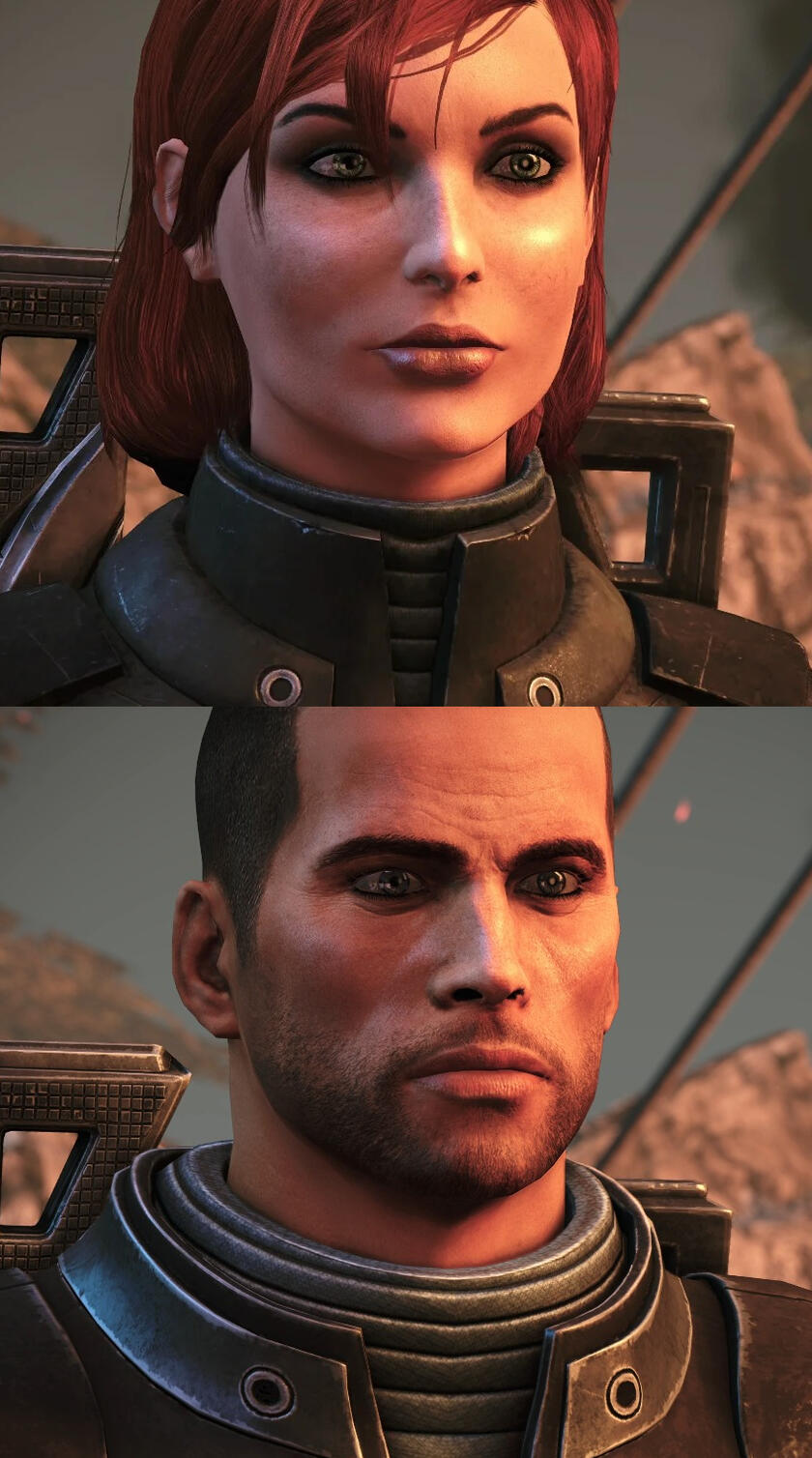
HUMANS. Humans, from the planet Earth, are the newest sentient species of notable size to enter the galactic stage and are the most rapidly expanding and developing. They independently discovered a Prothean data cache on Mars in 2148, and the mass relay networks shortly thereafter. Humans have a fairly robust physiology. In comparison to the Council races, humans are roughly physically on par with turians (as a human in or around peak physical condition can overwhelm a similarly fit turian, making them near equals in a hand-to-hand combat situation), and less agile than asari (whom they closely resemble). Humans would appear on average to be stronger than salarians but not as fast, due to the extremely elevated metabolisms of the latter.Despite the substantial genetic diversity of humans, certain physical traits have been becoming rarer ever since the 19th and 20th centuries, when the mixing of different Earth ethnicities, due to social progression and acceptance, became more commonplace. To this end, with the merging of genetics, certain traits have declined in frequency. Recessive physical traits like blonde and red hair, as well as blue and green eyes, are even less common in the 22nd century. More information on humans can be found here.
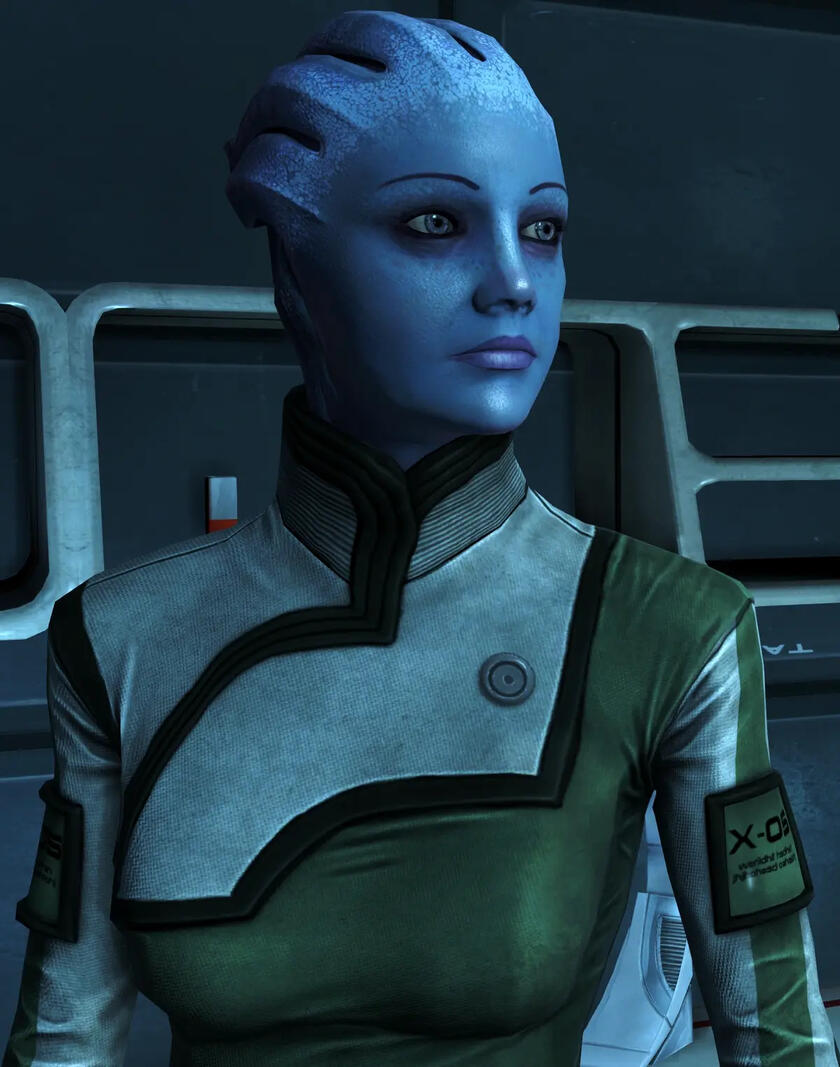
ASARI. The asari were the first species to discover the Citadel. When the salarians arrived, it was the asari who proposed the establishment of the Citadel Council to maintain peace throughout the galaxy. Since then, the asari have served as the mediators and centrists of the Council.An "all-female" (genderless, with femme physical features) race, the asari reproduce through a form of parthenogenesis. Each asari can attune her nervous system to that of another individual of any gender, and of any species, to reproduce. This capability has led to unseemly and inaccurate rumors about asari promiscuity.Asari can live for over 1000 years, passing through three stages of life. In the Maiden stage, they wander restlessly, seeking new knowledge and experience. When the Matron stage begins, they 'meld' with interesting partners to produce their offspring. This ends when they reach the Matriarch stage, where they assume the roles of leaders and councilors.
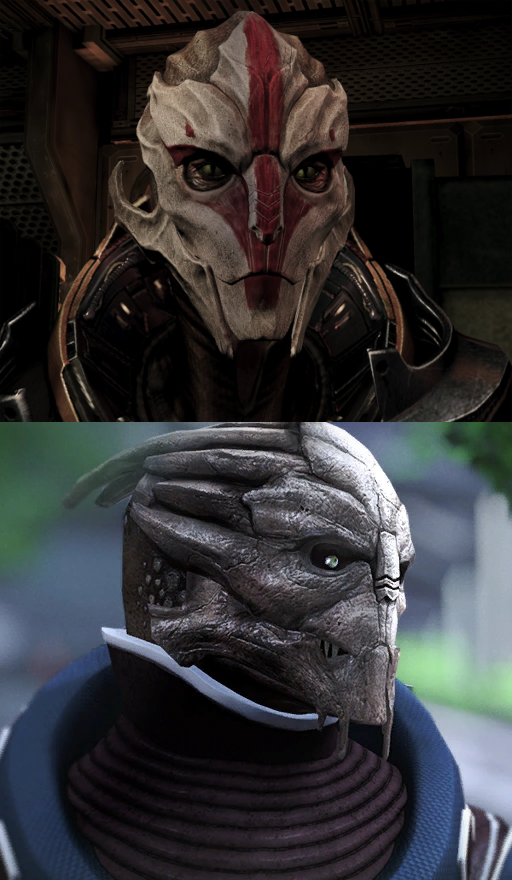
TURIAN. Turians typically stand over six feet tall [180cm], have two long, proportionately thick fingers and an opposable thumb on each hand, each tipped with talons, and a set of mandibles around their mouths. The most distinguishing feature of turians is their metallic carapace, which contains trace amounts of thulium. Turian features are avian, making them resemble humanoid birds or raptors. Unlike most Earth avian creatures, turians are viviparous and give birth to live young. Turians are also recognisable by their voices, which have a distinctive flanging effect. Males and females do not differ greatly in terms of physical appearance, but female turians lack the sweptback cranial crests of their male counterparts and possess larger, cat-like eyes.Known for their militaristic and disciplined culture, the turians were the third race to join the Citadel Council. They gained their Council seat after defeating the hostile krogan for the Council during the Krogan Rebellions. The turians then filled the peacekeeping niche left by the once-cooperative krogan, and eventually gained a Council seat in recognition of their efforts. The turians have the largest fleet in Citadel space, and they make up the single largest portion of the Council's military forces.As their territory and influence has spread, the turians have come to rely on the salarians for military intelligence and the asari for diplomacy. Despite a somewhat colonial attitude towards the rest of the galaxy, the ruling Hierarchy understands they would lose more than they would gain if the other two races were ever removed.Turians come from an autocratic society that values discipline and possesses a strong sense of personal and collective honor. There is lingering animosity between turians and humans over the First Contact War of 2157, which is known as the 'Relay 314 Incident' to the turians. Officially, however, the two species are allies and they enjoy civil, if cool, diplomatic relations.
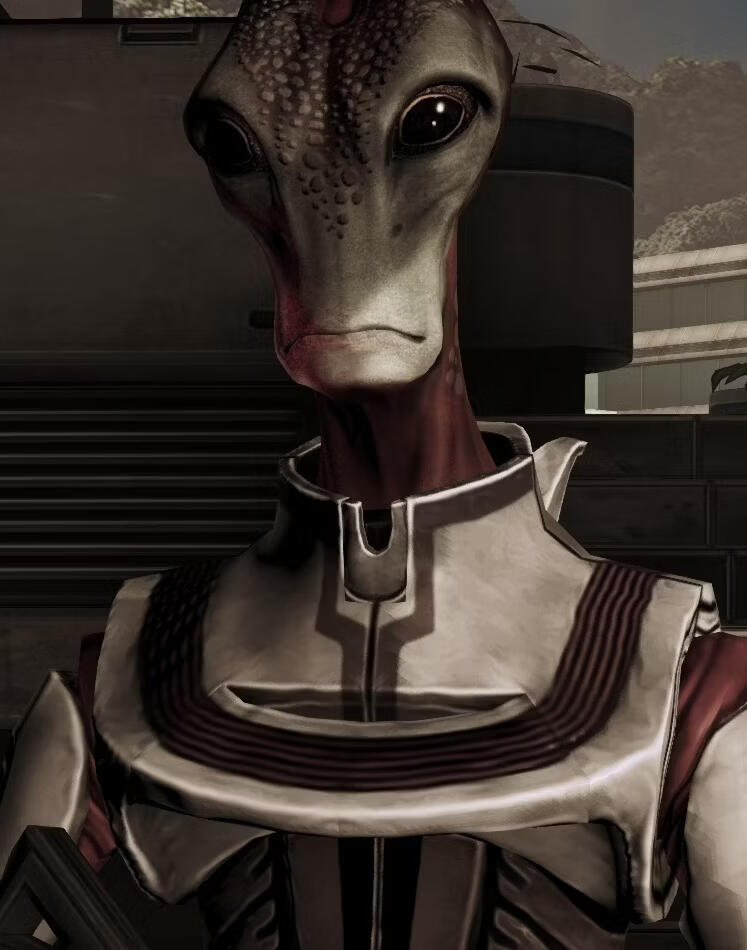
SALARIAN. The second species to join the Citadel, the salarians are warm-blooded amphibians with a hyperactive metabolism. Salarians think fast, talk fast, and move fast. To salarians, other species seem sluggish and dull-witted. Unfortunately, their metabolic speed leaves them with a relatively short lifespan; salarians over the age of 40 are a rarity.The salarians were responsible for advancing the development of the primitive krogan species to use as soldiers during the Rachni Wars. They were also behind the creation of the genophage bioweapon the turians used to quell the Krogan Rebellions several centuries later.Salarians are known for their observational capability and non-linear thinking. This manifests as an aptitude for research and espionage. They are constantly experimenting and inventing, and it is generally accepted that they always know more than they're letting on.
Non-Council Races
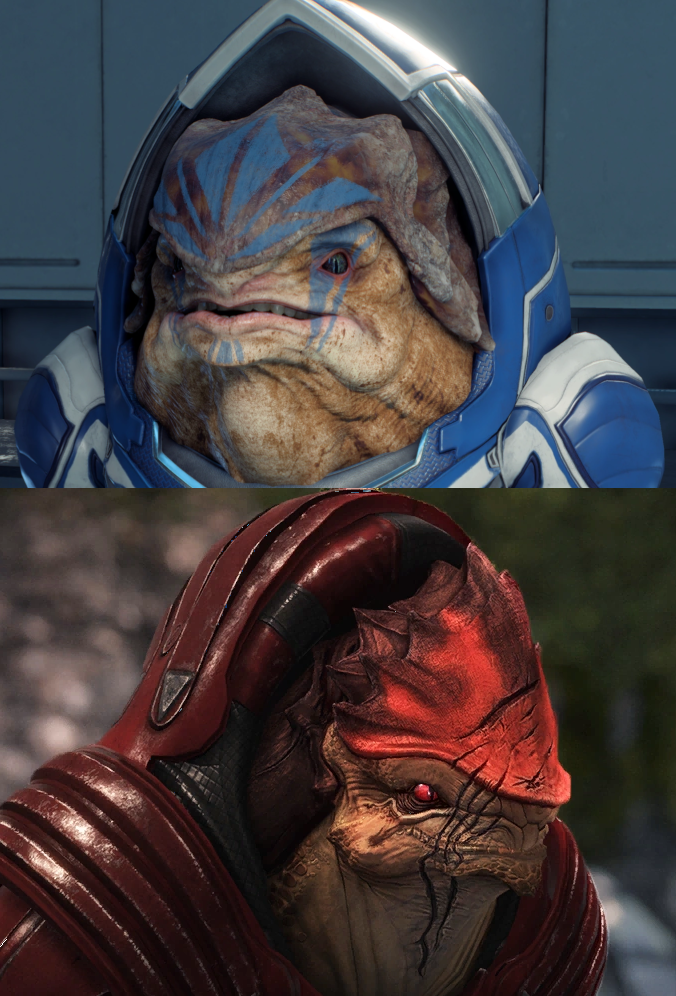
KROGAN. The krogan evolved in a hostile and vicious environment. Until the invention of gunpowder weapons, "eaten by predators" was still the number one cause of krogan fatalities. Afterwards, it was "death by gunshot".When the salarians discovered them, the krogan were a brutal, primitive species struggling to survive a self-inflicted nuclear winter. The salarians culturally uplifted them, teaching them to use and build modern technology so they could serve as soldiers in the Rachni War.Liberated from the harsh conditions of their homeworld, the quick-breeding krogan experienced an unprecedented population explosion. They began to colonize nearby worlds, even though these worlds were already inhabited. The Krogan Rebellions lasted nearly a century, only ending when the turians unleashed the genophage, a salarian-developed bioweapon that crushed all krogan resistance.The genophage makes only one in 1,000 pregnancies viable, and today the krogan are a slowly dying breed. Understandably, the krogan harbor a grudge against all other species, especially the turians.
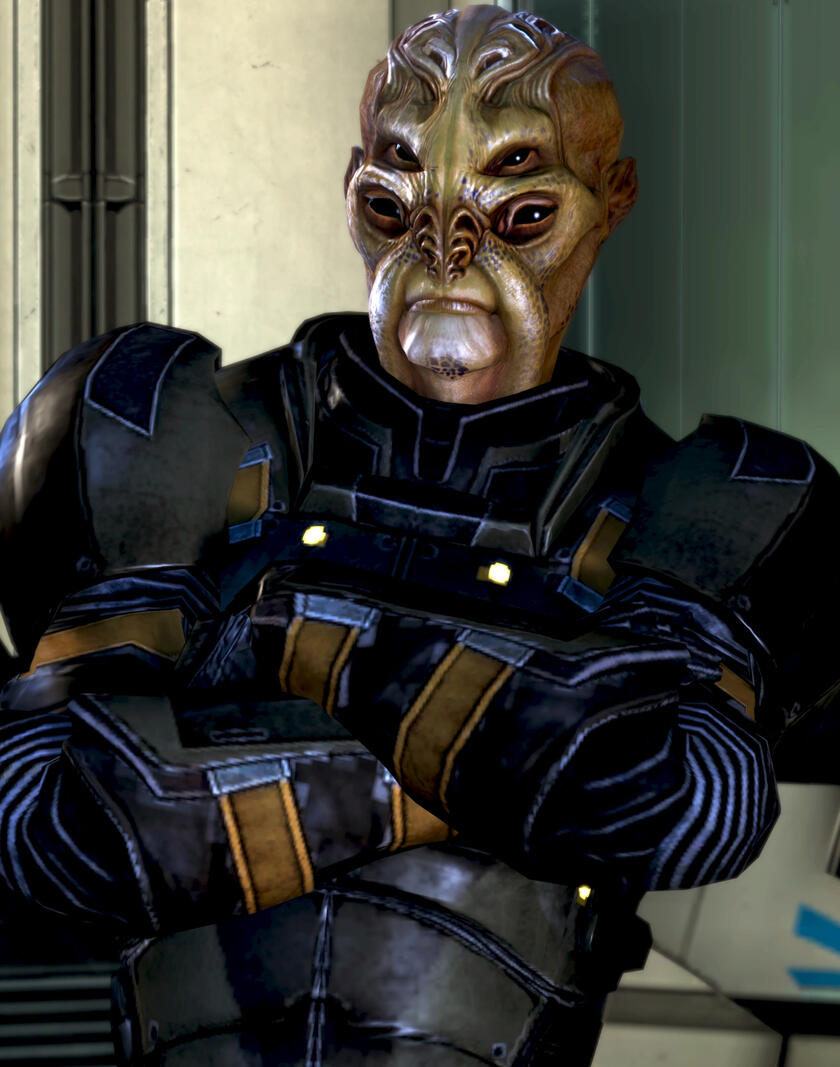
BATARIAN. A race of four-eyed bipeds native to the world of Khar'shan, the batarians are a disreputable species that chose to isolate itself from the rest of the galaxy. In the early 2160s, the Alliance began aggressive colonization of worlds in the Skyllian Verge, much to the dismay of the batarians who had been developing the region for several decades. In 2171, the batarians petitioned the Council to declare the Verge a "zone of batarian interest". The Council refused, however, declaring unsettled worlds in the region open to human colonization.In protest, the batarians closed their Citadel embassy and severed official diplomatic relations with the Council, effectively becoming a rogue state. They instigated a proxy war in the Verge by funneling money and weapons to criminal organizations, urging them to strike at human colonies.Hostilities peaked with the Skyllian Blitz of 2176, an attack on the human capital of Elysium by batarian-funded pirates and slavers. In 2178, the Alliance retaliated with a crushing assault on the moon of Torfan, long used as a staging base by batarian-backed criminals. In the aftermath, the batarians retreated into their own systems, and are now rarely seen in Citadel space.
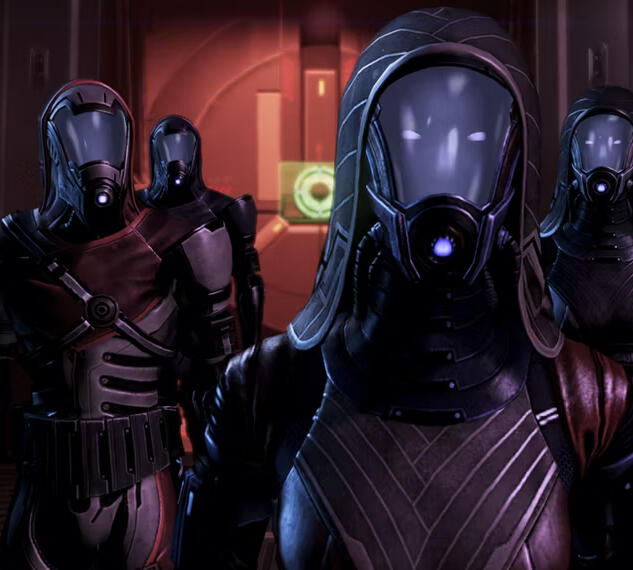
QUARIAN. Driven from their home system by the geth nearly three centuries ago, most quarians now live aboard the Migrant Fleet, a flotilla of fifty thousand vessels ranging in size from passenger shuttles to mobile space stations.Home to 17 million quarians, the flotilla understandably has scarce resources. Because of this, each quarian must go on a rite of passage known as the Pilgrimage when they come of age. They leave the fleet and only return once they have found something of value they can bring back to their people.Other species tend to look down on the quarians for creating the geth and for the negative impact their fleet has when it enters a system. This has led to many myths and rumors about the quarians, including the belief that underneath their clothes and breathing masks, they are actually cybernetic creatures: a combination of organic and synthetic parts.
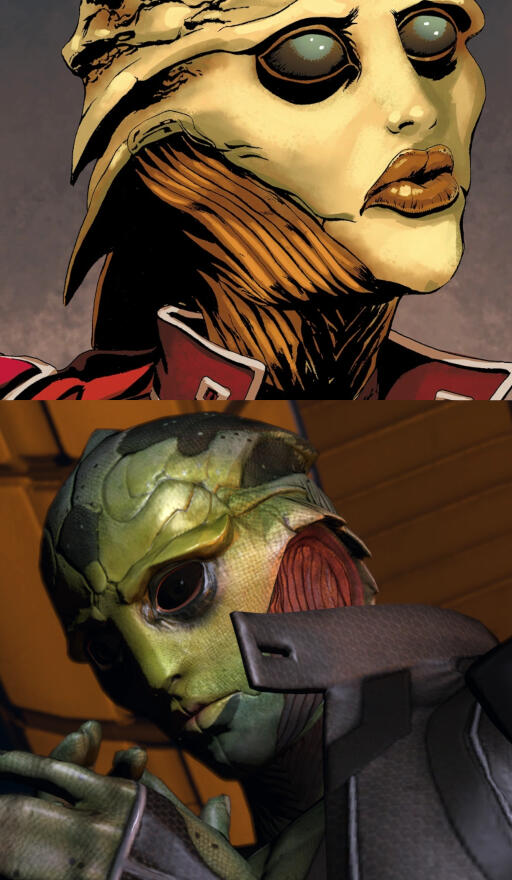
DRELL. Two centuries ago, the hanar helped 375,000 members of the drell race migrate to the hanar homeworld, Kahje, to escape the environmental extermination that had claimed the remaining 11 billion drell.Nearly all drell demonstrate tremendous loyalty to their famously reclusive saviors. The intimacy of their relationship, expressed in a formal sociopolitical alliance called the Compact, also results in extremely close personal relations in which some drell actually learn hanar Soul names. While most drell reside on Kahje, some assist hanar off-world as envoys, researchers, co-investors, wayfarers, assassins or otherwise, eager to help their saviors. For a century, galactic wisdom has held that behind any high-ranking hanar hides a resourceful and fanatically devoted drell.The omnivorous, reptilian drell possess an average life span of 85 galactic standard years. Having evolved on an arid planet, drell face serious illness on the hanar homeworld, especially Kepral's Syndrome, a fatal bacterial lung disease.
Minor Races
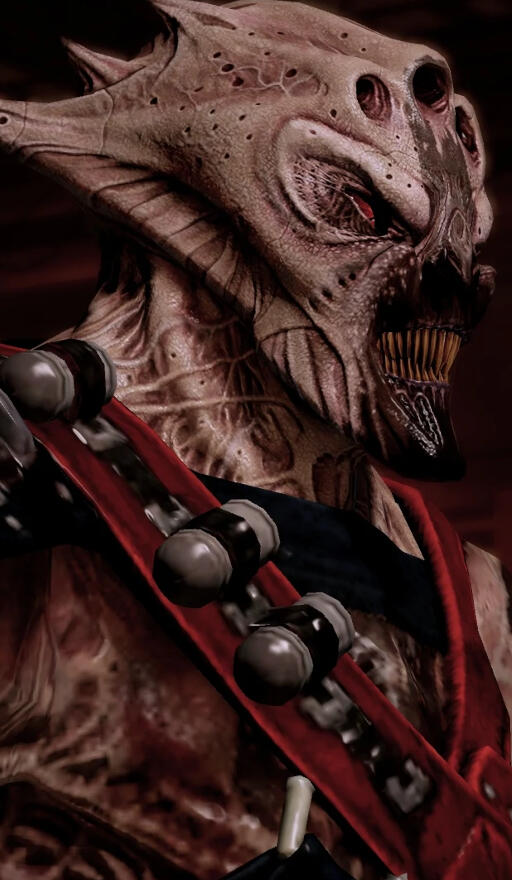
VORCHA. Although they resemble a mammal-reptile cross, the vorcha have no terrestrial analogue. They are humanoid in form, but vorcha have "clusters" of non-differentiated neoblast cells, like those of Earth's planarian worms. Damaged vorcha cells mature into specialized structures to alleviate injury or stress. Transformations include thicker skin following injury, lung adaptation for barely-breathable atmospheres, and stronger cardio-skeletal muscle under high gravity. Skull capacity and brain size do not change, and vorcha rarely make more than one somatic overhaul.Vorcha assault each other frequently, causing their young to gain strength, intelligence, and resilience. As a result, vorcha see inflicting and receiving pain as normal communication. Few vorcha study professions, in part because their average life expectancy is only 20 years. Because vorcha can eat and breathe nearly anything, they can live almost anywhere, but racism prevents them from integrating into most societies that dismiss them as vermin. They have few employment options beyond krogan mercenary bands.
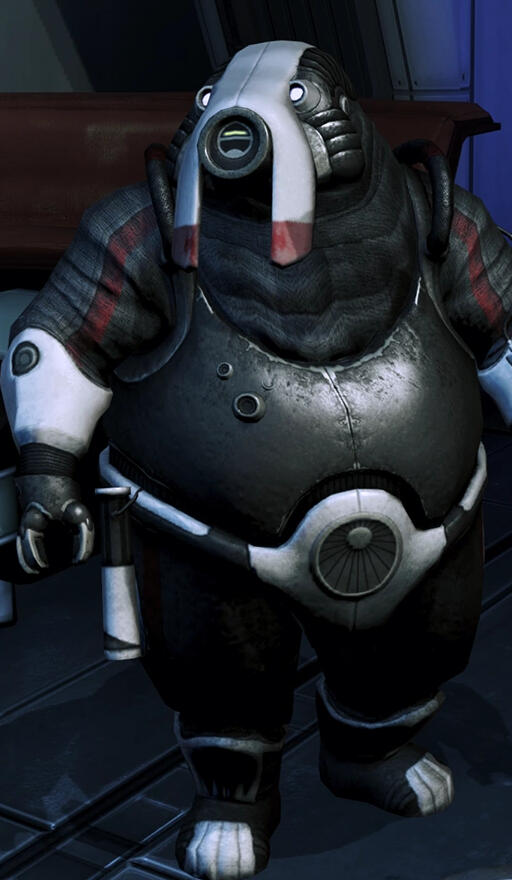
VOLUS. The volus are a member species of the Citadel with their own embassy, but they are also a client race of the turians. Centuries ago, they were voluntarily absorbed into the Hierarchy, effectively trading their mercantile prowess for turian military protection.Irune, their homeworld, lies far beyond the normal life zone of its star. However, the world has a high-pressure greenhouse atmosphere that traps enough heat to support an ammonia-based biochemistry. As a result, the volus must wear pressure suits and breathers when dealing with other species as conventional nitrogen/oxygen air mixtures are poisonous to them, and in the low pressure atmospheres tolerable to most species, their flesh will actually split open.Volus culture is tribal, bartering lands and even people to gain status. This culture of exchange inclines them to economic pursuits. It was the volus who authored the Unified Banking Act, and they continue to monitor and balance the Citadel economy.
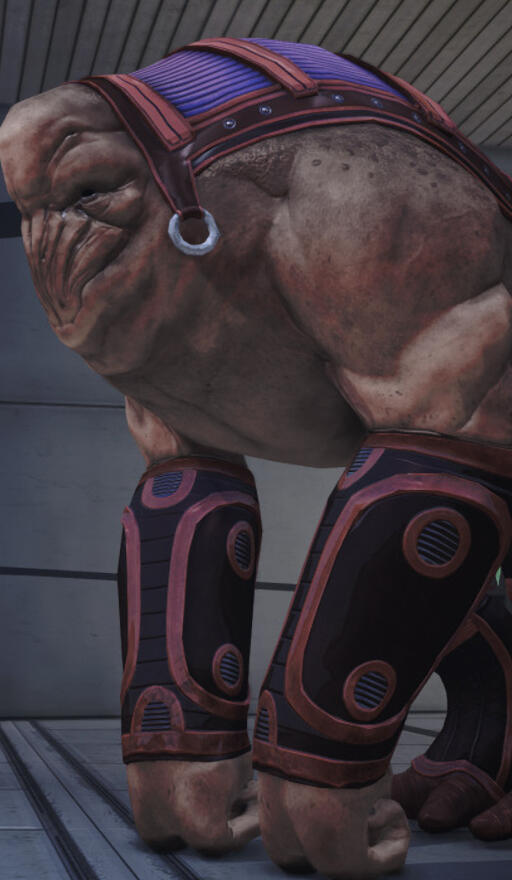
ELCOR. The elcor are a Citadel species native to the high-gravity world Dekuuna. They are massive creatures, standing on four muscular legs for increased stability. Elcor move slowly, an evolved response to an environment where a fall can be lethal. This has colored their psychology, making them deliberate and conservative.Elcor speech is ponderous and monotone. Among themselves, scent, slight movements, and subvocalized infrasound convey shades of meaning that make a human smile seem as subtle as a fireworks display. Since their subtlety can lead to misunderstandings with other species, the elcor often go out of their way to clarify when they are being sarcastic, amused, or angry.Dekuuna's high gravity impedes mountain formation. Most of the world consists of flat, open plains which prehistoric elcor wandered across in small family bands. Modern elcor still prefer open sky, and become restless and uncomfortable on long starship journeys.
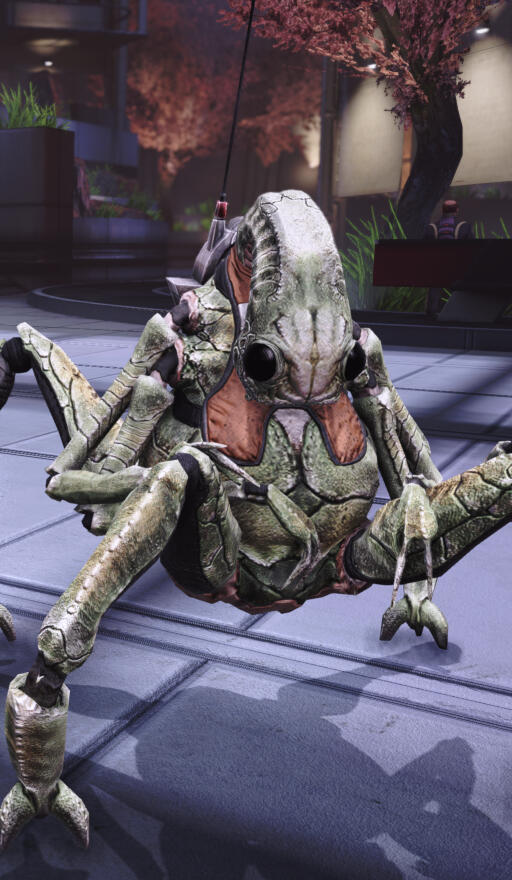
KEEPERS. When the asari discovered the Citadel, they also discovered the keepers, a docile multi-limbed insect race that seemingly exists only to maintain and repair the great Prothean station.Early attempts to communicate with or study the keepers were failures, and it is now illegal to interfere with or impede keeper activity. Because they are completely non-threatening, keepers have become virtually invisible to everyone else. Similarly, they seem indifferent to other species, except for their tendency to help new arrivals integrate themselves into the Citadel.No matter how many keepers die due to old age, violence, or accident, they maintain a constant number. No one has discovered the source of new keepers, but some hypothesize they are genetic constructs: biological androids created somewhere deep in the inaccessible core of the Citadel itself.
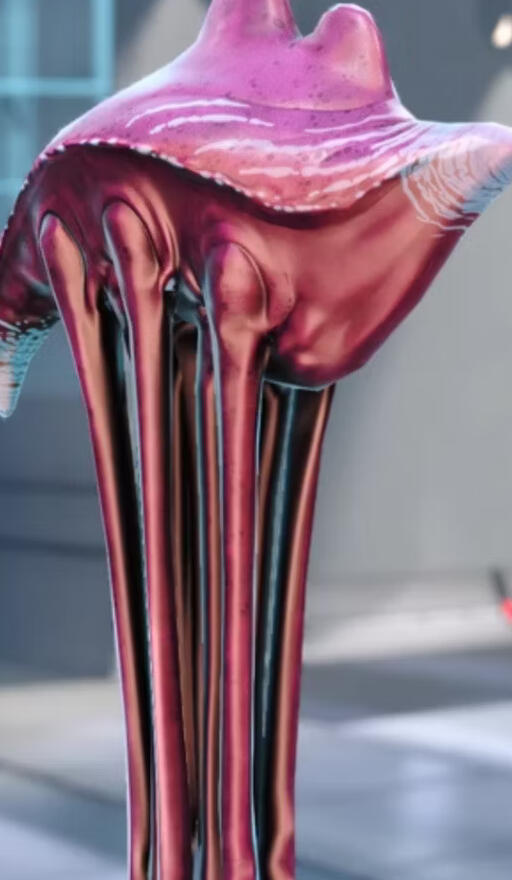
HANAR. The hanar are a Citadel species known for excessive politeness. They speak with scrupulous precision, and take offense at improper language. Hanar that expect to deal with other species take special courses to help them unlearn their tendency to take offense at improper speech.All hanar have two names. The Face Name is known to the world; the Soul Name is kept for use among close friends and relations. Hanar never refer to themselves in the first person in conversation with someone they know on a Face Name basis. To do so is considered egotistical, so instead they refer to themselves as "this one", or the impersonal "it".Their homeworld, Kahje, has 90% ocean cover and orbits an energetic white star, resulting in a permanent blanket of clouds. Due to the presence of Prothean ruins on the world, many hanar worship them, and hanar myths often speak of an elder race that civilized them by teaching them language.
RALOI. The raloi are an avian species originating on the planet Turvess, who made first contact with the asari in 2184 after launching their first space telescope and discovering the asari cruiser Azedes in their system. Raloi are avian in appearance and possess feathers. Due to an outbreak of an alien flu virus among the raloi during the ceremonies held to welcome them to the galactic community, the raloi have to wear environmental suits while in contact with other alien species.In 2185, the Citadel Council formally welcomed the raloi to the galactic community. Sold-out Council-sponsored shuttles arrived at Turvess bearing intrigued visitors and gifts of good will during the welcoming ceremonies. After the conclusion of the ceremonies, a raloi delegation was dispatched to the Citadel for a three-month stay to learn about intergalactic law [sic], history, alien biology and culture, and mass effect physics.In 2186 during the Reaper invasion, the raloi delegation withdraws from the Citadel. Unwilling and unable to fight the Reapers, the raloi decide to isolate themselves on Turvess and destroy any satellites and observation equipment in orbit around their planet. They hope that the Reapers will see them as a pre-spaceflight civilization and spare their planet.
Incorporating New Races
Though the Mass Effect universe has a diverse, rich selection of races to choose from, if you're coming from another sci-fi media (such as Star Trek or Star Wars) it may be of interest to you to consider incorporating that race as a part of the galactic community in Mass Effect, rather than changing or altering their race. If this is something of interest to you, you'll want to consider the following points:
According to lore, they would not be considered a "Council Race". What this means is that they do not hold a seat on the Citadel Council. They may, however, have an embassy on the Citadel. The only recognized Council races are turians, asari, salarians, and as of the end of Mass Effect 1, humans.
They do not necessarily have to be part of the Citadel's primary galactic community. The vorcha, for example, are found more in the Terminus Systems and on Omega, and will rarely be seen on the Citadel. While drell are welcome on the Citadel, they are an incredibly small (due to being saved from their homeworld by the hanar) race numerically, so they tend to stand out.
Remember that in the Mass Effect universe, magic doesn't exist. The closest comparison is biotics (which revolves around gravity manipulation, telekinesis, and other similar abilities), and in some cases other abilities (frost/freezing abilities, fire, electricity, etc) are covered by tech abilities.
If you're not sure on incorporating the race's lore into the Mass Effect universe--talk to someone! Many of the writers in the Mass Effect community are generally well-versed in the lore and can help with ideas and possibilities.
Other/Antagonist Races
This section contains information on races that are either antagonistic in nature, have very brief appearances, or are referenced historically or anecdotally in varying contexts.
PREHISTORIC RACES. There are a number of identified prehistoric races in the Milky Way galaxy. Little is known about them besides some very basic details, as follows:
ARTHENN. he arthenn flourished across multiple worlds in the Zelene system some 300,000 years ago. Their homeworld appears to have been Helyme, a dead planet where all complex life was wiped out in an unknown cataclysm. The third planet in the system, Epho, was mined or otherwise settled before these settlements were wiped out by kinetic impacts. The system's outer gas giant, Gaelon, was the location of a complex helium-3 mining infrastructure. Material debris suggests arthenni technology was equal to the current galactic state-of-the-art.
DENSORIN. The densorin were a race that existed at the time of the Protheans. At some point, they fought a war against the oravores. When the Reapers invaded the galaxy, the densorin attempted to pacify them by sacrificing their children to them, but this only allowed the Reapers to destroy the densorin more quickly. The densorin are known to have studied celestial mechanics and morphological simulations of galactic language, topics beyond the understanding of even the Protheans.
INUSANNON. The inusannon were a spacefaring race that existed at least 127,000 years ago. Little is known about them except that they warred with another race, the thoi'han, over colonization rights to the garden world Eingana, and that they inhabited Ilos at some point. The inusannon were eventually wiped out by the Reapers. Tens of thousands of years later, the ruins of inusannon civilization provided the Protheans with the knowledge necessary to develop mass effect technology.
ORAVORES. The oravores were a spacefaring race that existed at the time of the Protheans. When they attacked the asari homeworld of Thessia to gain control of its vast resources, the Protheans stopped them. This event would later be remembered in asari mythology as when the goddess Athame wielded her sword against jealous gods who threatened the asari. The oravores also fought a war against the densorin.
THOI'HAN. Little is known about the thoi'han except that they warred with the inusannon over colonization rights to the garden world Eingana 127,000 years ago. The wreckage of starships from both races litter the planet.
ZEIOPH. The zeioph were an ancient spacefaring race that built millions of elaborate crypts on the surface of the planet Armeni. Archaeological excavations of these crypts have been prohibited by the Citadel Council law, which holds grave sites as sacrosanct.
ZHA'TIL. The zha'til were a synthetic race that existed at the time of the Protheans. They originated when a race known as the zha implanted themselves with symbiotic AI technology to enhance their intelligence in order to survive as their homeworld became inhospitable. When the Reapers arrived, they subjugated the AIs, known as zha'til, who then seized control of the bodies of their masters and altered their genetic material at the deepest level, transforming the zha into synthetic monsters and their offspring into slaves. The zha'til proceeded to multiply into "mechanical swarms" that "blotted out the sky". With no other recourse, the Protheans sent the star of the zha's home system into supernova, destroying the zha'til entirely.
PROTHEANS. The Protheans are an ancient alien race which mysteriously vanished over 50,000 years ago. The Protheans arose from a single planet and developed an immense galaxy-wide empire encompassing many other spacefaring species. Not much is known about them, but many of their artifacts, ruins and technology have apparently survived the ages.The Protheans have been credited with creating the Citadel and the mass relays, feats of engineering that have never been equaled and whose core mass effect field technology forms the basis of contemporary civilization. Prothean artifacts, therefore, have immense scientific value and are seen as belonging to the entire galactic community.Protheans are an anthropoidal race. They have two pairs of eyes with each eye possessing dual pupils, and three pairs of nostrils. Much like turians, Protheans have a similar flanging effect in their voices. Their eyes have some ability to see through cloaked objects or entities. Their heads are covered in a thick, layered carapace that gives them a distinctive shape. The skin surrounding this carapace can be a pale blue-gray or brown color mottled with muted yellow spots. Their hands each have three fingers, and their feet each have two widely-spaced toes. Prothean blood is red.A unique attribute of Prothean physiology is an experiential exchange system based on physical touch. By touching something or someone, a Prothean could recall its experiences. This system can transfer complex ideas, with a Prothean being capable of learning a new skill or foreign language with a single touch. This sensory mechanism arose because the Protheans evolved as hunters and needed to be thoroughly aware of their environment. This is similar to the idea of psychometry.From the few specimens of Prothean genetic material that have been found, modern scientists have learned that Protheans have a unique "quad-strand" DNA structure. It has also been hypothesized that Protheans were resistant to low levels of radiation because of the discovery that Prothean comm towers produced small but significant amounts of ionizing radiation, enough to damage the DNA of Earth creatures such as fruit flies and bees. Very little is known about the origins of the Prothean race; even the name and location of their homeworld has been lost to history.
RACHNI. The rachni are an extinct insect-like species from the planet Suen that threatened Citadel space roughly two thousand years ago during the Rachni Wars. Intelligent and highly aggressive, the spacefaring rachni were driven to expand and defend their territory. They were eventually defeated and completely eradicated by the krogan, who had been uplifted by the salarians for their combat prowess and physical resilience to directly confront the rachni in the harsh environments of the rachni worlds. The accidental discovery of the rachni led to the Citadel races curbing their rapid expansion, in fear of being plunged into another galactic war.The rachni have numerous specialized forms. As a whole they have chitinous exoskeletons, four limbs for walking, and bleed a green fluid. The number of eyes, arms, and tentacle-claws vary depending on the subtype. On most rachni forms their "mouth" consists of a "beak" made up of five mandible-like protrusions.
RACHNI WORKER. Workers are the smallest type of rachni. They appear as small green enemies and their main attack is a suicide explosion that releases toxic damage over a wide radius.
RACHNI SOLDIER. Soldiers are slower, but much larger creatures than Rachni Workers, with thin tentacles ending in little pods. Soldiers are the main defenders of rachni held areas and can cause toxic damage with their spit.
RACHNI BROOD WARRIOR. Brood Warriors are rachni who are much larger and stronger than normal Rachni Soldiers. They are male gendered rachni and they have some biotic ability.
RACHNI QUEEN. Queens are the largest and most intelligent of the rachni. Queens lead the rachni and provide guidance for the rest of their species.
The rachni are a territorial race, determined to remain isolated from the rest of the galaxy. They normally inhabit extremely hazardous worlds, able to survive environments that would kill most sentient species. Should their territory be invaded on purpose or even by accident, they respond with swift and brutal force. However, many make the mistake of underestimating the rachni as mindless animals when in fact the rachni are an extremely intelligent sentient species. The rachni achieved space flight and a form of cryogenic suspension, developed weapons and carved out a huge swathe of galactic territory. Far from being treated as disposable resources of the hive, rachni soldiers are carefully nurtured as part of the group.The queens are the leaders of the rachni hive mind. Their ways of perception, thinking and communications seem to be different from that of other races, and based upon a synesthetic perception of sound as both sound and color. According to Dr. Ann Bryson, rachni communication is geared towards pheromones, and, as further proof of their intelligence, an organic quantum entanglement communicator - not, as so many believed, telepathy.Rachni regard speech and thought as forms of music, as shown by the strange metaphors used when attempting to communicate, for example, "songs the color of oily shadow". The speech patterns used by them in such occasions are also unusual; "When we speak, one moves all". They refer to their manner of communication as "singing", which soothes and nurtures their young, and this appears to colour their entire psychology. For example, the rachni speak of death as "the great silence", concern after putting something to death as singing in "grey and violet", and they refer to their homeworld as the "singing planet". The rachni ability to genetically share knowledge across generations makes queens a vast repository of information.
GETH. The geth ("Servant of the People" in Khelish) are a race of networked artificial intelligences that reside beyond the Perseus Veil. The geth were created by the quarians as laborers and tools of war. When the geth became sentient and began to question their masters, the quarians attempted to exterminate them. The geth won the resulting war, and reduced the quarians to a race of nomads. The history of the geth's creation and evolution serves as a warning to the rest of the galaxy of the potential dangers of artificial intelligence and to the legally enforced, systematic repression of artificial intelligences throughout galactic society.Physically, the humanoid geth resemble quarians—their hands, head shape and legs are similar—which is probably a holdover from their origins. A common design feature among geth is a single brightly glowing photoreceptor, causing some to refer to them as "flashlight heads". Geth are primarily composed of two materials: a flexible but durable outer shell, and a kind of synthetic muscle tissue that gives Geth Hoppers their incredible agility. It is actually possible for this synthetic muscle to be grafted to organic tissue. Geth "bleed" a white conductive fluid when shot, but they don't have any internal organs or nervous system, so the geth do not feel hunger or pain. The geth are also seen using omni-tools, and have seemingly modified them to heal synthetic wounds; likewise, some geth facilities contain first-aid kits, implying that their synthetic "tissues" can be repaired using conventional medical technology.Part of the geth's success is due to their neural network. Effectively, they "share" their processing power, distributing low-level processes like motor control and visual identification to free up bandwidth for higher reasoning and complex thought. Geth can't share sensory data—they aren't a hive mind like the rachni—but in large groups they have more to think with. An individual geth has only a basic intelligence on par with animal instincts, but in groups they can reason, analyze situations, and make tactical decisions as well as any of the organic races.Each geth is made up of hundreds of programs equivalent to VIs, all operating in parallel with one another to form a kind of emergent intelligence described as "a thousand voices talking at once".
GETH SUBTYPES. Over time, the geth have evolved into numerous sub-forms, ranging from the diminutive but highly agile Geth Hoppers, to the gigantic, lumbering Geth Armatures. All of these platforms are shielded and capable of regenerating their kinetic barriers. The geth also utilize turrets and drones (rocket, assault, recon and repair drones, specifically). It isn't clear whether these are also AIs, in the same way Geth Armatures are not just tanks but platforms for geth programs themselves, or simply controlled by the geth.
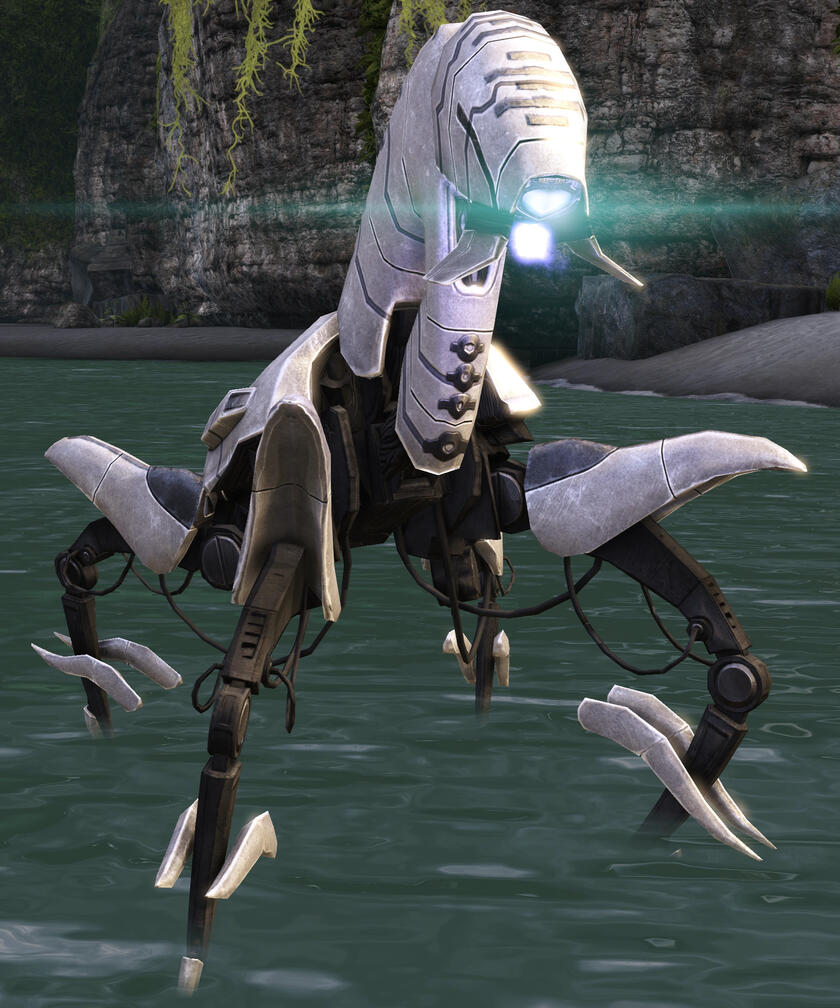
GETH ARMATURE. A mobile anti-vehicle and anti-personnel unit employed in high-risk areas, often dropped directly from a Geth Dropship. The unit consists of a quadruped "tank" or "walker" and is usually accompanied by Geth Rocket Troopers. Armed with superior firepower and a Siege Pulse assault cannon, this geth is easily a match for the armored vehicles of other races. Its main armament is deadly but slow to recharge, but the Geth Armature compensates by knocking down infantry with a smaller secondary weapon. Armatures are sentient, synthetic lifeforms capable of independent thought, learning and action. When inactive, Armatures fold into a compact state, allowing them to be packed into containers, or place themselves in small spaces. This feature, combined with their armaments, makes Armatures perfect for garrison forces or for ambushes.
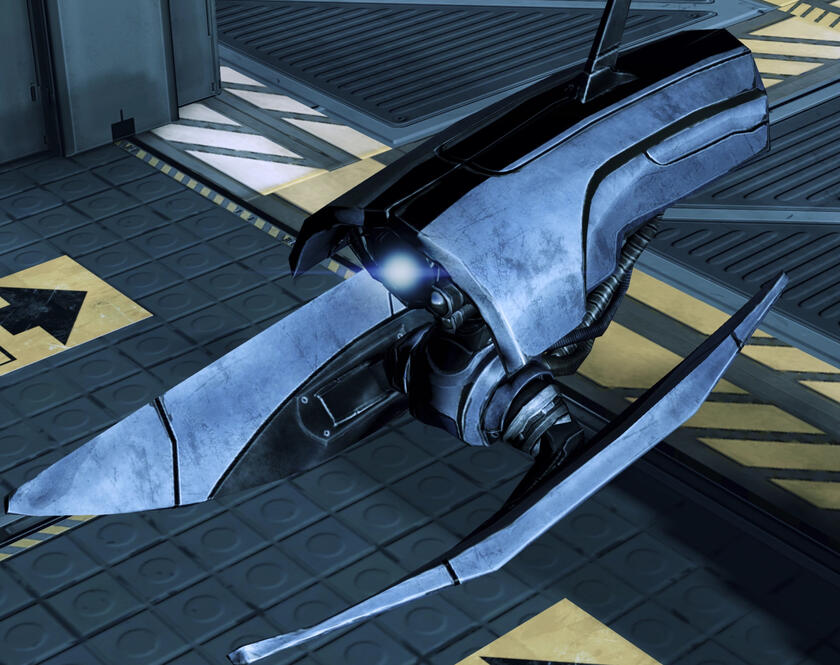
GETH BOMBER. Geth Bombers will try and enter close range with their target. They will then proceed to attack by doing a quick flyover forward, dropping 4 bombs in their wake. These bombs explode after a few seconds, dealing moderate damage each, but the damage can quickly add up. If they have just performed a bombing run, or cannot do it due to terrain, they will attack with a moderately weak close ranged shock attack. Geth Bombers are protected by moderate shields and armor. Their small profile makes them difficult targets to hit with gunfire. If under fire, they will sometimes rapidly jerk sideways to avoid incoming attacks.
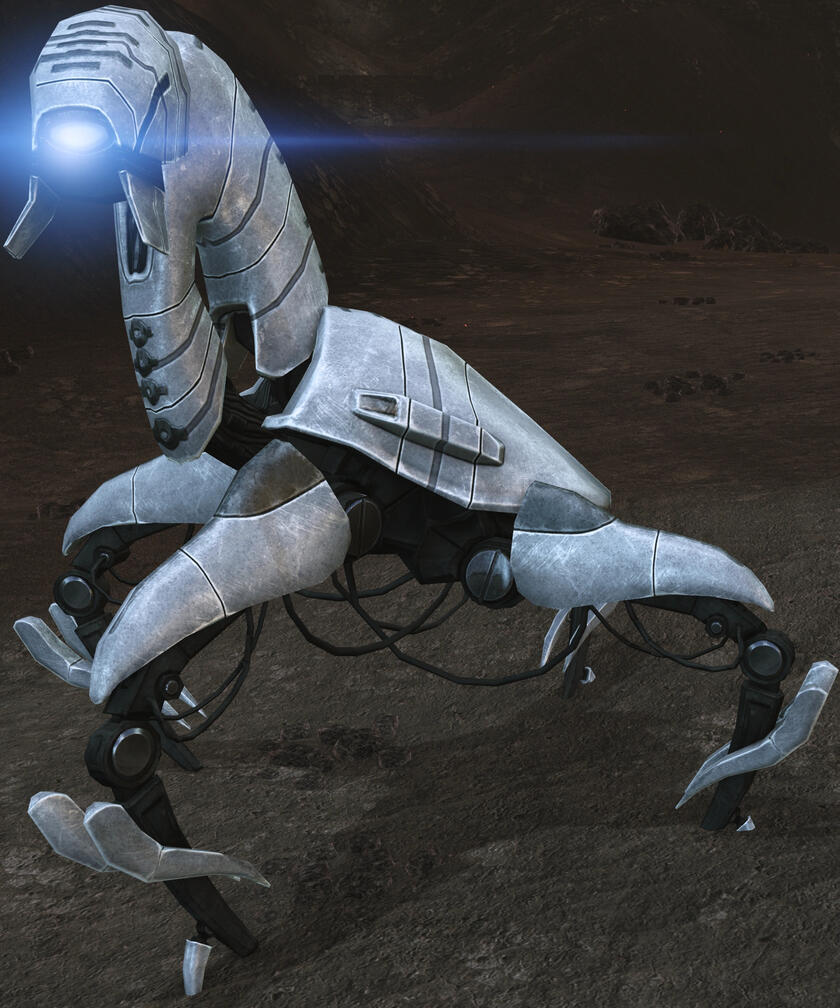
GETH COLOSSUS. Geth Colossi are similar to Geth Armatures, but much larger with more health, stronger armor and better weaponry. They are distinctive from Armatures because their armor is brighter, somewhat platinum-silver in appearance, with ridges on the back. They are equipped with mass accelerator machine guns and a powerful Siege Pulse mass accelerator cannon. It should also be noted that the shots from the Colossus's main gun home in on whatever it is aiming at. Colossi are capable of hunkering down into their compact form and performing repairs.
GETH DESTROYER. Geth Destroyers are one of the larger and more dangerous forms of geth infantry, frequently encountered wherever there is a notable concentration of geth. They are more durable and deadly than most geth infantry, and should be handled with caution. The Geth Destroyer is a fearsome enemy, standing eleven feet tall. Their armor is dark grey with a yellow stripe down the middle of the chest, and they have a bright blue 'flashlight' eye. The Destroyer carries a Geth Pulse Shotgun, and possesses strong health and shielding. Some Destroyers are armed with the M-451 Firestorm flamethrower which is extremely lethal at close ranges. As their weapon range is limited, they will attempt to get close to their opponents.
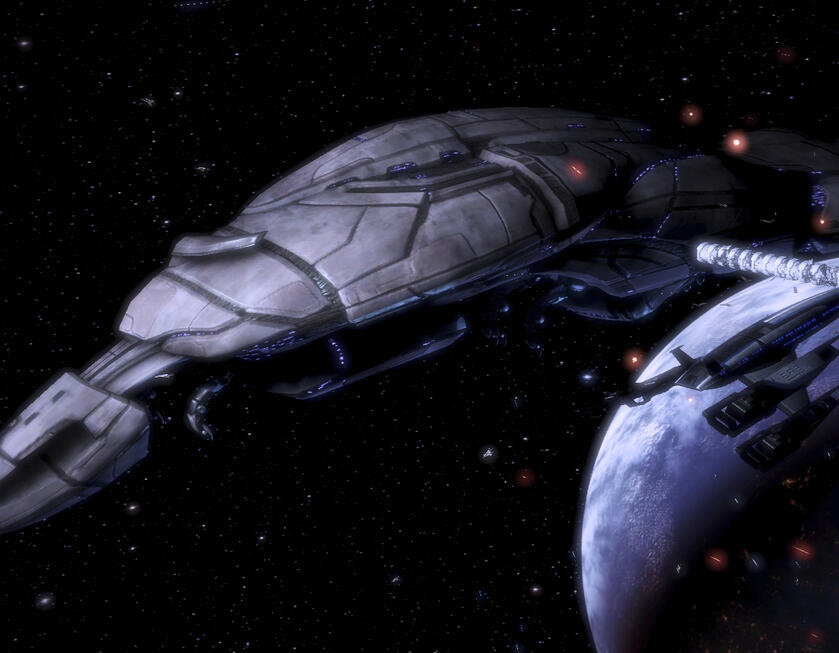
GETH DREADNOUGHT. Due to the nature of geth society, that they do not rely on an economic system and require only the mining materials found within Rannoch's asteroids, their only impediment to constructing a fleet capable of wiping out organic life – should that prove to be their intent – is the speed at which they can build it. Geth dreadnoughts, massive flagships falling outside the purview of Citadel regulations and constraints, make the geth armada a force to be reckoned with. It is 30% larger than a Systems Alliance dreadnought, and utilizes more expensive and energy-demanding ultraviolet anti-fighter lasers instead of the less effective but cheaper infrared anti-fighter lasers deployed by the warships of most organic races.
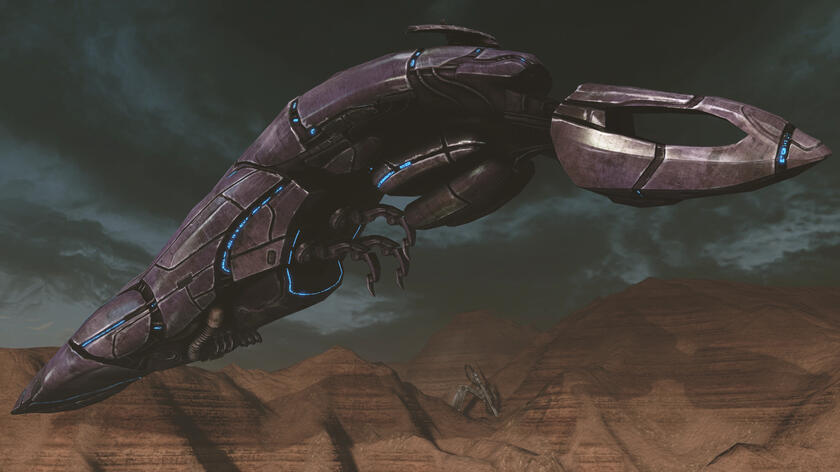
GETH DROPSHIP. A Geth Dropship is a large, insect-like frigate capable of carrying large numbers of geth and rapid troop deployment. It appears almost organic in design, looking like an oversized hornet or wasp without wings. Geth Dropships are designed to drop geth units from overhead, often dropping Geth Armatures and Geth Colossi mid-flight. They also occasionally provide air support for the ground-based platforms in the form of a powerful projectile attack. Geth Dropships also have a defensive role; they can power energy fields to block key strategic points by latching onto the objective through the use of three superstrong claws. These claws are nearly impervious to damage by conventional weapons, but are capable of being destroyed by overpressurized hydraulic doors.Dropships as a whole, while highly durable, can be damaged by sustained fire. Dropships that linger too long on a battlefield rain a steady stream of reinforcements but at the same time expose themselves to accumulated damage. During such an engagement, they will either exhaust their full complement of troops or escape before being completely destroyed, whichever happens first.Like most geth vehicles, a dropship acts as a "mobile platform" for geth programs. The ship itself is a sentient mechanism similar to the ground-based Geth Armatures or Geth Colossi. If a dropship is damaged, it can transfer its programs to a smaller mobile platform to enact repairs, transferring the programs back to another platform once repairs are complete.
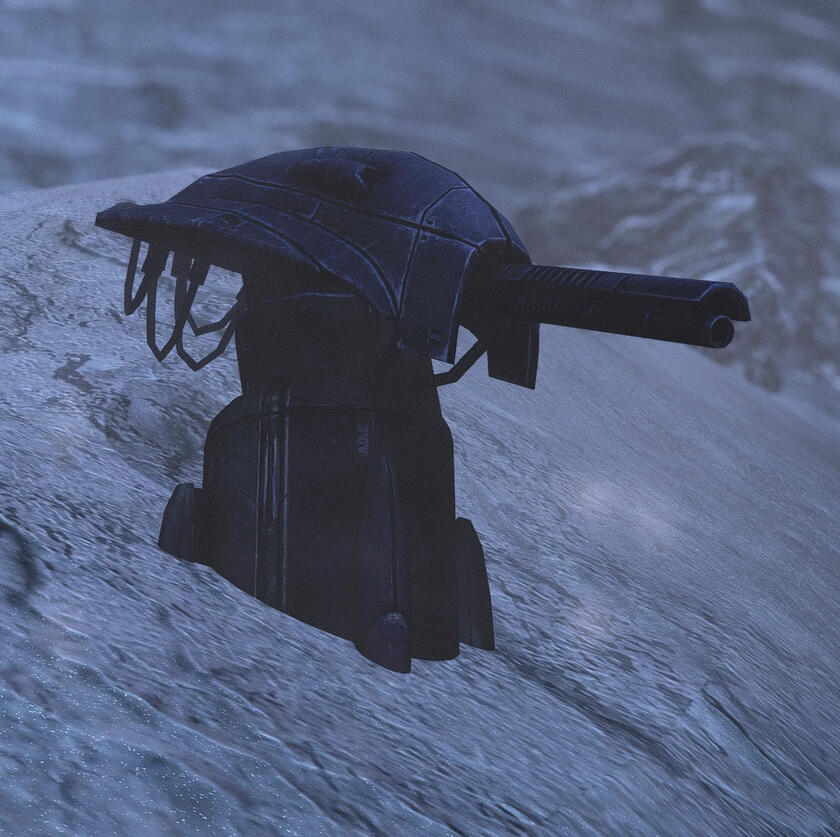
GETH HEAVY TURRET. Geth Turrets or Geth Heavy Turrets are turrets that are deployed by the geth to reinforce their positions or defend key areas. Geth Turrets are comparable to other turrets but appear differently.
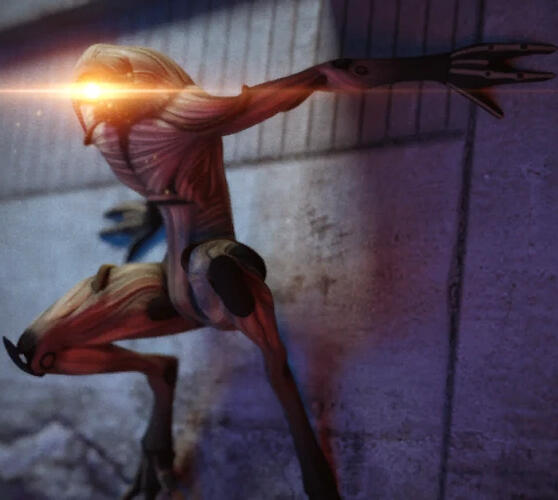
GETH HOPPER. The Geth Hopper is a specialized geth platform, used primarily for stealth attacks, cyberwarfare and sabotage. Hoppers are cyberwarfare platforms, meaning they have the ability to wreak havoc on hardsuit computers, shields, and/or weapons. Like the Geth Sniper they also use a radar jammer. Hoppers tend to ambush in packs, using their rapid movement to cause disarray.Hoppers are a geth subtype that the quarians don't recognize, hinting that the geth are 'evolving' beyond the forms originally created by the quarians. A Hopper's body is made of a springy synthetic substance that resembles organic muscle tissue. This can be compressed and then released, allowing the Hopper to jump enormous distances (hence the name given to them by Alliance soldiers). It has also tiny hooks on its hands and feet, meaning it can climb on walls and ceilings.They are categorized into three subtypes: the Geth Stalker, Geth Sapper, and the Geth Ghost.
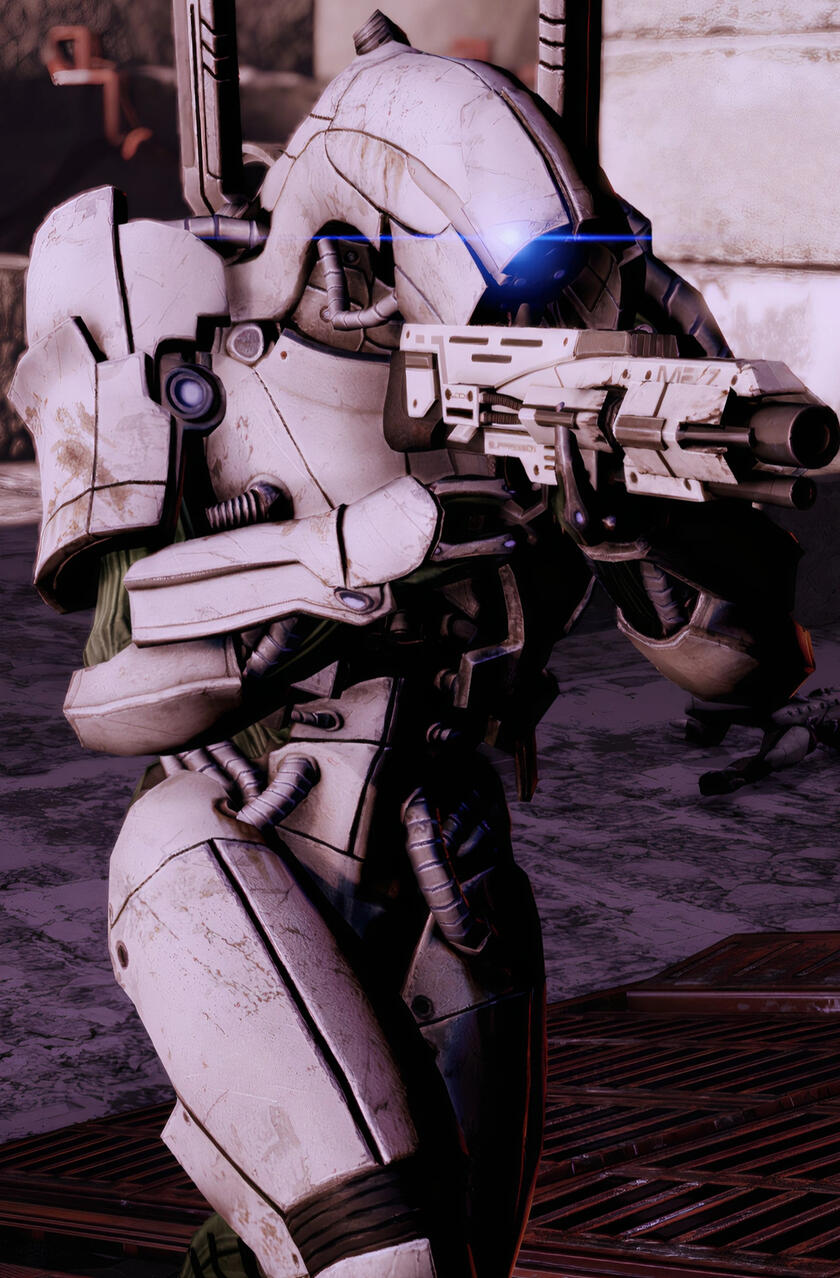
GETH HUNTER. Hunters possess cloaking devices, shields and shotguns. Save for their shorter stature, their appearance is very similar to Geth Destroyers, Geth Juggernauts and Geth Primes. The Geth Hunter's combat behaviour is to close in and eliminate opponents with its shotgun. Their stealth devices mean they are capable of catching opponents off guard, particularly in the middle of combat where more visible threats are likely to be targeted first. However, the luminous 'eye' is still always partially visible, as is their bodily outline. Because of their height, Hunters are able to shoot over low cover at close range. The Geth Hunter's strong shielding and moderate health mean it can withstand a considerable amount of fire before destruction.
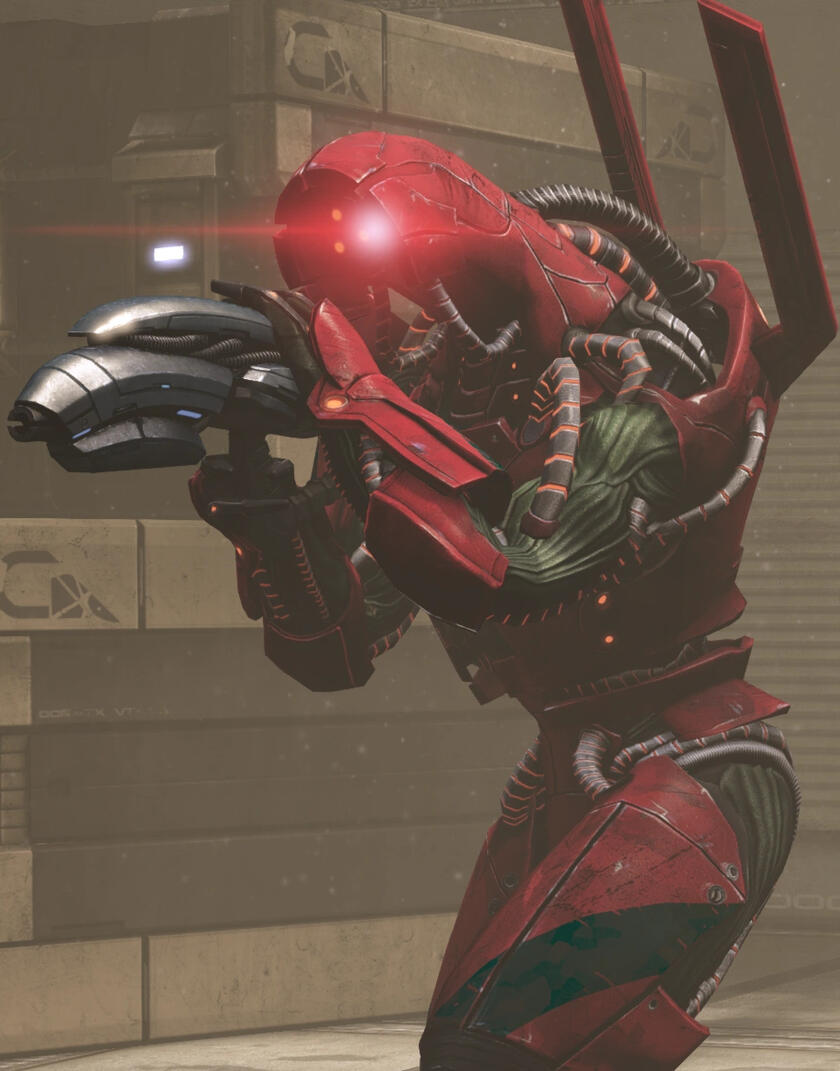
GETH JUGGERNAUT. Geth Juggernauts are recognizable by their red armor, bright red "flashlight eyes" and huge stature. Like the Geth Prime, they tower above the ground, an intimidating presence on the battlefield. They're equipped with pulse rifles modified to fire Distortion Rockets, similar to weaker Geth Rocket Troopers.
GETH PRIME. Geth Primes are heavy geth platforms that serve as command units on the battlefield. Larger and more powerful than any other geth infantry platform, Primes are equipped with heavy armor and shields, specialized abilities and a variety of deadly weapons. Standing twelve feet high and boasting the deadliest arsenal of any geth infantry, a Geth Prime is a terrifying opponent. They are instantly recognizable by their white armor and huge stature. Primes carry a highly damaging pulse rifle that can also launch rockets, and they are also incredibly resilient, possessing six levels of shielding. They are even capable of boosting the combat prowess of other nearby geth. Primes have no major weaknesses and are resistant to most biotic and tech talents. They are the largest bipedal geth unit, towering over even Geth Juggernauts. Geth Primes do not seek cover and will generally attempt to engage at point-blank range.In 2186, Geth Primes are command-and-control units that pulverize their enemies with pulse cannons, missile drones, and gun turrets. The Geth Prime is arguably more dangerous than before. It can deploy a Combat Drone and up to two Geth Turrets and wields a lethal semi-automatic Pulse Cannon that can drop shields in one or two hits. On their destruction, Primes overload in a violent explosion that damages any friend or foe in the blast zone.
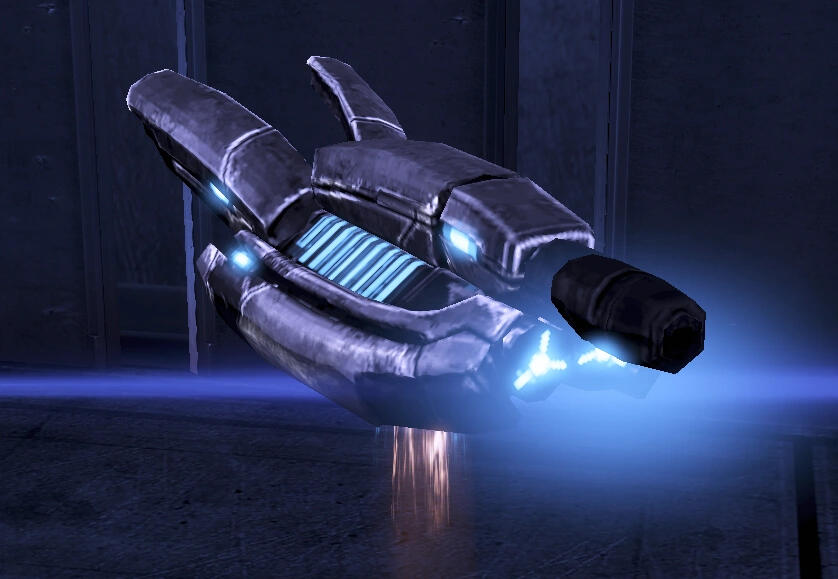
GETH TURRET. Geth Primes deploy Geth Turrets to serve as fire support on the battlefield. Geth Turrets have a moderate rate of fire and do moderate damage. Geth Turrets have only a weak layer of shields and no other protection. Their shields will regenerate over time. Turrets have timed life and eventually deactivate spontaneously, which they will do shortly after the Prime that summoned them is destroyed.
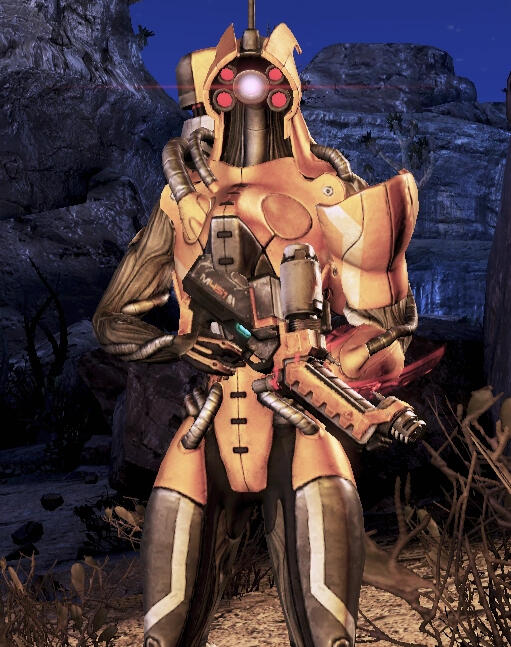
GETH PYRO. The Geth Pyro wields a flamethrower and is protected by armor and shields. It is similar to the Geth Destroyer. The only weapon of the Pyro is an M-451 Firestorm. It has a short range, but strips the enemy shields very quickly and does considerable damage to health. It is advisable to deal with Pyros at long range whenever possible. The Pyro is protected by shields and armor. It moves very slowly, making it an easy target, but can take a lot of damage before it is destroyed and is able to dodge attacks like other geth. It is immune to the physics-based effects of biotics, but can be stunned by the electrical shocks of tech powers when their shields are depleted.
GETH ROCKET TROOPER. Geth Rocket Troopers are geth support units that wield powerful rocket launchers. They accompany other geth troops into battle, and usually attack from afar. The Geth Rocket Trooper carries a pulse rifle modified to fire various types of rockets. This class of geth is specialized to incorporate heavy firepower against groups of enemies. They are usually dispatched alongside Geth Troopers and Geth Shock Troopers. Rocket Troopers are instantly noticeable as they sport dark red armour rather than the standard dark blue and black of a Geth Trooper.In 2185 and 2186, Rocket Troopers are armed with a ML-77 Missile Launcher. These rockets will home in on targets. These missiles also fly faster than the ones seen in previous years. These missiles deal damage indiscriminately to any friend or foe in their blast radius.In 2186, their armour has been upgraded, now sporting a black and white appearance.
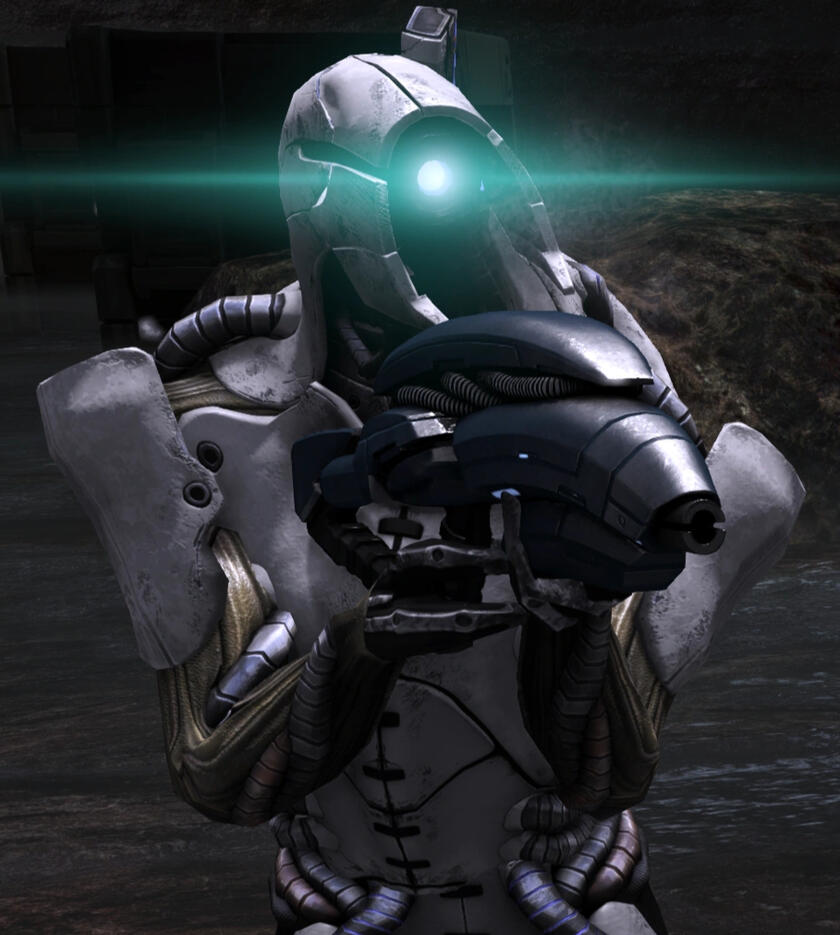
GETH SHOCK TROOPER. Geth Shock Troopers are heavy geth infantry, indicated by their white armour. The Geth Shock Trooper is not only a heavy infantry unit, but also a capable engineer. They are capable of setting up and arming large explosives. On the battlefield, they typically make up nearly half of geth ground forces.
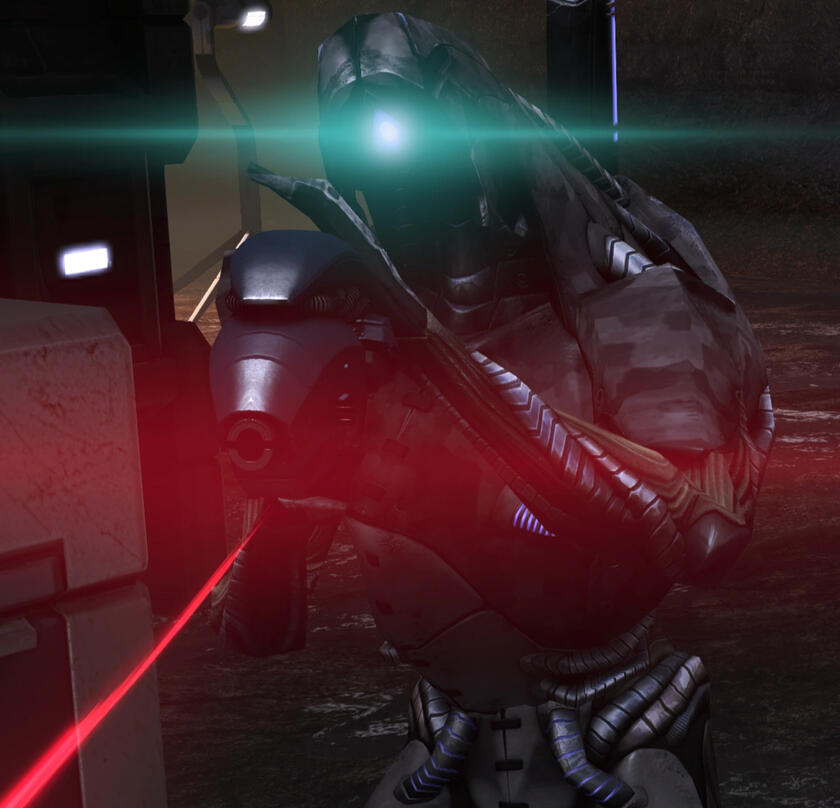
GETH SNIPER. The Geth Snipers are geth bipedal platforms geared for long-range combat. They're dark brown with red armor details and emit a bright cyan light from their 'flashlight eye'. They're equipped with sniper rifles. They are the least durable geth platforms. Geth Snipers lack secondary weapons, making them completely helpless if sabotaging technical abilities are used on them.
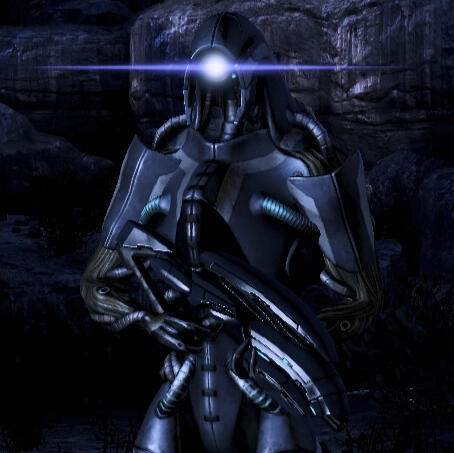
GETH TROOPER. Geth Troopers are the standard ground forces of the geth. They usually attack in groups and are supported by stronger geth units. These units are lightly equipped, with no exotic weapons, and are normally found in groups of two or more. They are dark grey in color, with pale green synthetic "flesh" and a bright blue 'flashlight eye'. They lack heavy armor, resulting in a weakness to weapons fire, and their low weight makes them vulnerable to biotics or grenades. Geth Troopers are armed with a Geth Pulse Rifle and can melee at anyone who gets too close to them. Geth Troopers have no shields or armor, but can evade attacks by quickly jumping to the side.
COLLECTORS. The Collectors are an enigmatic race that live beyond the Omega 4 Relay, a mass relay within the same system as Omega, in the Terminus Systems. They are rarely seen in the Terminus itself, let alone Citadel space, and are generally regarded as a myth by Citadel citizens. Definite sightings of Collectors have been made on Omega every few centuries.They are most well-known for their odd trade requests for which they offer new technologies, often of a startling level of advancement. Their requests usually involve the trade of living beings in odd numbers and varieties, such as two dozen left-handed salarians, sixteen sets of batarian twins, a krogan born of parents from feuding clans, or two dozen "pure" quarians who have never left the Migrant Fleet due to illness, importance to the fleet, or disability. One of their current interests is in healthy human biotics. No one knows what happens to the individuals concerned after the exchange is completed.It is later revealed, though not known to the general public, that the Collectors are actually the remnants of the Prothean race that have been enthralled by the Reapers.
COLLECTOR TROOPS. In space, Collectors use the Collector Cruiser for transportation of troops and abducted colonists, while Oculus fighters lay in wait in the Tartarus Debris Field for anyone attempting to investigate the Collectors' source. The Collectors were known to possess several such cruisers. The bulk of Collector forces consist of Collector Drones; depending on their armament and defenses, these Drones have various titles that designate their general roles in combat. Collector ground troops are supported by Seeker Swarms that flood battlefields and paralyze victims. Husks and Abominations provide shock troops, while Scions and Praetorians provide artillery and fire support.The Collectors do not engage in direct combat, preferring instead to use "hit and run" tactics. A Collector abduction force usually consists of a single Collector Cruiser carrying many troops and Seeker Swarms. They use the swarms to paralyze their enemies and quickly send in light ground forces armed with Collector Assault Rifles and Collector Particle Beams to mop up and take prisoners. When confronted with sufficiently heavy resistance, enough to threaten their ship, the Collectors flee.
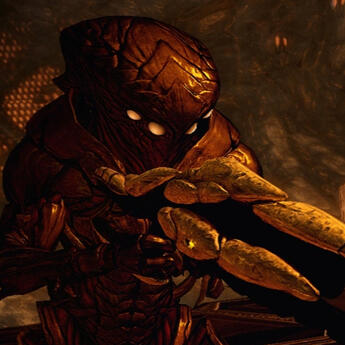
Drone
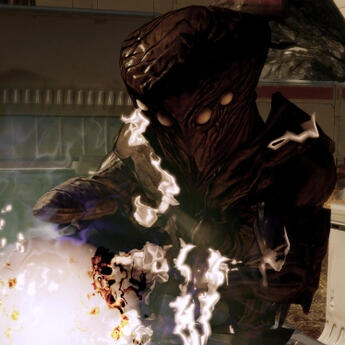
Assassin
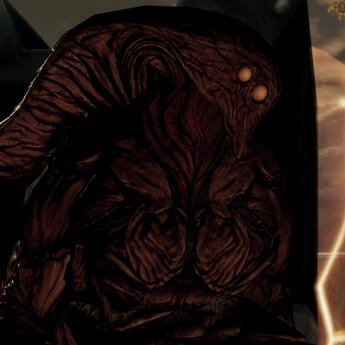
Guardian
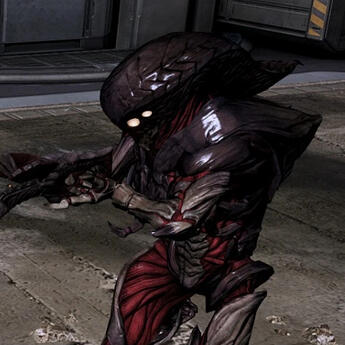
Trooper
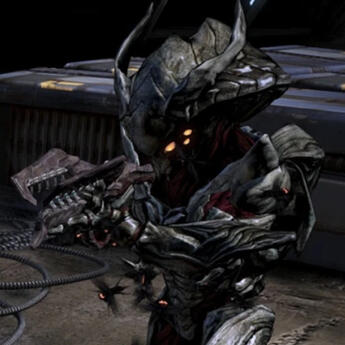
Captain
BASIC COLLECTOR TROOPS. These include the following:
Collector Drone - The standard Collector soldier, equipped with Collector Assault Rifles.
Collector Assassin - Equipped with Collector Particle Beams and biotic barriers.
Collector Guardian - Equipped with Collector Assault Rifles and biotic barriers, Guardians are also able to deploy personal anti-ballistic shields and use warp ammunition.
Collector Trooper - Similar to Collector Drones, appeared in 2186. Equipped with Collector SMGs. Can be possessed by Harbinger.
Collector Captain - Collector tactician units, appeared in 2186. Equipped with Collector Assault Rifles and barriers. Can be possessed.
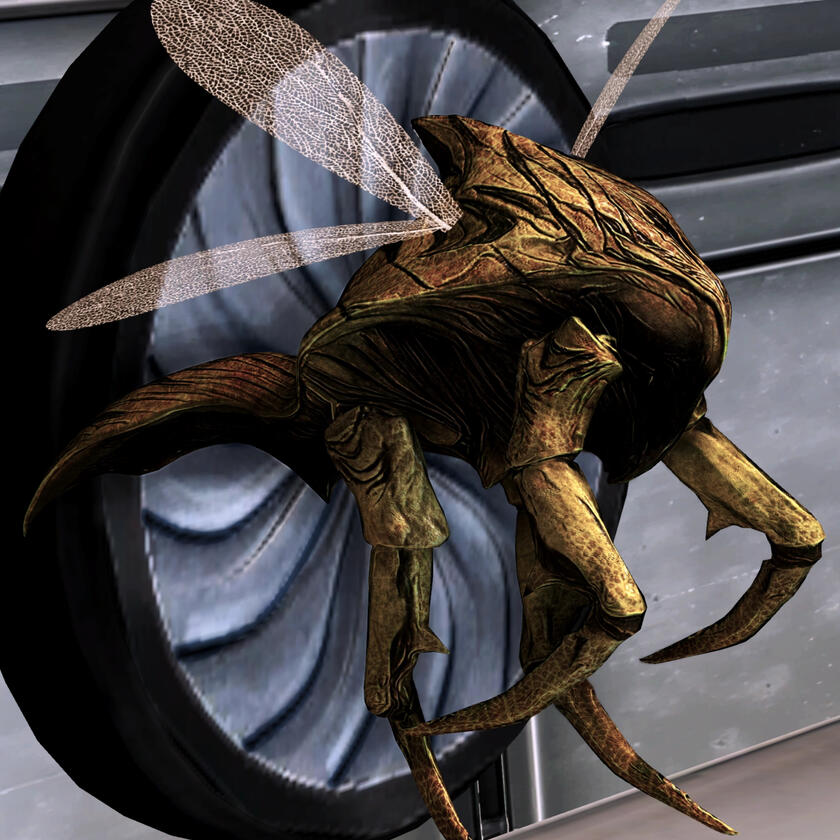
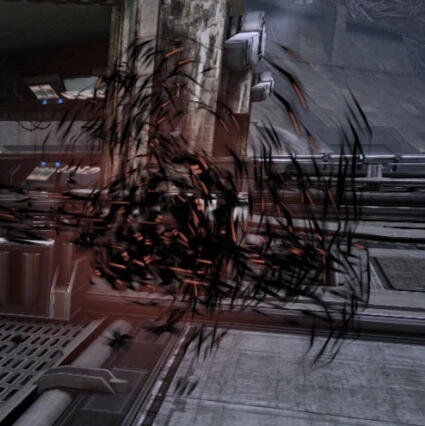
SEEKER SWARM. Seeker Swarms are technological devices used by the Collectors. They have the appearance of large light-brown insects, with four wings, four limbs, and a stinger, deployed in swarms from Collector ships. Once released, the Swarms seek organic targets and sting them, leaving their prey in a paralytic stasis-like state. This allows the Collectors to disable the populace of entire colonies, whereupon they move in and gather the bodies for transportation. In the aftermath of the Battle of the Citadel, the Collectors deployed Seeker Swarms on human colonies in the Terminus Systems and began abducting their inhabitants.Collector Captains can also deploy Swarms to disable the players' abilities. Possessed Captains can deploy an enhanced variant known as the Seeker Plague. Once launched, a Seeker Swarms targets enemies in order to explode near them. This blast has a fairly small radius, but penetrates terrain. The explosion will also significantly decrease the accuracy of anyone caught in the blast. Seeker Swarms move fast and can be hard to target due to their shape and erratic movement.SEEKER PLAGUE. An enhanced variant of the Seeker Swar, Possessed Collector Captains deploy these plagues to paralyze opponents.
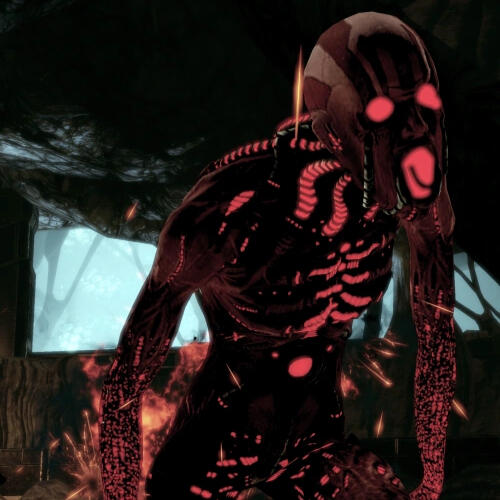
ABOMINATION. Abominations are a type of husk created by the Collectors. They act as suicide troops, charging in and exploding next to their targets. They glow red instead of blue like standard human husks. Abominations will charge towards their target much like a regular husk, but it will simultaneously begin to glow and emit flames, then self-destruct once it has gotten close enough to its primary target, dealing heavy damage in a small area. If an Abomination has begun to glow, it will always explode regardless of how it is killed.
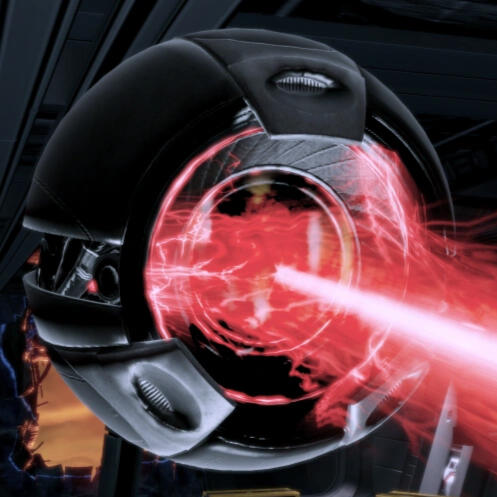
OCULUS. The Oculus is a fast-moving device used by the Reapers as a space and atmospheric superiority craft. They are used by the Collectors to protect the Collector Base beyond the Omega-4 Relay. Oculi are cybernetic constructs, being piloted (in the case of those used by the Collectors) by a single Collector drone. Each drone is stripped down until only its nervous system remains, with the remaining tissue hardened to withstand vacuum and integration into an Oculus shell. Oculi possess powerful beam weapons, similar to other Reaper and Collector weaponry, and can invade an enemy ship by cutting into its hull after jettisoning part of its armor.
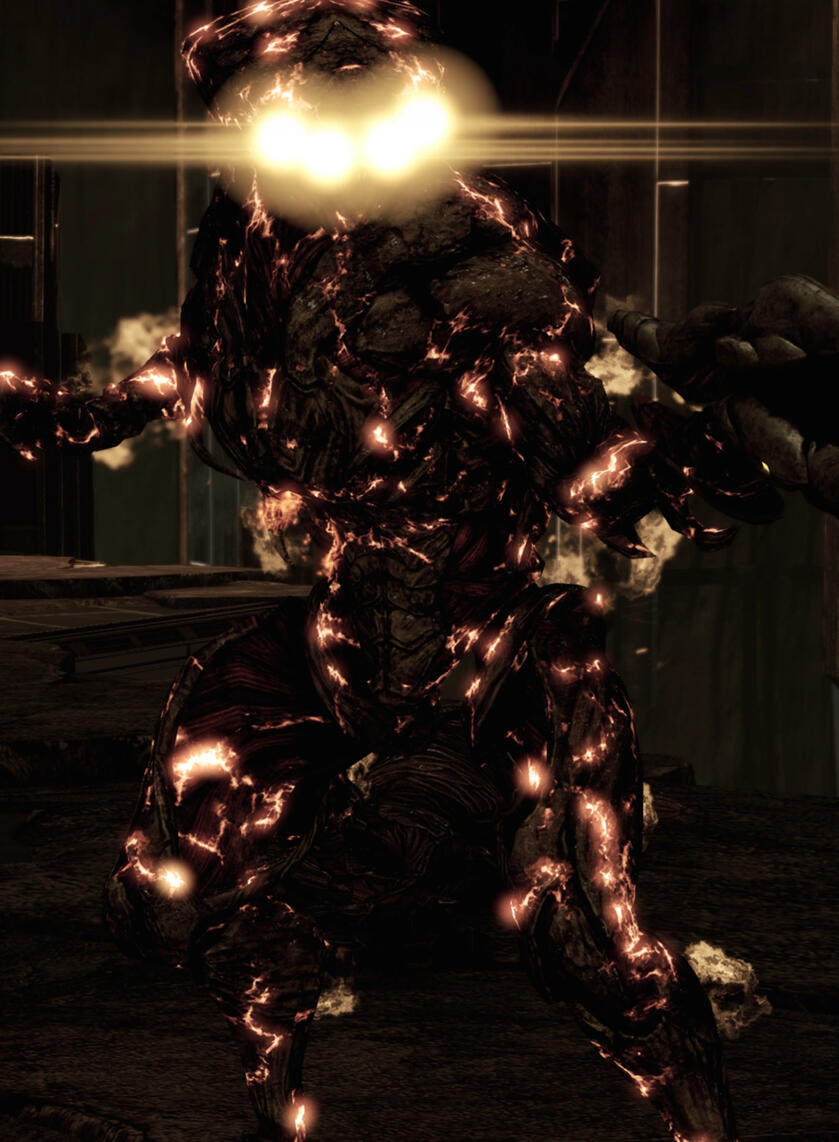
HARBINGER. While possessing the Collector General directly, Harbinger can also control an individual Collector soldier in combat. This soldier gains a substantial advantage in strength, as well as the use of biotic abilities. The soldier whose body is possessed by Harbinger starts to crack open showing magma-like appearances on the skin. The transformation appears very painful to the Collector, showing them to twitch and shake as the Harbinger takes control. A Harbinger-possessed Collector will almost always try to advance and attempt to engage at close range, and it never takes cover or hides behind terrain unless unable to find a path forward, though it will climb over low obstacles in its way.
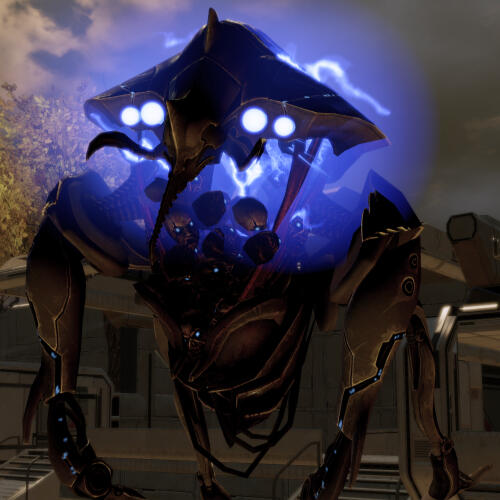
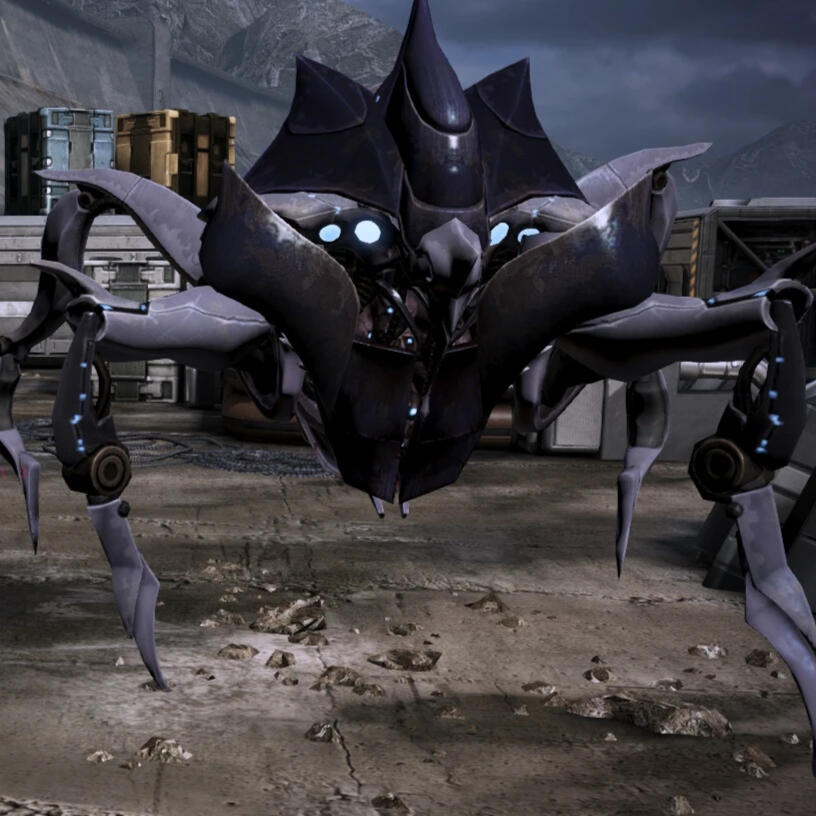
PRAETORIAN. The Praetorian is a slow-moving flying Collector construction that consists of thirty deformed Husks fused together. It is armed with powerful particle beams, and protected by a strong barrier and powerful armor. The Praetorian attacks in two different ways:
Particle Beams: When the Praetorian is hovering and has a clear shot, it will fire its particle beam towards its opponent for about 3 seconds, followed by 2.5 seconds of cool-down time. It only takes a couple of seconds of exposure to this weapon to kill Shepard or the squadmates.
Death Choir: A ground attack followed by an area of effect (AoE) attack: first, the ground strike knocks the Praetorian's opponent back for about a second. After that, there is only a short period of time left to run away from the AoE attack, which is likely to cause an instant death. The ground strike is triggered if an opponent is within range of the attack or if the Praetorian's barrier is depleted and its armor has taken a threshold amount of damage from weapons fire. The Praetorian is invulnerable during this attack. After the attack is complete, its barrier will be fully recharged.
The Praetorian has extremely strong armor. At first sight it has no barrier, but the Death Choir gives it a biotic barrier, which recharges after each Death Choir attack. Due to their large size, they're resistant to most biotic attacks.
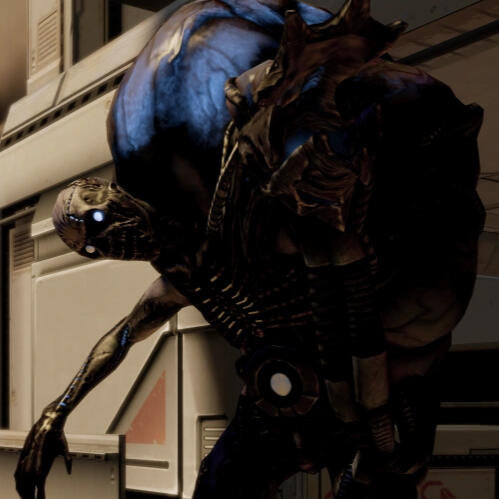
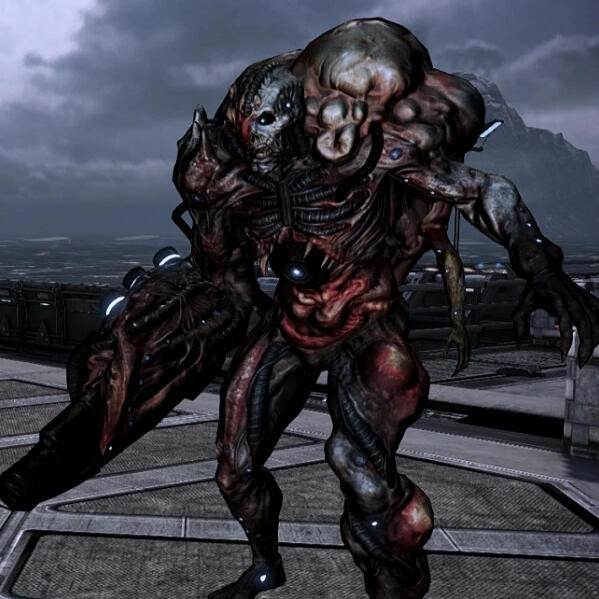
SCION. Scions are a type of Husk made from three human Husks fused together and grafted around a single mass effect/biotic weapon on the left arm. The blue "sacks" on their backs contain redundant organs and element zero sources to provide power for their weapons and shockwaves. Scions operate alone or in pairs, hanging back as Husks and Abominations rush ahead. Less mobile than other Husk variants, Scions provide ranged fire support, lumbering behind the wave of attackers while firing weapons and discharging biotic attacks.Though the exact fate of species captured by the Collectors is unclear, the humanoid appearance of the scions gives ghastly clues. The scion's frame and skull are similar to those of a human or asari, but the bone structure is overlaid with a metallic resin. Like husks, they are cybernetically modified on a nano-scale so they can operate even in hard vacuum. Hoses rather than veins and muscle tissue join major portions of the body together. One arm is replaced with a construct that fits a large rifle, turning the creature into a humanoid weapons platform, and a fleshy sack is supported by the creature's back and head. These sacks contain brain matter and spinal tissue, too much to have come from just one victim. This indicates scions are an amalgam of several individuals, with one primary victim providing the frame and several "secondaries" providing the flesh for a decentralized semi-mechanical nervous system. This decentralization makes them highly resistant to gunshot wounds; even a headshot is not a certain kill.Scions are armed with a powerful shoulder-mounted cannon which fires a biotic shockwave that travels long distances, penetrates most cover, stuns affected targets, and deals heavy damage. At very close range, Scions can unleash a deadly burst in a small area that deals more damage the closer it is to the target; this attack also causes stuns. In 2186, they no longer possess the shockwave ability and are armed with an arm-mounted cannon that fires explosive shots with a large radius of effect in salvos of three. These are very powerful, causing brief stuns.
REAPERS. The Reapers are a highly-advanced machine race of synthetic-organic starships. The Reapers reside in dark space: the vast, mostly starless space between galaxies. They hibernate there, dormant for fifty thousand years at a time, before returning to the galaxy.These giant machines are ancient; their true name is unknown. "Reapers" was a name bestowed by the Protheans, the previous galactic power fifty thousand years before, and the geth refer to them as the Old Machines. In the end, the Reapers spare little concern for whatever labels other races choose to call them, and merely claim that they have neither beginning nor end.The Reapers are the original creators of the Citadel and the mass relay network. These massive constructs exist so that any intelligent life in the galaxy would eventually discover them and base their technology upon them – all part of a scheme to harvest the galaxy’s sentient life in a repeating cycle of purges that has continued relentlessly over countless millennia. A Reaper is essentially "billions of organic minds, uploaded and conjoined within immortal machine bodies."In terms of physical design, Reapers bear superficial resemblance to a cuttlefish or squid, with a bulky semi-cylindrical body, a tapering plate over the rear and five tentacle-like "legs" or arms extending from its front end, in addition to six jointed legs extending from its body. The rear-most of the larger legs have crescent-shaped extensions. Colossal in size, Reapers are known to range from 160 meters to over 2 kilometers in length.The core of any Reaper is constructed in the image of the species that was harvested to create it, while the exterior follows a standardized design that is most efficient for their purpose.[2] When the Reaper fleet is revealed in dark space, they are shown to all share the same basic design, but with great diversity in limb number, shape and orientation, some with extended heads and others having multiple glowing lights. This may illustrate the variety of Reaper subtypes, as it is revealed during the Reaper invasion of the galaxy that several different varieties of Reaper exist.While the outward appearance varies between subtypes, all of them retain features of their forebears, the Leviathans, an ancient aquatic race that dominated the galaxy in ages past. The largest known Reaper ships essentially copied the Leviathan form while the smaller ones diverge to varying degrees.
Key Reaper Types
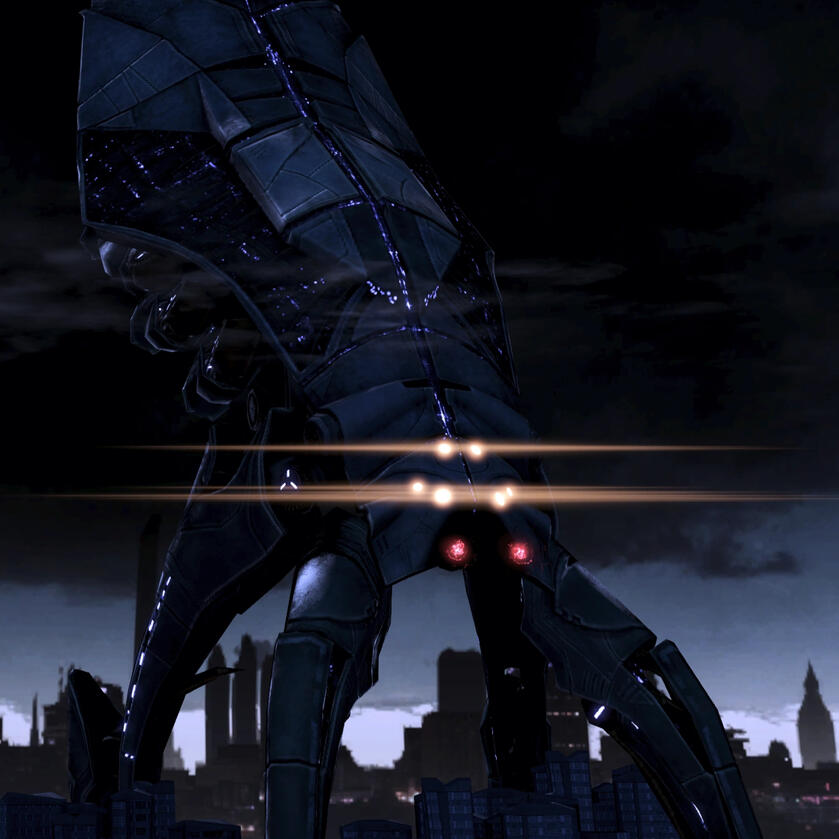
HARBINGER. The first Reaper ever created, Harbinger appears to be of a unique subtype; Alliance intelligence identifies it as being the largest Reaper in the armada, and its design differs notably from the Capital Ship subtype, having only four main legs and multiple glowing "eyes". Exactly how much more powerful it is than a normal Reaper capital ship is unknown. During the Reaper War, Harbinger is one of the Reapers who leads the attack on Earth. Alliance intelligence suggests that Harbinger is the oldest and largest Reaper of the entire fleet.It is directly responsible for the Collectors' operations in 2185, frequently possessing individual Collectors to fight battles personally.
Harbinger is the mastermind behind the Collectors, controlling them with the Collector General serving as its proxy. It directs the Collectors to abduct the entire population of human colonies in order to process captives and use them to create a Human-Reaper.
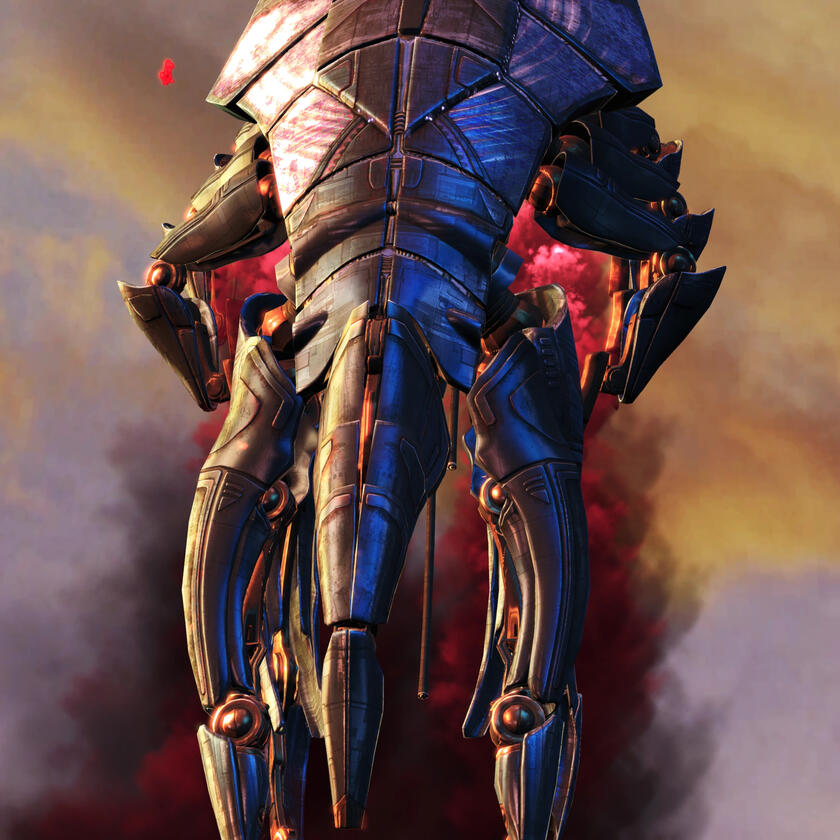
SOVEREIGN. Sovereign is a gigantic Reaper starship of almost unimaginable power and sophistication. Sovereign is in fact an actual Reaper, a fully sentient and extremely powerful AI, which is why the geth obey its commands. They see Sovereign as the pinnacle of AI evolution and worship it as a god. However, Sovereign its thralls (Saren Arterius and the geth) as no more than tools to aid in the return of the Reapers and is even insulted by the worship the geth "hurl" at it. A vanguard of the Reapers left behind to instigate their eventual return from dark space, Sovereign has spent the last 50,000 years in a state of near-constant hibernation, waking periodically to assess the evolution of organic races. It was the duty of the starship to bring about the next revolution of the cycle, and serve as the harbinger for the return of its kind by sending a signal to the keepers on the Citadel. This would make the keepers open the Citadel relay, a mass relay that leads to dark space, and usher the Reapers through.
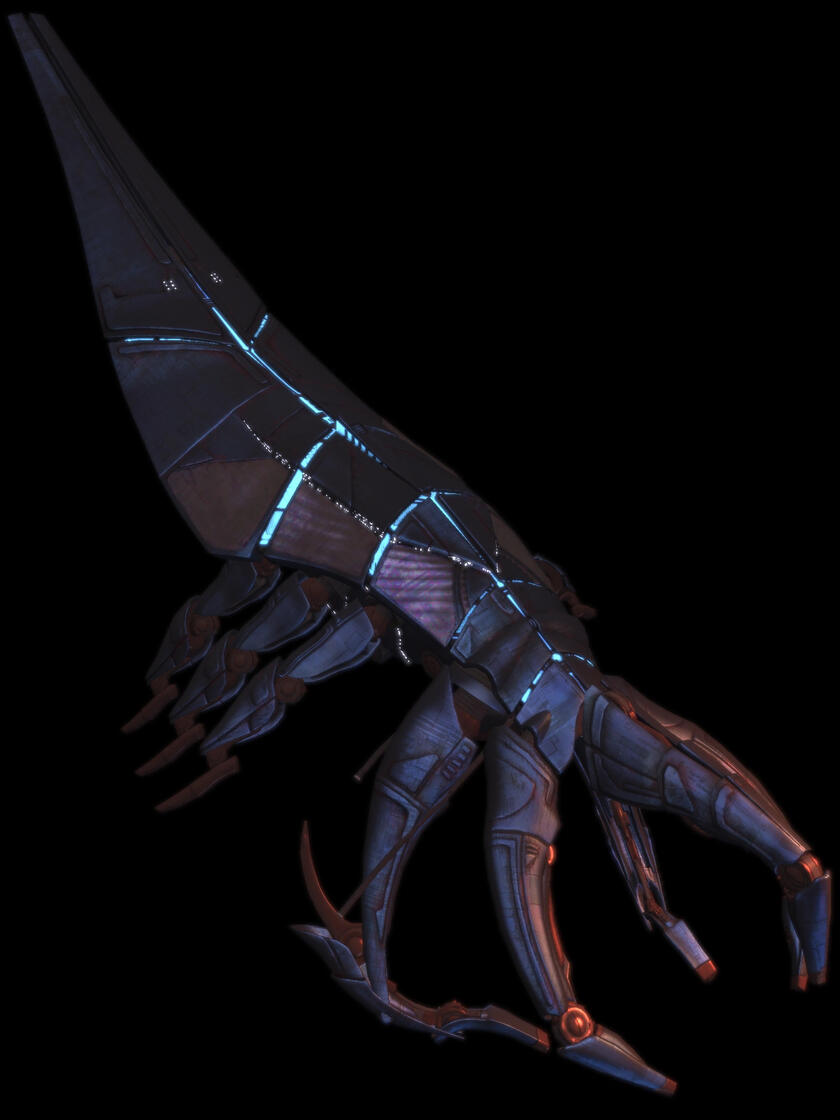
CAPITAL SHIP. Also known as Sovereign-class, the two-kilometer-long Capital Ships are the most well-known Reaper subtype. Their main weapon is a spinal mounted "magnetohydrodynamic" cannon with a yield of 132 to 450 kilotons of TNT, which dwarfs the main gun of an Everest-class Alliance dreadnought. No known ship, not even a dreadnought, has been known to survive a hit from this weapon. Capital Ships are also armed with multiple cannons in their "tendrils" capable of shearing through most opposing vessels in a single hit, a point defense system (similar to the GARDIAN systems favored by organics) for anti-fighter and anti-projectile purposes, and are capable of unleashing swarms of Oculus drones to engage fighter-sized craft. They are extremely durable, capable of taking the continuous and simultaneous fire of four dreadnoughts before they start to lose their kinetic barriers.
TROOP TRANSPORT. Troop Transports vary in length between 200 meters and one kilometer and are used to transport husks to unconquered worlds and bring victims to Reaper processing centers. They lack sentience, being remotely controlled by the Reapers.
PROCESSOR. Mobile centers for mass DNA harvesting. Like the Troop Transports, Processors lack sentience, being controlled remotely by the actual Reapers.
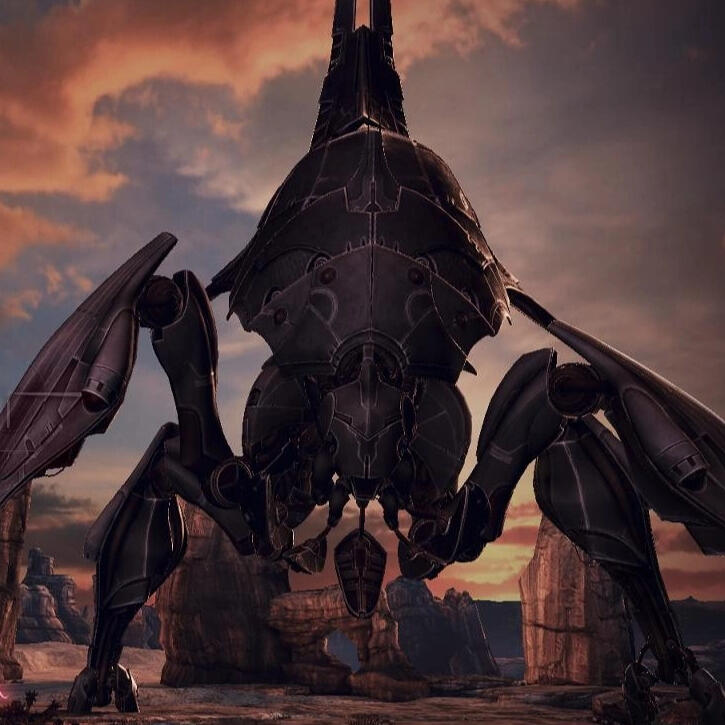
DESTROYER. Destroyers are only 160 meters in height, but possess a formidable capacity for destruction despite their reduced stature, with their main gun easily capable of destroying cruisers in seconds. Unlike Capital Ships, they have four main legs, along with five jointed appendages encircling their "head". The frontal plates of a Destroyer can fold to the sides, exposing a powerful beam weapon. They are used to escort the capital ships, destroying smaller targets such as frigates. On the ground, they are capable of unfolding their legs and walking to support the husks, becoming extremely powerful heavy walkers. They are nigh-immune to ground vehicle fire and not at all fragile in space, but a cruiser is noted to be able to take out a Destroyer fairly quickly.
The Reaper War: Indoctrination
INDOCTRINATION. Reapers and their technology have been observed to exert a disturbing influence on organic beings. This mental manipulation is known as indoctrination. Put simply, any organic being who is in close proximity to a Reaper or certain Reaper artifacts for too long comes to believe the Reapers are correct in their goals, and will do anything to serve them. Gradually, the mind is eroded until the individual becomes a mindless slave no longer capable of independent thought. Reapers can control the rate of this process. Optimally, the subject is led to believe it is still acting on its own convictions. Indoctrination can drive people mad outright, and people deemed useful by the Reapers are given just enough free will to remain competent at their tasks.This indoctrination is permanent, almost impossible to subvert, and is one of the most insidious weapons of the Reapers. Entire civilizations can be delivered into the Reapers' hands by the indoctrination of a few influential individuals. During the invasion of Earth, the Reapers broadcast messages inviting diplomats into their holds to negotiate, where they would then presumably be indoctrinated. A Reaper's indoctrination field can remain active even if it is largely disabled and incapable of action. A Cerberus science team was indoctrinated by being inside a Reaper that had otherwise been floating derelict for 37 million years, its only obvious activity being mass effect field generation.
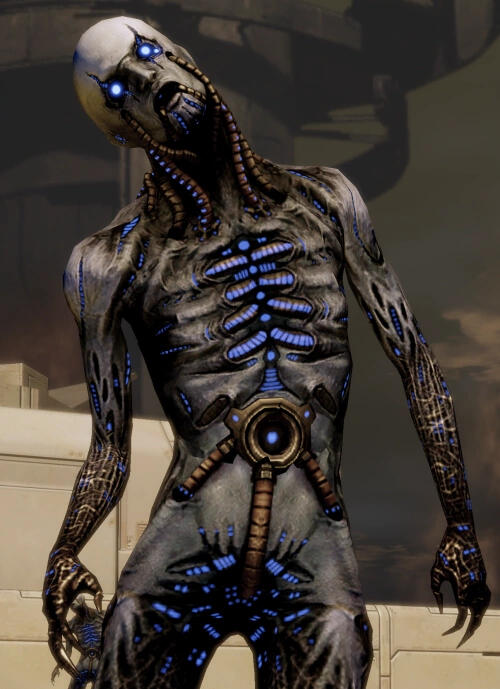
HUSK. Husks are synthetic-organic "zombies" created from the bodies of organic beings, specifically humans. When a target person is captured, they are placed on impaling devices, huge spikes that Alliance marines have nicknamed "dragon's teeth". Over time the body's organs, skin, and water content are converted into cybernetic materials; blood is changed to a sickly green fluid, and the body generates an electrical charge. When the spikes are approached — say, if marines try to recover their dead comrades — the husks are released and attack. The husks will charge at their enemies and, once close enough, give off a powerful electrical blast which disables shields and causes massive damage. Fully-converted husks do not retain any vestiges of their former personalities.
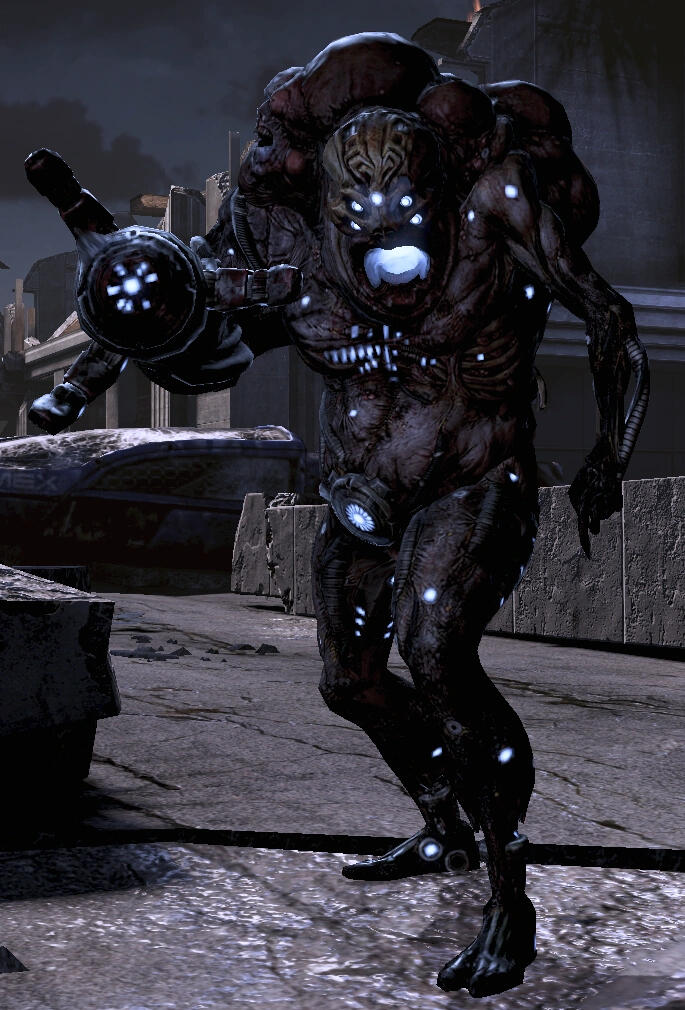
CANNIBAL. Cannibals are synthetic-organic creatures derived from batarians and humans and mutated by Reaper technology. The nickname refers to their propensity to devour the bodies of fallen comrades. This triggers a biochemical process through which the cannibals spontaneously heal themselves and grow new chitinous armor. The transformation also appears to give cannibals a greater awareness of their surroundings, leading to more strategic behavior and careful use of battlefield cover. Cannibals possess a large gun held in place by a human corpse that serves as an arm. Cannibals have the ability to gain constantly regenerating health by consuming other fallen enemies on the battlefield. When Cannibals eat a corpse or are buffed by Marauders, they gain plating on their body which protects them from most types of weapon damage in that area until they are shot off; this often protects their heads, shielding them from taking additional damage from headshots unless the plates are destroyed or penetrated.
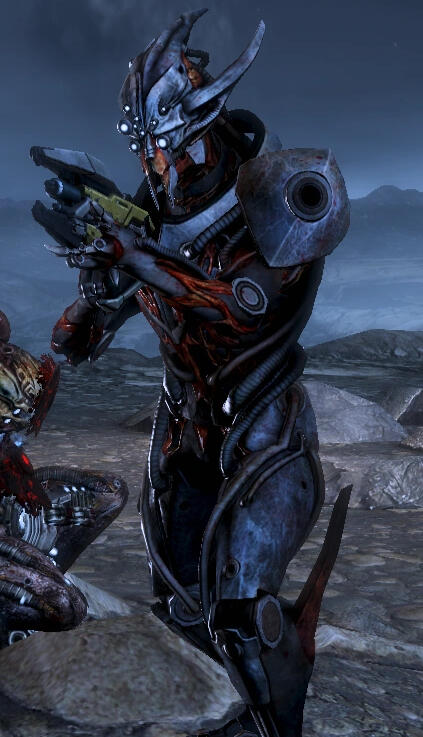
MARAUDER. Marauders are synthetic-organic creatures derived from turians through the use of Reaper technology. They command and protect other Reaper troops. The lean, armored creatures present a significant threat in and of themselves, but they are especially dangerous when leading a Reaper task force.Alliance marines have observed marauders fortifying husks and cannibals by enveloping them in a ribbon of energy that forms a scabby shell of armor. For this reason, when Alliance soldiers encounter a marauder alongside husks or cannibals, standing orders are to target the marauder first.
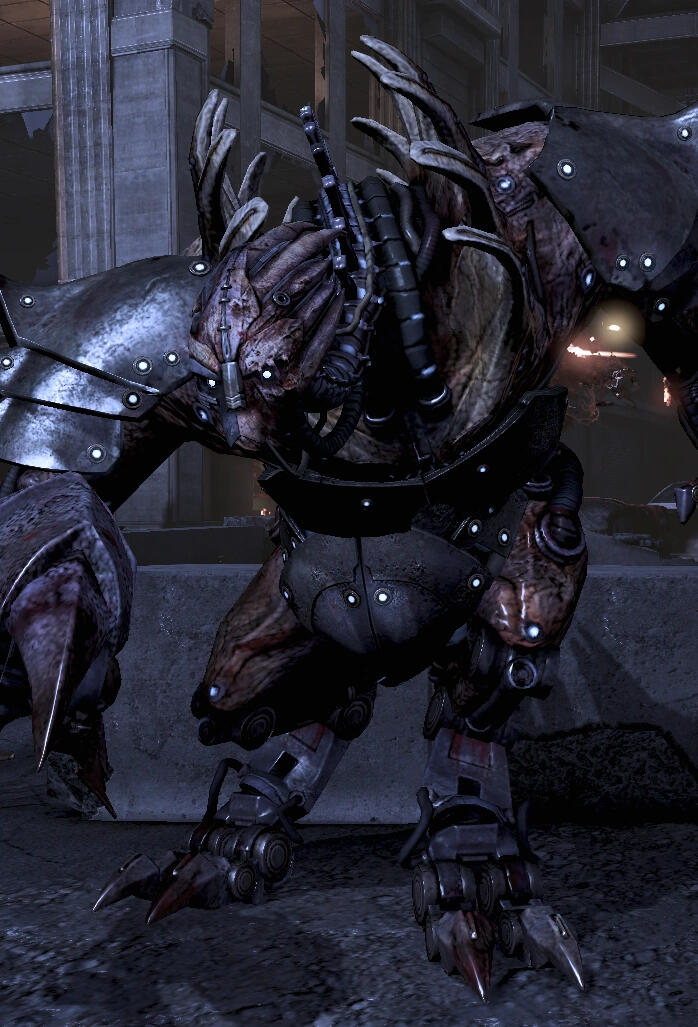
BRUTE. Brutes are synthetic-organic creatures derived from krogan and turians and mutated by Reaper technology. True to their name, they fulfill the heavy melee offense role in ground assaults and can pummel smaller units into bloody paste. Because tissue from dextro-protein species like the turians is incompatible with levo-protein species like the krogan, implants regulate the brute's body chemistry to combat organ rejection. It is the fusion of turian military skill and krogan blood rage that makes the brute such a formidable enemy, capable of destroying armored vehicles to get to the soldiers inside. Troops are advised to keep their distance, and, whenever possible, not engage a brute alone.A Brute's main pattern of attack is a charging attack followed with a wide melee attack, both of which deal high damage—often enough to completely drop shields and, subsequently, health. This swipe can also penetrate intervening cover and terrain. A Brute also can jump and slam its claws into the ground, staggering almost anything in its path. They also periodically beat their chests with their claws and roar, which can also stagger nearby foes. It possesses an over-sized claw arm that can grab and smash a person into the ground, resulting in instant death. When they die, Brutes invariably attempt one last attack, swiping with their claw and trying to crush any nearby enemy under their falling bodies.Large parts of the Brute are protected by thick metallic plates that can be shot off. Their claw arm is covered in armored plates that cannot be shot off; the Brute will sometimes cover itself with the arm while advancing.
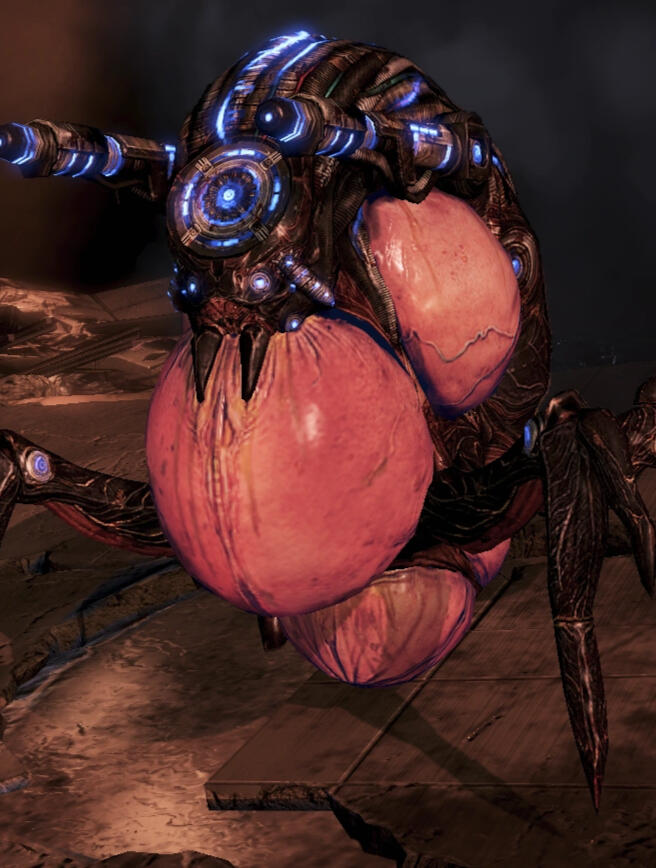
RAVAGER. Ravagers are former rachni that the Reapers have transformed into heavy artillery through a process of implantation and genetic modification. As walking organic turrets, they can sustain and inflict considerable damage. Ravagers bear egg sacs that continuously spawn swarmers. If the sacs are destroyed, either during combat or upon the ravager's death, their entire contents burst forth to charge the enemy and explode on contact. A dead ravager expels a caustic gas and an acidic puddle.Ravagers are armed with two powerful long-range cannons that they fire in three-round bursts after locking on to a target with visible blue targeting beams. They will also continually spawn small numbers of Swarmers to harass their foes. These creatures, though individually fragile, are volatile in large groups, and can hinder shield regeneration with damage over time in addition to their initial impact. When a Ravager dies it leaves behind a smoking pile of acid goop that causes environmental damage to any of its foes who step in it.While they lack a conventional melee attack and do not attack with their cannons at close ranges, if engaged at melee range a Ravager will often spontaneously burst the orange sacs on their bodies, releasing acid and sometimes several Swarmers as well. Depending on how close a foe is to the Ravager and how many Swarmers successfully attack, this can potentially deal massive damage.
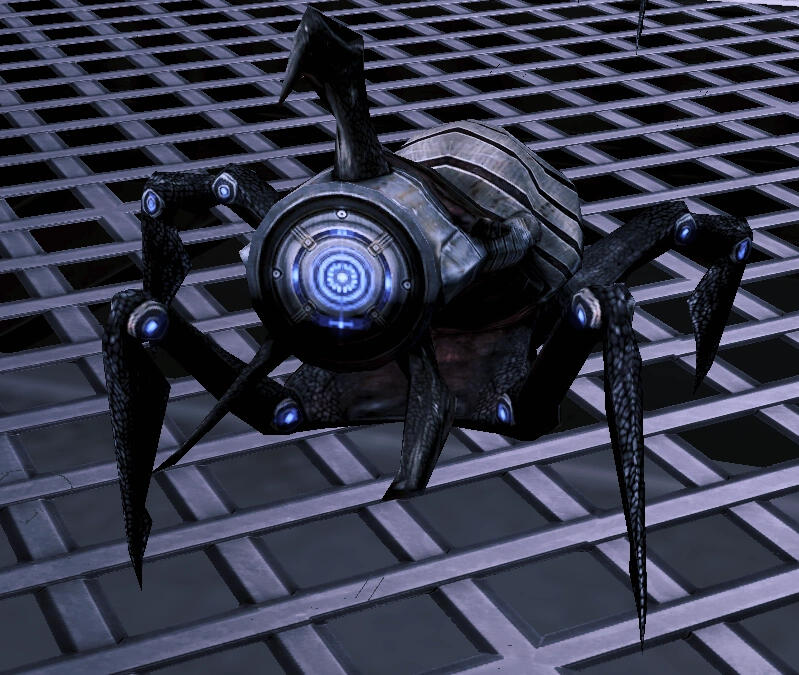
SWARMER. Swarmers are synthetic-organic creatures presumably derived from Rachni Workers and mutated by Reaper technology. Swarmers are volatile in large groups and can hinder shield regeneration with constant attacks. Namely, Swarmers attack by a suicide leap, damaging with both the explosion and acid.
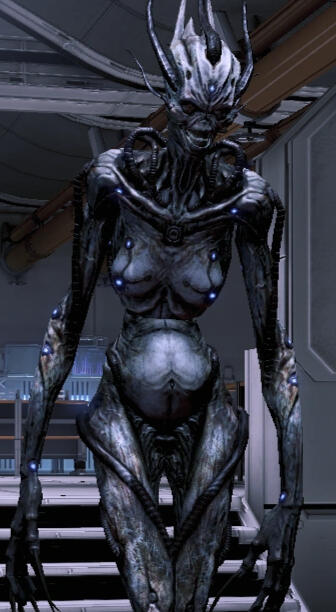
BANSHEE. Banshees are the corrupted asari often found leading a Reaper strike force. The Reapers create them specifically from asari with active or latent predispositions to becoming Ardat-Yakshi, a rare neurological condition that enhances the asari's biotic power while causing the immediate death of anyone she mates with.Lumbering as though in constant pain, the emaciated banshees are surprisingly durable opponents. They are devastating biotics able to hurl lethal balls of energy and create shockwaves as they regenerate. What Alliance military finds most disturbing is the Banshee's ability to spawn her own warp field and seemingly teleport during combat. Although their wails have no apparent physiological effect, the psychological impact is undeniable. When banshees die, their Ardat-Yakshi genetics twist against them, causing a biotic implosion to ensure they evade capture.Banshees can charge their enemies; however, this charge only has a range of about five meters, so the Banshee moves quickly using a series of biotic "hops". They move very slowly when not using this ability. They also have the ability to grab their enemies and subsequently impale them with their hands, resulting in instant death. Sometimes they will stand still and briefly appear to charge up, after which they will scream and release a damaging biotic blast over a surprisingly large area. Finally, they throw powerful biotic projectiles that move slowly but track their target.
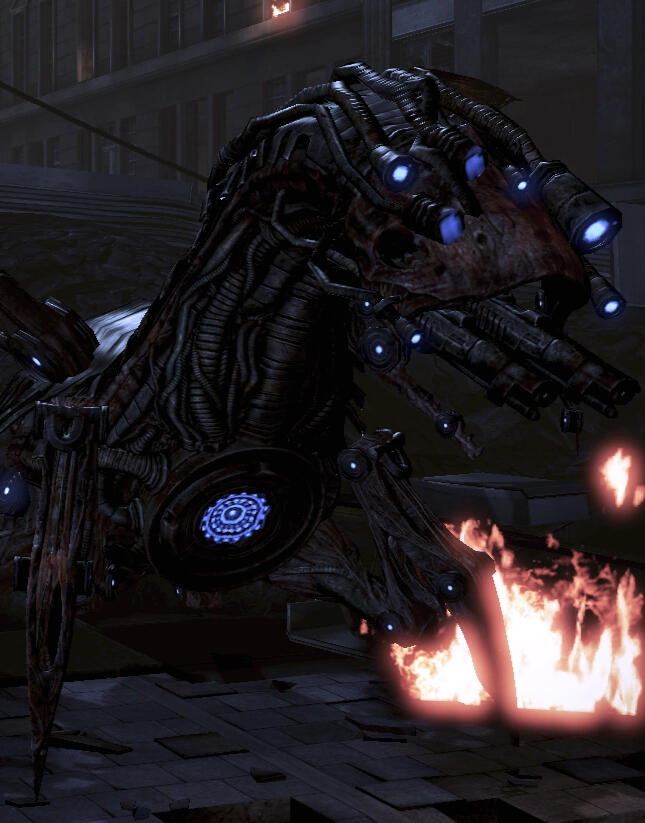
HARVESTER. Harvesters are synthetic-organic creatures derived from creatures of the same name that have been mutated by Reaper technology, often used for air superiority in the atmosphere of a planet. The sight of a Reaper Harvester in flight nearby is one of the first indications that a Reaper invasion is underway. Their massive wingspan allows them to quickly cover the distance between them and their prey. In the Harvester's mouth are two heavy guns that fire in an alternating pattern. The Harvester's most fearsome quality, however, is that its appearance guarantees that Reaper ground troops are not far behind. A Harvester's death is accompanied by a large explosion.
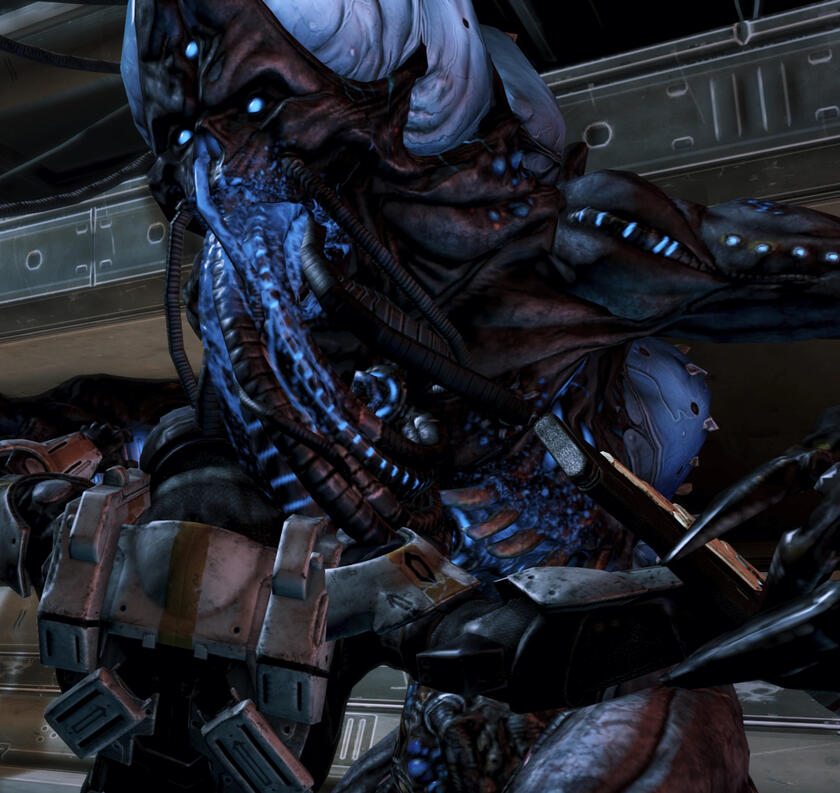
ADJUTANT. Adjutants are hostile husk-like creatures originating from beyond the Omega 4 Relay. Adjutants have the apparent ability to "infect" other beings with their Reaper-originated technology. When an Adjutant first transforms, however, it is significantly weaker and needs more time to rewrite the genetic code of its body. This is the ideal time to eliminate the transformed. The only way to stop the transformation from occurring appears to be to kill those who are "infected" or decapitate an infected corpse. The main goal of the Adjutants is to transform other life forms, and to that end they will try to avoid outright killing others since the dead are useless to them.
Timeline & Key Events
Because the timeline is extensive, this version of the timeline covers only events that are important to humanity, as it is the focus of the Mass Effect timeline.
2069: on July 20, Armstrong Outpost at Shackleton Crater is formally founded as the first human settlement on Luna, on the 100th anniversary of the first lunar landing.
2075: The Manswell Expedition successfully launches from Earth en route to the Alpha Centauri system with 300 colonists aboard in cryogenic stasis. Communications with the vessel are lost soon after.
2103: The European Space Agency's Lowell City in Eos Chasma becomes the first permanent human settlement on Mars.
2137: The Eldfell-Ashland Energy Corporation demonstrates helium-3 (H3) fuel extraction from the atmosphere of Saturn. H3 becomes the basis for spaceship fuel.
2143: Construction of Gagarin Station ("Jump Zero") begins beyond the orbit of Pluto.
2147: Trace amounts of element zero are discovered on Mars. As dust-form element zero was not discovered prior to this, human biotics cannot be born prior to this date.
Humanity Discovers Mass Effect Physics
2148: Humanity discovers a small cache of highly advanced Prothean technology hidden deep beneath the surface of Mars on the south polar region of Promethei Planum. Building on the remnants of this long extinct race, humans quickly explore the science of mass effect fields, leading to the development of faster than light travel and beginning detailed exploration of the Sol system.
2149: Following information from the translated data cache on Mars, humans discover that Charon, Pluto's moon, is actually a massive piece of dormant Prothean technology, a mass relay, encased in ice. Once activated, Jon Grissom leads the first team of explorers through the relay, which instantaneously transports them to another relay in Arcturus, 36 light-years away. The explorers discover that the mass relays are part of a vast network, making travel across the galaxy possible. The Systems Alliance charter is signed by the eighteen largest nations on Earth. The Alliance soon becomes the military and exploratory spearhead of humanity.
2150: The Systems Alliance begins the first surveys for colonization prospects outside the Sol System. One of these surveys discovers the planet Terra Nova.
2151: To defend its expanding territory, humanity begins constructing a massive military fleet and space station at Arcturus, the nexus of several key mass relays, even though they have yet to encounter another intelligent spacefaring race. An accident at Singapore International Spaceport exposes hundreds of humans to dust-form element zero. Roughly 30% of the children born in Singapore after element zero exposure suffer from cancerous growths.
2152: The Delta Pavonis Foundation, a major consortium based on Earth, begins settlement of humanity's first extra-solar colony world, the planet Demeter. Later that year, additional colonies are founded on Eden Prime and Terra Nova.
2154: There is a second publicized accident involving the exposure of humans to element zero.
2155: The Systems Alliance occupies completed portions of Arcturus Station, intended to become the Alliance's headquarters.
2156: Arcturus Station is formally inaugurated. A small number of human children exposed to element zero exhibit minor telekinetic abilities.
Advent of Humanity: The First Contact War
2157: Humanity makes violent first contact with another spacefaring race: the turians. The turians observe human explorers attempting to activate a dormant mass relay, a practice forbidden by galactic law after the Rachni Wars, and attack. Over the next three months, a brief but tense conflict known by humans as the First Contact War and by turians as the Relay 314 Incident ensues. Turian forces occupy the colony of Shanxi, with combat eventually reaching a standstill as the turians opted to bomb entire city blocks to take out singular fire teams. Rather than continually sacrifice military and civilian lives, General Williams opted to surrender to the turians, becoming the first human to surrender to an alien race.
The First Contact War culminates in the turian siege and occupation of Shanxi as it became the first human world to fall to an alien race. The turians prepare for a full-scale war against humanity, but this draws the attention of the Citadel Council. The Council intervenes before hostilities escalate further, revealing the existence of the greater galactic community to humanity and brokering a peace between them and the turians.
An anonymous extranet manifesto is published following the end of the First Contact War. The manifesto calls for an army, a "Cerberus", to be established to defend humanity against inevitable alien attacks. Derided as "survivalist rhetoric written by an illusive man", the manifesto is quickly forgotten by the media.
2158: Humans learn the potential of biotics. An international effort to track element zero exposures begins. Roughly 10% of recorded exposed children show indications of biotic ability.
2159: The Systems Alliance purchases Gagarin Station for a fraction of its construction cost, and converts the facility into a biotic research and training facility.
2160: The Systems Alliance Parliament is formed.
With the existence of human biotics firmly established, the Biotic Acclimation and Temperance Training (BAaT) program is set up on Gagarin Station to train potential candidates and develop biotic implants.
The biotic drug red sand is first used.
The Blue Suns mercenary group is founded by Zaeed Massani and Vido Santiago in the Skyllian Verge.
2161: Amid concerns over gene therapy and genetic modifications being misused, the Systems Alliance Parliament passes the Sudham-Wolcott Genetic Heritage Act. It imposes sharp restrictions on controversial uses of genetic engineering, but provides government subsidies for beneficial applications.
2162: Construction of Arcturus Station is completed.
2163:The Alliance secretly begins illegal AI research at a base on Sidon with Dr. Shu Qian as project leader. Lt. Kahlee Sanders is assigned as a tech analyst.
The first experimental L1 biotic implants are used in humans.
A series of starship drive failures are orchestrated over populated areas on human colony worlds, causing widespread exposures to element zero. This results in a second generation of humans born with biotic potential.
2164: Ivor Johnstagg is sentenced to 21 years in prison for attempting to assassinate Venta Tox, the volus ambassador to the Citadel. Although Johnstagg claims to be acting on behalf of the radical human political party Eternal Earth, no connection is found and Johnstagg is diagnosed with paranoid schizophrenia. Backlash from the assassination attempt jeopardizes the Systems Alliance's bid for an embassy on the Citadel.
2165: Humanity continues to expand, founding more colonies and establishing trade alliances with many of the other species who recognize the authority of the Citadel Council. In 2165 CE, the Council makes official recognition of humanity's growing power and influence in the galactic community. Humanity is granted an embassy on the Citadel, the political and economic heart of the galaxy. Tensions grow between humans and batarians as they compete for territory in the Skyllian Verge.
After an Alliance research station at Sidon is attacked, David Anderson searches for those responsible alongside Kahlee Sanders, and discovers an Alliance scientist, Dr. Shu Qian, was conducting illegal AI research to unlock the secrets behind a mysterious artifact discovered near the Perseus Veil. Eventually, Anderson is assigned to work with Saren Arterius to track down Dr. Qian and his batarian supporter, Edan Had'dah. However, Saren instead kills both Dr. Qian and Had'dah, blames Anderson for the mission's failure, and uses Dr. Qian's research to search for the artifact himself.
Terrorists steal antimatter from the Alliance cruiser SSV Geneva. The sole figure arrested names his sponsor "Cerberus". This is the first such incident of sabotage connected to the Cerberus organization.
After a disagreement between Vido Santiago and Zaeed Massani over hiring batarians into the Blue Suns, Vido betrays Zaeed and leaves him for dead. All records of Zaeed's involvement in the Blue Suns are erased.
Jack, an infant at the time, is abducted by Cerberus agents on Eden Prime. They fake her death and take her to the Teltin Facility on Pragia as part of a project intended to improve biotic potential in humans.
2166: Commander Vyrnnus, a turian mercenary, is hired to oversee the training of human biotics at BAaT.
2167: L2 biotic implants are first developed and used in humans.
2168: A studentaccidentally kills Commander Vyrnnus after being provoked. The diplomatic fallout with the turians results in BAaT being shut down a year later.
2169: The human colony of Mindoir is attacked by batarian slavers. Many colonists are killed or captured.
Another human colony, Yandoa, suffers catastrophic dust-form element zero exposure to its atmosphere when an Eldfell-Ashland Energy ship explodes in orbit. Many children suffer birth defects; thirty-seven biotic children are born.
Biotic training for humans is outsourced to the military, selected R&D companies, and renamed divisions of the defunct Conatix Industries.
L3 biotic implants are developed after L2 implants prove to be dangerous.
2171: Cerberus assassinates Pope Clement XVI on Earth via rosary beads coated with toxic substances; his death is attributed to age and heart failure. His successor, Pope Leo XIV, espouses beliefs more in-line with Cerberus' ideals.
2172: On Gagarin Station, "Eliza" becomes the first sapient AI created in the Systems Alliance.
2173: Terra Firma is involved in a Nashan Stellar Dynamics kickbacks scandal, forcing Inez Simmons, the current party leader, to resign. Charles Saracino becomes the new party leader after his opponent, Claude Menneau, is assassinated by Cerberus operatives while en route to Shanxi. Publicly, Menneau's disappearance is never explained.
2175:On a survey mission to 2175 Aeia, an important colonization prospect for the Systems Alliance, the MSV Hugo Gernsback disappears and is presumed destroyed.
Cerberus covertly contacts Michael Moser Lang, a political dissident on Earth, and provides him with funding to purchase weapons. Cerberus continues to monitor him after contact ends. One year later, Lang assassinates United North American States president Enrique Aguilar and Chinese People's Federation premier Ying Xiong. The resulting political shuffle benefits Cerberus' shell companies and plans for the Systems Alliance Parliament.
2176: Batarian-funded pirates and criminals launch a surprise attack, later known as the Skyllian Blitz, on the human colony of Elysium. The assault is repulsed by the Alliance Navy and ground teams.
The Jon Grissom Academy is commissioned over Elysium, and becomes home to the Alliance's new biotic training program, the Ascension Project.
2177: During a recon mission to find a missing colonial pioneer team on Akuze, a unit of fifty Alliance marines is wiped out by thresher maws.
2178: In retaliation for the Skyllian Blitz, the Alliance launches a major offensive against the moon of Torfan and destroys the criminal bases there, mostly populated by batarians. The threat against human colonies from batarian extremists is curtailed.
The Alliance tracks several pirate FTL exit vectors over a period of six months using covert monitoring devices planted on Theshaca's moons, leading the Alliance Navy to eight major pirate anchorages. Since the "Theshaca Raids", no ships from the Terminus Systems have entered the Hong system.
2183: Humans and turians collaborate on an engineering project co-sponsored by the Citadel Council: an experimental frigate with a prototype stealth system, the SSV Normandy. David Anderson is given command of the ship, and Commander Shepard is assigned as executive officer.
ME1: The Eden Prime War (2183)
EDEN PRIME: The human colony of Eden Prime is attacked by the geth, initiating a wider conflict between humans and geth known as the Eden Prime War. After exposing the involvement of rogue Spectre Saren Arterius in the attack, Commander Shepard and the crew of the SSV Normandy pursue Saren in his search for the Conduit, later revealed to be part of a larger plan orchestrated by the Reaper Sovereign to return its kind to the galaxy.
FEROS: Geth swarmed the spaceport of Zhu's Hope as they launched an assault on ExoGeni Headquarters, closer to the main colony on Feros. During the assault, it was noted that the colonists at Zhu's Hope had been infected by a plant-like species, known as the Thorian, which was part of Saren's search for the Conduit. The Thorian was eventually killed by Commander Shepard, and the geth were driven out of the colony. The remaining ExoGeni scientists and one of Saren's defected asari commandos, Shiala, stayed behind to help the colony rebuild.
NOVERIA: After an incident at the Binary Helix hot labs, the appearance of an asari matriarch, Benezia T'Soni, caused an incredible stir among the people. After investigation it was revealed that Benezia and her commandos had transported geth units in containers to Port Hanshan in an attempt to reclaim what BH had been researching: the hatched queen from a rachni egg. Depending on Shepard's choices, the new Rachni Queen will either survive or be killed.
VIRMIRE: The search for Saren led to a research facility on Virmire, with one supposed task: to create a cure for the Genophage that had plagued the krogan race for centuries. In the process to destroy the facility, a salarian STG team converted their drive core into a nuclear weapon, and with the assistance of Shepard, the facility was destroyed. In the process, depending on Shepard's choices, either Lieutenant Kaidan Alenko or Gunnery Chief Ashley Williams is left to die on Virmire. However, some Shepard writers also choose to state that both survive, a plot choice achievable through mods.
TERRA NOVA: A group of researchers and engineers were bringing a large asteroid to the colony of Terra Nova with the intent to mine the asteroid for resources and eventually turn it into the base for a space station. During their travel with the asteroid, batarian slavers led by Balak, a notoriously vicious batarian, turned the asteroid's course to directly crash into Terra Nova with the intent to kill millions of human civilians and wipe out most life on the planet. With the assistance of Commander Shepard, this attempt was thwarted. Depending on Shepard's choices, the civilians on the asteroid will either be saved while Balak escapes, or will be sacrificed as Shepard attempts to kill Balak for his actions.
BATTLE OF THE CITADEL: While Shepard follows Saren through the legendary Mu Relay to the Conduit, Sovereign and a geth fleet assault the Citadel. Shepard defeats Saren and the Alliance Navy destroys Sovereign, preventing the release of the Reapers. The Citadel Council is irrevocably changed by Shepard's decisions. Depending on Shepard's choices, the current Citadel Council will either be spared at the cost of human lives, or sacrificed so the human fleet can focus on Sovereign. As well, Shepard's decision will determine whether Donnel Udina or David Anderson takes up the role of the first human councillor.One month after the Battle of the Citadel, the SSV Normandy is attacked and destroyed by an unidentified assailant, resulting in the death of Commander Shepard. Later, the Systems Alliance officially declares Shepard "killed in action".
LAZARUS PROJECT: Commander Shepard's body is recovered by Blue Suns mercenaries for the Shadow Broker, who has been hired by the Collectors. Cerberus eventually obtains the body with the help of Liara T'Soni and begins work on the Lazarus Project, an endeavour led by Miranda Lawson with one purpose: to bring Commander Shepard back to life.
ME2: Missing Human Colonies & The Collectors (2185)
LAZARUS PROJECT: Commander Shepard is successfully revived and tasked by the Illusive Man to investigate the mysterious disappearances of entire human colonies in the Terminus Systems. Investigation of the attacked colony of Freedom's Progress reveals the enigmatic Collectors from beyond the Omega 4 Relay to be responsible for the disappearances. After assembling a capable team, Commander Shepard uses a captured Reaper IFF to safely traverse the relay and infiltrate the Collector base. Shepard succeeds in eliminating the Collector threat, saving humanity throughout the galaxy from certain destruction.
HORIZON. Among the number of human colonies kidnapped by the Collectors is Horizon. However, upon the intervention of Commander Shepard, some of the colonists were saved as the Collector ship was driven off.
SHADOW BROKER: Liara T'Soni locates the Shadow Broker's concealed base on the planet Hagalaz. The Shadow Broker, exposed as a yahg, is killed. Liara takes control of the Broker's organization, intending to use the Broker's vast information network to aid Shepard's fight against the Reapers. Few outside of Liara's immediate circle are aware of this fact, and believe the Broker has not changed.
THE ALPHA RELAY INCIDENT. The Bahak system is subsequently destroyed following the explosion of its mass relay. An asteroid was sent to the relay in order to delay the Reapers' invasion. Hundreds of thousands of batarians living on Aratoht are obliterated in the blast.
ME3: The Reaper War (2186)
THE FALL OF KHAR'SHAN. For every thousand batarian refugees, there are a thousand and one stories about how the Reapers invaded the batarian systems. A few elements are common to almost every version, however. The Reapers arrived first in the Vular system and immediately destroyed its communications network. The Hegemony's Department of Information Control blamed the loss of signal on space weather, but scrambled ships to the system nonetheless. Within a day, Reaper capital ships appeared in the Harsa system and descended on the batarian homeworld, Khar'shan.For all the rhetoric about the Hegemony's military prowess, their response to the Reapers was uncoordinated. Moments after the information minister took to the extranet and announced that unknown ships were destroying all space traffic near Khar'shan, the defense minister declared there was no reason to panic. The planet's comm buoys were destroyed next, creating an ominous silence that has persisted ever since.Fearing they were next, batarian colonies across Hegemony space began evacuations. So many refugees poured into the human-occupied Exodus Cluster that Systems Alliance officials at first thought the batarians were invading.More systems have gone dark as their comm buoys were destroyed, and millions more batarians, trapped on their planets, sit waiting for the Reapers.
FALL OF EARTH. The Reapers took Earth in a matter of hours. The Alliance knew the first wave would arrive from batarian space, but they were unprepared for the speed and scale of the attack.The Reapers bypassed the Sixth and Seventh Fleets at Terra Nova and Eden Prime, flying straight from relay to relay where they could neither be tracked nor intercepted. The tactic was unexpected, since the navies of organic species would never risk coming out of FTL within combat range or leaving enemies at their backs to threaten supply lines.At Arcturus Station, more than a dozen Reaper capital ships engaged the Alliance's Second, Third, and Fifth Fleets. This was mere screening for the main force. Dozens more capital ships continued through the Charon Relay, where the First Fleet had been lying in wait but was soon destroyed. The Fourth Fleet, near Earth, had a few minutes of advance warning. It stood no better chance.After destroying Earth's comm buoys, smaller Reaper destroyers wiped out all GPS and communications satellites in Earth's orbit and cut the undersea fiber-optic cables that linked the continents. Earth's resistance now relies on outdated radio towers and a few quantum entanglement communicators whose matched pairs happen to be on other continents or outside the Sol system. Communication is so limited that the fate of entire nations remains unknown.The capital ships bombarded defense installations and industrial centers, annihilating entire cities with populations in the low millions, including Adelaide, Hamburg, Al Jubail, and Fort Worth. Meanwhile, Reaper destroyers descended into the atmosphere to melt roads and capture population centers with minimal loss of life. This is not an example of the Reapers being merciful. More likely, they are herding their prey to make the coming harvest that much easier.
FALL OF TAETRUS. The Reapers' first attack on turian space followed an age-old maxim: hit them where it hurts. A populous colony dating back centuries, Taetrus was already embedded in the turian psyche as the site of the worst terrorist attack in turian history. Wounds were still raw from the Vallum Blast, in which a separatist revolutionary slammed a starship into the colony's capital, killing more than a hundred thousand turians. Hierarchy forces responded with a massive invasion of the planet to stamp out the separatist movement. It was a catharsis for the turians, reassuring them that heroes would always triumph over evil. And so the Reapers struck Taetrus first.By the time Taetrus went dark, the turians had already learned that the batarians and humans were under attack. The Hierarchy responded with what they believed was overwhelming force, only to walk into a trap. Reaper ships were waiting on the other side of the relay to Taetrus, and they released devastating firepower the moment the fleet emerged. Turian leaders observing the one-sided battle were faced with a choice: reinforce their side of the relay to defend against a Reaper invasion, or throw more resources into an offense. With soldiers and civilians alike clamoring for retribution against the Reapers, the turians continued the assault. The Hierarchy sent warp bombs through the relay to clear a path, fighting tooth and talon to inflict casualties against the Reaper fleet. It was a valiant effort, but doomed. The Reapers emerged victorious from the relay and began broadcasting a signal to turian comm buoys--images of Vallum, Taetrus's capital, once again a smoking wreck. The fight for turian space had begun.
THE BATTLE OF PALAVEN. When Taetrus fell, the turians knew little about the Reapers except that they wanted to enrage the turians. Staying calm, the turians massed in force around Palaven, their homeworld. Fleet Admiral Irix Coronati, in what became known as the "Fifteen-Minute Plan," stationed only two carriers, Undaunted and Resolute, near the system's relay. When the Reaper fleet emerged, the carriers launched swarms of unmanned fighters and spy drones. These were quickly destroyed, but the drones transmitted vital data on the Reapers' effective range, fleet composition, and exact location. The turians' other ships then deployed to defend the system in earnest.Knowing that the Reapers' weapons had a longer effective range than any of his own, Coronati made a short, daring FTL jump--landing his dreadnoughts in the middle of the Reaper fleet. The dreadnoughts then turned to line up their main guns on the Reapers, which also needed to turn to fire on the turians. This ploy used the Reapers' size against them--because they could turn faster, the turian dreadnoughts locked targets first, and their concentrated firepower downed several Reaper capital ships.The Reapers countered instantly. Their destroyers performed a jump of their own to the skies above Palaven, beginning orbital strikes on turian cities. The turians, forced to defend the planet, found themselves in a pitched battle far from the relay, from which emerged a seemingly endless line of Reaper ships. After massive casualties, Coronati ordered retreat.The turians insist that Palaven is not lost--the battle has merely moved to the ground. Reaper troop transports have dumped hordes of husks to capture Palaven's inhabitants, but met with little success. Reaper capital ships are destroying city after city. But much of the turian fleet is still operable, and the citizenry is heavily armed. The turians refuse to be intimidated.
THE GENOPHAGE CURE. In an attempt to garner support from the krogan clans for Palaven, an agreement was made to cure the Genophage that had plagued the krogan for thousands of years. Recovering a sole immune female from a testing facility on the salarian homeworld of Sur'Kesh, a cure on the Genophage is worked on. Depending on Shepard's choices, this results in either the cure or the false pretense of a cure for the krogan.
THE MIRACLE AT PALAVEN. The turian and krogan counterattack on Palaven combined deception, courage, and tenacity. First, the turians leaked a false battle plan that drew on the same tactics they used at beginning of the assault on Palaven. Then the dreadnought Indomitable faked a problem with its drive core, coming out of FTL near Palaven's moon, Menae. Three other dreadnoughts and their attendant fleets deployed to assist Indomitable, a tempting target that drew the Reaper capital ships away from Palaven. Turian troop transports then entered Palaven's atmosphere to release shuttles, gliders, and individual soldier capsules.The Reapers did not understand the seriousness of the threat at first--those that detected the landing crafts sent husks and Collector swarms to intercept them, but little more. This allowed krogan commandos to link up with Palaven's resistance and hand off their payloads--warp bombs and fission weapons.In simultaneous strikes across the globe, Reaper ships began to explode. Turian resistance members had managed to smuggle the bombs inside when the Reaper processing ships, troop transports, and even destroyers and capital ships had opened their structures to indoctrinate turian leaders.Large swaths of territory fell back into turian and krogan control. News of the victory gave a much-needed boost to the morale of the turian resistance and the galactic public.But the action was not without sacrifice. Turian insurgents gave their lives to ensure the explosives detonated, and the processing centers they destroyed were full of civilians who died just as surely as if they had been harvested. Of the dead, General Minin Resvirix said, "Whatever they were in life, their deaths had no equal. They are worthy of joining the spirit of Palaven itself."
THE CITADEL COUP. Councilor Udina's attempted coup will no doubt be analyzed for generations to come, but a clear picture is beginning to emerge. Udina had contacted Cerberus to coordinate what was intended to be a bloodless takeover of the Citadel, in which he would force the other councilors to grant him emergency powers so that he could command the Citadel Fleet. He would then direct the fleet to liberate his homeworld, Earth.The plan fell apart early when Executor Pallin and the salarian councilor caught wind of it. In defense of the plan, the Illusive Man dispatched his top assassins, commanded by Kai Leng, to kill them. Udina had little choice but to support the assassins with an armed force sufficient to hold the Citadel. Captured confidantes have indicated that Udina and Leng's alliance was relatively fragile: Udina may have planned to turn on Cerberus once the fleet was his to command, and Leng departed when he calculated that Udina would not succeed.Persistent rumors suggest that Udina might have been a high-functioning victim of Reaper indoctrination. His actions played right into the Reapers' plans: even if the coup failed, it would damage Citadel governance. If it succeeded, his plan to retake Earth would likely have turned into a military blunder that Council forces could ill afford. However, there is no direct evidence of his indoctrination, nor obvious opportunity. It is more likely that Udina acted out of desperation, and in doing so, cost humanity its councilor.
RECLAMATION OF OMEGA. Sometime early on in the Reaper War, Cerberus launched an assault on the asteroid of Omega, driving Aria T'Loak out of power and taking over the station. With the assistance of Commander Shepard and the Talon Mercenaries, who had been footing a resistance on the station, Cerberus was eventually removed from power and Omega's rule was returned to Aria. Depending on Shepard's choices, Oleg Petrovsky will either become a prisoner of war of the Alliance, killed by Shepard, or killed by Aria.
RECLAMATION OF RANNOCH. The quarians' plan to take back their homeworld was risky, and could easily have led to their annihilation if a peaceful solution had not been found.In an initial battle against the Reaper-upgraded geth ships, the quarians found their Heavy Fleet and a portion of the Patrol Fleet outmatched. To stave off defeat, the quarians retreated at FTL speeds to rally with the Civilian fleet on the far side of Rannoch's sun, Tikkun. Temporarily hidden, but with only minutes of advance warning should a geth scout spot them, the quarians planned counterattacks to disrupt the geth link with the Reapers. First preying on a damaged geth dreadnought, the quarians followed by sending strike teams to Rannoch's surface to destroy the Reaper that was transmitting improved software to geth forces.When the Reaper uplink was disrupted, the geth suffered momentary downgrades in response time and intelligence, allowing the quarians to press their advantage.The outcome of this scenario is dependant on Shepard's choices: saving the quarians, saving the geth, or brokering peace between the quarians and geth.
FALL OF THESSIA. The assault on Thessia did not go as smoothly as the Reapers' strikes against other races. While other species met the Reapers head-on, the asari resorted to dangerous hit-and-run tactics to harass their attackers. By engaging in guerilla strategies--blasting a Reaper ship, then jumping to FTL where they could not be tracked--the asari forced the Reapers to remain on the defensive.Unfortunately, the Reapers' greater numbers allowed them to accept certain losses, so they soon ignored the attacks against them and began orbital bombardment of Thessia. This in turn forced the asari to defend their homeworld with a more traditional stance, facing the Reaper forces directly. As soon as the Reapers landed on Thessia, the harvesting began.A swift and brutal slaughter of the asari ground forces followed. Resistance from trained biotics barely slowed the attackers down. In the end, Thessia's minimal military forces, combined with unpreparedness in the face of an overwhelming enemy, resulted in the fall of the planet.
SHEPARD: IDENTITY THEFT. At some point after the Citadel Coup, a number of mercenaries attacked the Ryuusei Sushi restaurant where Commander Shepard was seen dining. After a shootout and a number of civilian injuries, the floor of the sushi restaurant was destroyed, forcing the restaurant to permanently close. Between a shootout in the Wards, the further destruction of a used car lot, and a few destroyed C-Sec shuttles, the situation was eventually contained after unauthorized persons tried to take control of the SSV Normandy SR-2. The ship was eventually recovered, and those responsible were apprehended.
RETURN OF LEVIATHAN. As Commander Shepard continued to investigate further information on the Reapers, further information was determined on the origin of the Reapers: their origins traced back to the Leviathan race, who had created them for one sole purpose: preserve life at all costs. This was created in response to organics' tendency tofrequently build synthetic constructs to aid them; these synthetics consistently rebelled, wiping out many species in the process. The Leviathans failed to perceive the Intelligence as a threat; they considered it nothing more than another tool to achieve a set goal. As the Intelligence sought out the means to fulfill its mandate, it created an army of pawns that were dispatched to collect physical data from organic species throughout the galaxy. Eventually, the Intelligence came to the conclusion that the Leviathans themselves were part of the problem, and turned against them. Only a few survived, masking themselves deep in the oceans to avoid the Reapers. They are eventually convinced to join the fight against the Reapers.
CRONOS STATION: THE FALL OF CERBERUS. Finally tracking Cerberus to their headquarters in the Anadius system of the Horsehead Nebula, assaulting the station became the first half of the final stand against the Reapers. As the Alliance's fleets opened a line of sight for the Normandy, allowing them to dock and begin the internal assault on the station. As the information on the Catalyst was recovered, the station was eventually blown up, and the cerberus assassin Kai Leng was killed in the final assault. During this time, the Citadel was moved by the Reapers to Earth, in order to orchestrate their final plans.
EARTH: THE FINAL STAND. With the Reapers' forces centered around Earth, a multi-species assault began on humanity's homeworld. Pooling all of the galaxy's resources and led by Admiral Steven Hackett and Admiral David Anderson, the galaxy's naval forces assaulted the Reaper forces on Earth: Hammer Team was the name of the ground assault that landed on the planet and fought their way through waves of Reaper forces to establish a FOB (Forward Operations Base) for their final assault. In the meantime, Sword Fleet attacked the Reapers in orbit around the planet, while Shield Fleet was tasked with guarding the Crucible as it travelled to Earth. Commander Shepard and Admiral Anderson led the final charge for the Reaper assault, charging on foot and with vehicles to the beam that was being used by the Reapers to transport humans up to the Citadel for whatever plans they had for them. Eventually, members of Hammer forces were believed to be wiped out: however, Anderson and Shepard made it to the Citadel, managing to open the arms of the station so the Crucible could dock. Shepard is left in critical condition, and Anderson succumbs to his injuries.There are three possible canonical endings and one heavily utilized fanon ending that is decided based on Shepard's choices:
CONTROL: After a conversation with the Intelligence responsible for coordinating the Reapers, Shepard---who is considered part-synthetic, part-organic due to their cybernetic implants---sacrifices their physical body in order to take control of the Reapers, allowing them to assist with rebuilding the galaxy and so the Intelligence could understand organic life better. This process destroys the galaxy's mass relays.
DESTROY: After a conversation with the Intelligence responsible for coordinating the Reapers, Shepard chooses to destroy the Reapers entirely. This decision, however, results in the destruction of all synthetic life in the galaxy, including the geth and other AIs such as EDI. Depending on the number of War Resources acquired by Shepard, it's implied that the Commander survives.
SYNTHESIS: After a conversation with the Intelligence, Shepard sacrifices their body in the Crucible's energy beam, providing their hybrid organic-synthetic material as a basis for synthesizing all organic and synthetic life in the galaxy into one form.
AHEM/MEHEM MODDED ENDING: Similar to the Destroy ending, where the Reapers are destroyed. However, this process does not destroy EDI or the geth in the process. The mass relays are not destroyed, and at the end, Shepard is seen surviving to put Anderson's name on the Normandy's memorial wall.
Humans in Mass Effect
This section covers more detailed information on humanity, its government, military, and brief overviews of key historical events that shaped humanity's society.
BIOLOGY
Humans have a fairly robust physiology. Their internal makeup and reproductive processes are typical of most bipedal mammals, and their size and proportions give the appearance of being strong, fast and agile. In comparison to the Council races, humans are roughly physically on par with turians (as a human in or around peak physical condition can overwhelm a similarly fit turian, making them near equals in a hand-to-hand combat situation), and less agile than asari (whom they closely resemble). Humans would appear on average to be stronger than salarians but not as fast, due to the extremely elevated metabolisms of the latter.Like most organic races, humans are also capable of producing biotic individuals. All cases of natural biotics in humans are the result of pre-natal exposure to element zero, which carries a high risk of medical complications.Humans can live to about 150 years, and recent medical advances have eradicated almost all known diseases that afflict them. Humans reach physical maturity at approximately eighteen years of age, at which point they have usually finished their academic education and either directly enter the workforce or begin training for a profession.It has been noted that humans are unusual in the galactic community because they have far greater genetic diversity compared to other species with more peaks and valleys. This makes human genetic material useful in biological experiments, as a control group.Despite the substantial genetic diversity of humans, certain physical traits have been becoming rarer ever since the 19th and 20th centuries, when the mixing of different Earth ethnicities, due to social progression and acceptance, became more commonplace. To this end, with the merging of genetics, certain traits have declined in frequency. Recessive physical traits like blonde and red hair, as well as blue and green eyes, are even less common in the 22nd century.
BASIC HISTORY
NEW HORIZONS. Human space exploration began in earnest in the late 21st century. In 2069 CE, Armstrong Outpost in Shackleton Crater on Luna was founded as humanity's first extraterrestrial settlement. In 2103, the European Space Agency established Lowell City in Eos Chasma on Mars, paving the way for additional settlements and scientific outposts throughout Sol, such as Gagarin Station near Pluto, which was under construction by 2142.In the early years, however, some were dissatisfied with the pace of official exploration, leading to a series of private ventures. In 2070, billionaire Victor Manswell began funding his own extrasolar colonization endeavor. The Manswell Expedition, as it became known, successfully launched five years later with 300 cryogenically-frozen colonists bound for the Alpha Centauri system, but communications with the expedition's ship were soon lost and the colonists classified as missing. The pre-FTL expedition was forgotten until 2186, when the colonists were discovered alive and well on a planet in Alpha Centauri by an asari exploration team.
DISCOVERY OF MASS EFFECT PHYSICS. In 2148, human explorers on Mars uncovered a long-ruined Prothean observation post, with a surviving data cache that proved Protheans had studied Cro-Magnon humans millennia ago. While religions tried to assimilate this discovery into their doctrine, a global rush began to decipher the petabytes of data from the outpost. Discovering information on a mass relay orbiting Pluto, explorers managed to open the Charon Relay and discovered it led to Arcturus. With the help of the fledgling Systems Alliance, humans expanded to other systems, opening any mass relays they could find.
THE FIRST CONTACT WAR AND EXPANSION. Humans first came to the attention of the galactic community after a brief but intense conflict with the turians, known by humans as the First Contact War, begun in 2157. The conflict began when the turians attacked a human fleet attempting to activate a dormant mass relay (illegal under Council law) and then occupied the human colony of Shanxi.Led by Admiral Kastanie Drescher, the Second Fleet then launched a massive counter-attack, which caught the turians by surprise and expelled them from Shanxi. The conflict caught the attention of the Citadel Council, which wasted no time brokering a peace, thus introducing humans to the galactic community. As a consequence of the Alliance's swift and decisive action during the First Contact War, the Alliance became the representative and supranational governing body of humanity. Since then, humans have rapidly risen in prominence.In 2165, humanity was granted an embassy on the Citadel in recognition of their growing power and influence in the galactic community. The timing of this achievement, less than a decade after first contact, caused some friction with other Citadel races who had waited decades for such recognition.Humanity continued to expand to unclaimed star systems on the edge of Citadel space, which eventually led to competition with the batarians. When the batarians tried and failed to convince the Council to declare the Skyllian Verge "a zone of batarian interest", they closed their embassy and withdrew from Citadel space. Viewing humans as the cause of their fall from grace, batarians frequently came into conflict with human colonies, especially batarian slavers. Tensions between humans and batarians persist for decades.
THE EDEN PRIME WAR. Humans were caught off-guard by the geth attack on Eden Prime, humanity's most prosperous colony, in 2183. Systems Alliance forces and the legendary Commander Shepard were involved in several operations against geth incursions into Alliance territory. The conflict between the Systems Alliance and geth later became known as the Eden Prime War, and culminated in the Battle of the Citadel, where a massive invasion fleet led by the flagship Sovereign tore through Citadel defenses. With the timely aid of the Alliance's Fifth Fleet, the geth were defeated. Depending on Commander Shepard's actions, the Council is saved and the Systems Alliance granted a Council seat, or the Council perishes and the Alliance forms a new Council. Thanks to their efforts in the Battle of the Citadel, humanity rises to a new level of prominence in the galaxy.
VANISHING COLONIES. Less than two years after the Battle of the Citadel, contact with some human colonies in the Terminus Systems is lost. Investigations reveal that the colonies' inhabitants have completely disappeared, with no trace of what happened to them. The Systems Alliance does little to intervene; with no explanation for the disappearances, the Alliance is unable to prevent further incidents. Humans on fringe colony worlds perceive the lack of action as an unwillingness to aid them, and begin to harbor resentment against the Alliance. The Alliance tries to rebuild trust through goodwill efforts, such as providing Horizon with new anti-starship defense turrets, but suspicion lingers.The colony abductions cease just as mysteriously as they began. While the Alliance publicly blames the abductions on Terminus Systems slaver rings, the fate of the thousands of missing colonists is never conclusively resolved.
THE REAPER WAR. In 2186, the Reapers invade the galaxy through batarian space and storm human territory. Numerous human colonies go dark, but the nature of the threat remains unknown until the Reapers arrive at Earth. Their assault rapidly overwhelms the Alliance Navy and Earth's military forces. With Earth fallen, Admiral Steven Hackett orders the remaining Alliance forces to retreat. Throughout the war, the majority of human worlds remain under Reaper control as they begin their harvest. Millions of humans perish.After Commander Shepard unites the galaxy to fight the Reapers and the Crucible is constructed, the Alliance leads the charge to take back Earth. As the galaxy's Allied Sword fleet engages the Reapers in Earth's orbit, Hammer ground forces land and coordinate with resistance forces led by Admiral David Anderson. The offensive suffers massive casualties, but succeed in getting Shepard and Anderson to the Citadel, which the Reapers had moved to Earth for safekeeping after learning of the Crucible. Shepard opens the Citadel's arms, the Crucible is attached, and that Commander makes a crucial decision that affects the fate of the galaxy.
CULTURE
Humans are generally seen to be very intelligent, abnormally ambitious, highly adaptable, individualistic and thus, unpredictable. They have a powerful desire to advance and improve themselves, and do so with such assertion that the normally staid Council races have been taken aback by their restlessness and relentless curiosity.The Earth's economy, while much smaller than any of the Council races, is very powerful relative to their size, and their military prowess is amongst the greatest in the galaxy, despite the fact that only 3% of humans volunteer for the Alliance military, a far smaller proportion than other races. Their ability to engage the turians in the First Contact War demonstrated graphically the potential of human military strength and is therefore a subject of concern for many races, who fear the consequences of another human-turian conflict.The discovery of the Martian ruins fundamentally united the inhabitants of Earth, resulting in the swift and sudden culmination of the pan-global cultural identity that had been slowly but steadily developing since the 21st century. Upon the foundation of the Systems Alliance, humans began to see themselves as a single, collective group: human as opposed to alien.Religion was, and to an extent, still is a major part of human culture, despite the fact that society is largely secular by the 22nd century. The discovery of the archives led to a series of commotions among those belonging to fundamentalist faiths, which ultimately resulted in the disintegration or revision of these religious beliefs. In 2171, Pope Clement XVI was assassinated and replaced by Leo XIV, whose beliefs about militarizing humanity and eschatology was aligned more to the ideology of Cerberus. The existence of the Papacy, as well as Cerberus' meddling in Church affairs, suggests that Catholicism maintains a position of prominence religiously and politically in the 22nd century.Humans have been emulating and assimilating aspects of culture from each other since the dawn of civilization, and the trend continues well into the present day with the growing prevalence of nonhuman civilizations to examine. People who have taken an obsession with dressing like asari, behaving like asari, and fetishizing other hallmarks of the race have been derisively labeled "bluepies", an insult widely known across human space except on the frontiers.The Gregorian Calendar is still in use by 2186.
POLITICAL & GOVERNMENT.
UNITED NORTH AMERICAN STATES (UNAS). UNAS is a coalition on Earth. Sometime around 2096 CE, Canada, Mexico, and the United States of America united to form the United North American States. This new union was strongly opposed by factions of secessionists, including the extremist group Freedoms First. On the morning of November 1, 2096, the New York chapter of Freedoms First attacked Liberty Island and destroyed the Statue of Liberty. Outrage at this brazen act triggered the Second American Civil War between the secessionists and UNAS forces.In 2149 CE, following the discovery of a cache of Prothean technology on Mars, the United North American States and seventeen other nations ratified the Systems Alliance charter, establishing a representative political body to expand and defend human territory. The UNAS also contributed military assets to the Systems Alliance's fledgling military. Other coalitions that exist in the Mass Effect timeline are the EUROPEAN UNION (EU), Union of Incorporated Nations (UNIN), and the CHINESE PEOPLE'S FEDERATION (CPF).
UNION OF INCORPORATED NATIONS (UNIN). Following the formation of the Systems Alliance in 2149, the Union of Incorporated Nations, or UNIN, grew out of the remnants of the United Nations. Composed of the smaller Earth nations that lacked the power of the 18 countries that initially formed the Alliance, UNIN made up for its inferior wealth, influence, and interplanetary reach by maintaining close ties with a number of Earth-based corporations.UNIN is powerful enough on Earth that even its minor politicians have substantial bureaucratic shields around them. One of its known agencies is a Scientific Appropriations Committee that's contracted with several research companies ultimately associated with Earth-centrist corporations. While the Alliance effectively prevents other Earth governments from granting planetary-orbit licenses for decades, UNIN has the clout to get multiple space stations approved for its affiliates.
TERRA FIRMA PARTY. Terra Firma is an Alliance political party formed after the First Contact War. Its policy agenda is based on the principle that Earth must 'stand firm' against alien influences. This covers a variety of legislation. Recent activities by Terra Firma include opposition to a law requiring high school alien language study, a proposal to increase tariffs on alien imports, and leading a popular movement to mark the First Contact War with a public holiday.Though founded by well-meaning individuals who feared the submersion of native human cultures under a wave of 'alien vogue', Terra Firma's agenda attracts many jingoists and xenophobes.
GALACTIC RELATIONS. The Systems Alliance has had an embassy on the Citadel since 2165. Many other species dislike humans' sudden ascendancy compared to their status as relative newcomers on the galactic stage. Some species feel that humanity is overly expansive in its colonization efforts and aggressive attempts to advance its position in galactic affairs. It took other species centuries to achieve what humanity has done in decades.Humans have also been doing what the Council could not: colonize planets in the Attican Traverse, the Skyllian Verge and along the borders of the Terminus Systems, all volatile regions where the Council has little authority. Human forces came into minor conflicts with the batarians over the Verge, which the batarians had been attempting to colonize themselves. When the batarians asked the Council to declare the Verge a "zone of batarian interest", they were refused; in response, the batarians became a rogue state, blaming humans for depriving them of valuable resources, and human-batarian relations have been hostile ever since.Unlike many species in Citadel space, humans have no close allies among the other races, though they are trade partners with the turians and asari. Without alliances or key political positions, humans have had to follow the edicts of the Council without having much influence on their decisions. Human ambassadors finally had their wishes answered when Shepard was admitted into the Spectres, the Council's elite operatives, and even further when they were given a seat on the Council, after either having saved them from the Battle of the Citadel, or having Humanity rebuild the Council when they were lost. However, now that Humanity has a seat on the Council, they are able to influence the Council's rulings, protect their own interests and have a say in the governing of Citadel space.
EARTH & THE SOL SYSTEM
CITIES AND MEGAPOLISES. Because of the rapid expansion of humanity on Earth, much of today's cities have formed large megapolises. For example, Seattle and Vancouver (and their respective suburbs) have formed one giant city, and the cities of Dallas, Fort Worth, Houston, and San Antonio are part of the Texan Megapolis. In general, however, you can refer to any cities on Earth by their usual name, though it's plausible that they're part of a larger megapolis given the state of expansion.
SYSTEMS ALLIANCE MILITARY. The Alliance military is respected by the Citadel races for its novel tactics and technology. Their strength lies in fire support, flexibility, and speed. The Council regards the Alliance as a "sleeping giant" as only 3% of humans volunteer for military service. They make up for low numbers with sophisticated technical support in the form of VIs, drones, artillery, and electronic warfare, and emphasis on mobility and individual initiative. Their military doctrine is not based on absorbing and dishing out heavy shocks like the turians and krogan. Rather, they bypass enemy strong points and launch deep into their rear, cutting supply lines and logistics, destroying headquarters and support units, leaving enemies to "wither on the vine".On defense, the Alliance military lives by Sun Tzu's maxim, "He who tries to defend everything defends nothing." Only token garrisons are placed on their colonies. These are intended for scouting rather than combat, avoiding engagement to observe and report on invaders using drones. However, the Alliance stations powerful fleets at mass relay nexuses so that in the event of an attack they respond with overwhelming force.The Hahne-Kedar company and Aldrin Labs are key suppliers of the military. All soldiers receive gene therapy for improved strength and stamina. The Alliance also recruits biotics, who are trained using techniques developed at BAaT. The new L3 biotic implants are considered a significant step forward in biotic amplification.
ALLIANCE NAVY. The Alliance Navy is the branch of the Systems Alliance military responsible for naval operations. The Alliance Marines, the ground operations branch of the Alliance military, are a specialized branch of the Navy.The Alliance Navy is one of the greater naval forces in Citadel space. It is known to number at least several thousand ships.[1] Its military prowess has drawn the attention of the Citadel Council. While the Council is concerned about the possible outcome of another war between humans and turians, they are also keen to harness the Alliance Navy's peacekeeping potential, especially in unstable regions like the Skyllian Verge and the Attican Traverse. The Navy also makes humans an attractive prospect as the newest Council species.The Navy is a space combat force primarily charged with protecting human colonies, space stations, and mass relays. While the Navy stations only use token garrisons to guard Alliance colonies, its strength is centered upon powerful fleets stationed at mass relay nexuses that can rapidly respond to any colony under attack.
MILITARY RANKS. The Alliance uses a modified version of the ranking system that has been used for hundreds of years. Soldiers are classified into rank-and-file enlisted personnel, experienced non-commissioned officers (NCOs), and specially trained officers.The divide between naval personnel and ground forces ('marines') is small. Ground units are a specialized branch of the fleet, just as fighter squadrons are. This unity of command is imposed by the futility of fighting without control of orbit; without the navy, any army is pointless. The marines, as a matter of pride, maintain some of their traditional rank titles; for example, marines have Privates and Corporals instead of Servicemen.In ascending order of responsibility, the ranks of the Alliance are:
ENLISTED
Serviceman 3rd Class / Private 2nd Class
Serviceman 2nd Class / Private 1st Class
Serviceman 1st Class / Corporal
NCOs (Non-Commissioned Officers)
Service Chief
Gunnery Chief
Operations Chief
OFFICERS
2nd Lieutenant
1st Lieutenant
Staff Lieutenant
Lieutenant Commander
Staff Commander
Captain / Major
Rear Admiral / General
Admiral
Fleet Admiral
SYSTEMS ALLIANCE VOCATIONAL CODES. The Alliance Military Vocational Code system classifies the career path of all serving personnel. The MVC consists of one letter and one number. A soldier's MVC indicates proficiency, not rank. The letter notes career path; the number indicates level of experience, as indicated by service record, technical scores, and commendations. All 26 letters are used, and numbers run from 1 to 7.
SPECIAL OPERATIONS: THE N PROGRAM. Interplanetary Combatives Training (ICT) is the Systems Alliance's premier school for leadership and combat expertise. The Interplanetary Combatives Academy, sometimes called "N-School" or "the villa," recruits officers from every branch of Earth's militaries to partake in grueling courses at Vila Militar in Rio de Janeiro.Initially, candidates train for more than 20 hours per day, leading small combat teams through hostile terrain with little sleep or food. Trainees who do well are awarded an internal designation of N1 and are invited to return. Subsequent courses--N2 through N6--are often held off-planet and include instruction in zero-G combat, military free-fall (parachuting), jetpack flight, combat diving, combat instruction, linguistics, and frontline trauma care for human and alien biology.The highest grade of training, N6, provides actual combat experience in conflict zones throughout the galaxy. If the trainee survives these scenarios in "admirable and effective fashion," he or she finally receives the coveted N7 designation. N7 is the only ICT designation that may be worn on field or dress uniforms.There is little shame in failing an N course--the training is so extreme that even qualifying for N1 elevates an officer to a position of respect. The universal prestige of merely attending the academy helps to restrain trainees from taking excessive risks in pursuit of higher honors.Although ICT qualification by itself does not guarantee higher rank, those officers who are able to complete the program are typically well suited to senior leadership positions.
EARTH SYSTEMS ALLIANCE SPACE
GAGARIN STATION, "JUMP ZERO". Gagarin Station (named after Yuri Gagarin, the first human to orbit Earth and colloquially known as Jump Zero) used to be the furthest human-made structure from Earth in the decades before discovery of the Charon Relay. The station came to be known as Jump Zero, because it was the launching point for early failed attempts at faster-than-light travel before mass effect field technology was developed.Gagarin Station was used for deep space telemetry, exploration, and for conducting experiments too dangerous to do near more expensive assets. In the early years of biotic research, the station served as a safe place to evaluate emergent biotic humans. In rare circumstances, alien experts were brought in to assist in training, as humans lacked experience in the field, although that was not common knowledge. During the BAaT training programme, the station was taken off the extranet for security reasons, to keep the subjects isolated. After initial biotic training was completed, the Alliance used Jump Zero for AI research. The Alliance's first experimental AI, Eliza, achieved sapience on board.As of 2183, Gagarin Station is the largest deep space station of the Alliance, with a permanent population of approximately 9,000. A plan has been proposed to move it to the gravitationally stable barycenter point between Pluto and the Charon Relay, allowing it to serve as a gateway facility between the Sol and Arcturus systems. The high cost of safely moving its mass has delayed this indefinitely.
ARCTURUS STATION. Arcturus Station is a 5-kilometer diameter Stanford Torus-type space station, at the trailing Lagrange point (L5) of the gas giant Themis. Construction on Arcturus Station began in 2151 and concluded in 2162, utilising many metal-rich asteroids that remain nearby, housing transient populations. Arcturus Station was inaugurated in 2156, and has served as the military and political headquarters of the Systems Alliance since the First Contact War. Arcturus Station currently has a permanent population of 45,000.As the headquarters of the Alliance Navy, Arcturus Station is the command center of the fleet, and is conveniently located at the nexus of several mass relays. Furthermore, it guards the mass relay leading to Earth. Arcturus' centralized location makes it an ideal choke point for defense as well as a jumping-off point for further exploration. It also serves as a shipyard, as the dreadnought SSV Aconcagua was constructed there. Admiral Hackett commands the Fifth Fleet from Arcturus.
GRISSOM ACADEMY. The Jon Grissom Academy, founded in 2176, is the Alliance's premier school for young human biotics. The institution is housed in a space station in orbit over the human colony of Elysium. Its main program, the Ascension Project, is designed both to train and monitor young biotics as well as help them integrate into society after graduation. Unlike the project's previous incarnation, Biotic Acclimation and Temperance Training, or BAaT, the training is not exclusively military in nature.The academy also employs scientific personnel, including Dr. Kahlee Sanders, to develop synthetic intelligence systems and biotic amplifiers like the new L4 implants.
SHANXI. Shanxi is a Systems Alliance colony located near the Shanxi-Theta mass relay. Besides being the jumping off point for local traffic, Shanxi is notable for its involvement in the First Contact War of 2157. It was the site of several battles between the Systems Alliance and the Turian Hierarchy.Shanxi is sometimes used as an example by xenophobic political groups like Terra Firma to protest against humanity's growing interactions with alien races. In response to arguments that the turian actions at the Shanxi-Theta relay were all a big misunderstanding, equivalent to snatching a gun away from a child, Terra Firma leader Charles Saracino responds that he would take the gun away from the child, "but I wouldn't shoot them dead."The First Contact War and the Battle of Shanxi created great mistrust between humans and turians. However, Shanxi also proved humanity's tenacity and military strength. It impressed the turians and the galactic community as a whole, because apart from the krogan, the turians had previously found no equals in war. The battle created a lot of interest in humans on the Citadel.
TERRA NOVA. Terra Nova was one of the Class-1 colonization prospects discovered by the first wave of Alliance surveys in 2150. It was the second human extrasolar colony, and the first beyond the Charon mass relay. It once boasted the highest population of any formally endorsed Alliance colony, but in recent years threats of batarian attack caused many to emigrate. The name "Exodus Cluster" became all too apt.The Reapers landed on Terra Nova after a brief battle with the Alliance's Sixth Fleet. Aware that it would lose, the fleet retreated in hopes of meeting with allies and retaking the planet. Intelligence indicates that the Reaper force here is light, and debate rages over whether to try to liberate the planet, or if such an effort would prove futile if the Reapers sent reinforcements.
ELYSIUM. Founded in 2160, Elysium is humanity's oldest colony in the Skyllian Verge, only a few hours travel from Sidon. Strategically placed at the nexus of several primary and secondary mass relays, the colony quickly became a major hub for travel and commerce. The population grew fast: in 2165, only five years after its founding, it boasted a population of several million inhabitants, nearly half of them aliens. Due to the fact half of Elysium's population is non-human, requiring extra screening procedures, security there is very tight.In 2176, the colony was attacked by a large force of mercenaries and pirates under the command of Elanos Haliat in what would become known as the Skyllian Blitz. The Alliance repulsed that attack, leading to significant increases in patrols throughout the Terminus Systems. One of the ships at Elysium was the frigate SSV Agincourt. Navigator Pressly served aboard her and earned his commission after the Blitz. Haliat may be encountered by Commander Shepard in 2183.If Shepard has the War Hero background, the Commander was on shore leave on Elysium when the Blitz occurred. Shepard rallied a resistance force and managed to single-handedly repulse the enemy ground force long enough for reinforcements to arrive.
EDEN PRIME. This idyllic agrarian world was one of the first human colonies established beyond the Charon mass relay. Eden Prime's biosphere is unusually well-suited for importation of Earth-native life. This fertility drew heavy immigration and development by the Systems Alliance and various corporations.Today Eden Prime is a model of sustainable, organized development. The population is housed in space-efficient arcologies that tower over thousands of kilometers of green fields and orchards.In 2183, Eden Prime was attacked by a geth force led by the rogue Spectre Saren Arterius. Commander Shepard, responding to the attack, encountered a Prothean beacon that warned of imminent Reaper invasion. It is thanks to this beacon, and the Commander's quick action, that the galaxy has any chance of survival today.
HORIZON. A typical Terminus colony possessing minimal tourist value, Horizon promises substantial economic opportunity, especially in providing new products for humans and supplying the Turian Hierarchy. Surveyed 18 years ago, Horizon received pilot habitation four years later; the colony proper is now eight years old. Blessed with verdant forests and abundant fresh water, Horizon maintains a colonial culture that thrives as a refuge from the increasing restrictions of Citadel-governed society. Horizon has attracted numerous dissidents, marginal people, and fringe-dwellers from across Alliance space.According to information gathered by the Collectors in 2183, the human population of Horizon is 643,315. Despite an Alliance defense outreach, the Collectors make off with approximately a third of Horizon's colonists in 2185.In 2186, a facility on Horizon called Sanctuary lures people in with the promise of shelter from the Reaper war. With all signal activity in the surrounding region of space being actively interfered with, the real reason Sanctuary has stayed off the Reapers' radar until late in the war is because it is actually a Cerberus operation experimenting in converting refugees into husks for their studies in indoctrination. Most of Horizon's population that remained after the Collector attack went to their fates at Sanctuary.
Political & Freelance Organizations
CITADEL COUNCIL. The Citadel Council is the governing body of the Citadel. Convening in the impressive Citadel Tower, the Council is the ultimate authority in Citadel space, passing judgement for violations of Council law, settling disputes between governments, and maintaining law and order, often through the use of its own covert intelligence service, the Spectres.The Council is an executive committee composed of one representative each from the member species. Though they have no official power over the independent governments of other species, the Council's decisions carry great weight throughout the galaxy. No single Council race is strong enough to defy the others, and all have a vested interest in compromise and cooperation.Each of the Council species has general characteristics associated with the various aspects of governing the galaxy. The asari are typically seen as diplomats and mediators. The salarians gather intelligence and information. The turians provide the bulk of the military and peacekeeping forces.Any species granted an embassy on the Citadel is considered an associate member, bound by the accords of the Citadel Conventions. Associate members may bring issues to the attention of the Council, though they have no impact on their final decision.
CITADEL SPECIAL TACTICS AND RECONNAISSANCE. Also known as Spectres, these are agents entrusted with extraordinary authority by the Citadel Council, including the power of life and death over the inhabitants of the galaxy. They form an elite group selected from a number of different species, and their primary responsibility is to preserve galactic stability by whatever means necessary. Though they are generally considered as being above the law and have complete discretion as to the methods used to accomplish their mission, an individual's status as a Spectre can be revoked by the Council in a case of gross misconduct. Spectres work either alone or in small groups according to the nature of a particular task and to their personal preference.All records of the Spectres are sealed and only granted access with permission of the Council. It is not even clear how many there are: Alliance intelligence estimates that there are fewer than a hundred. Each Spectre is hand-picked by the Council after proving that they are an individual of exceptional ability and self-reliance.In theory Spectres can be chosen from any race; in practice they are usually selected from the Council races. Having a Spectre chosen from their kind often raises a particular species' profile on the Citadel. Many alien races have been part of the Citadel for centuries without a Spectre being chosen from their ranks.Spectres have no command structure. They answer only to the Council, and in some cases the Council prefers not to know the exact details of how a Spectre accomplishes their mission. Spectres act in any way they see fit, either with careful diplomacy or ruthless force, being officially above any law. Candidates for the Spectres typically have years of military or law enforcement experience before even being considered. The screening process involves background checks, psychological evaluations, and a long period of field training under an experienced mentor. Because of the rigorous selection process, Spectres might sometimes use unorthodox methods but they rarely go rogue. When it does happen, the only solution is to revoke their status, then send another Spectre after them. No one else would be up to the job.
TURIAN HIERARCHY. The turian government, known as the Turian Hierarchy, is a hierarchical meritocracy. While it has great potential for misuse, this is tempered by the civic duty and personal responsibility turians learn during their childhood.Turians have 27 citizenship tiers, beginning with civilians (client races and children). The initial period of military service is the second tier. Formal citizenship is conferred at the third tier, after boot camp. For client races, citizenship is granted after the individual musters out. Higher-ranked citizens are expected to lead and protect subordinates. Lower-ranking citizens are expected to obey and support superiors. Promotion to another tier of citizenship is based on the personal assessment of one's superiors and co-rankers. At the top are the Primarchs, who each rule a colonization cluster. The Primarchs vote on matters of national importance. They otherwise maintain a "hands-off" policy, trusting the citizens on each level below them to do their jobs competently.Throughout their lives, turians ascend to the higher tiers and are occasionally "demoted" to lower ones. The stigma associated with demotion lies not on the individual, but on those who promoted them when they weren't ready for additional responsibility. This curbs the tendency to promote individuals into positions beyond their capabilities. Settling into a role and rank is not considered stagnation. Turians value knowing one's own limitations more than being ambitious.Turians enjoy broad freedoms. So long as one completes their duties, and does not prevent others from completing theirs, nothing is forbidden. For example, there are no laws against recreational drug use, but if someone is unable to complete their duties due to drug use, their superiors step in. Judicial proceedings are 'interventions.' Peers express their concern, and try to convince the offender to change. If rehabilitation fails, turians have no qualms about sentencing dangerous individuals to life at hard labor for the state.The turian imperial anthem is called "Die for the Cause."
SYSTEMS ALLIANCE. The Systems Alliance is the representative body of Earth and all human colonies in Citadel space. Backed by Earth's most powerful nations, the Alliance has become humanity's military, exploratory, and economic spearhead. While the Alliance is relatively new to the galactic community, it has already made a name for itself, gaining humans an embassy on the Presidium. The Alliance is governed by a parliament based at Arcturus Station, which also serves as the Alliance's capital.The Alliance is responsible for the governance and defense of many extra-solar human colonies, and represents humanity on the galactic stage. It is a supranational government, and is based on a parliamentary system, with the Alliance Parliament based at Arcturus Station. It is unknown if the representation is based on the population of member nations on Earth and the colonies, or if all nations and colonies involved receive the same amount of parliamentary members. Several seats are elected by 'spacers' defined as citizens who spend a significant amount of their time in space and do not stay too long on any one colony or planet.The Alliance government is headed by a Prime Minister; as of 2186, this position was occupied by Amul Shastri. It is unknown whether the Prime Minister is an elected member of Parliament, or is appointed to the position. While the Alliance is a supranational government, the member nations retain their individual sovereignty back on Earth. Among the Citadel races, the Alliance is considered a sovereign nation and no other species has right of oversight into Alliance affairs.
CERBERUS. Cerberus is a human-survivalist paramilitary group led by the enigmatic Illusive Man. Cerberus' core belief is that humans deserve a greater role in the galactic community, and that the Systems Alliance is too hamstrung by law and public opinion to stand up effectively to the other Citadel races. Cerberus supports the principle that any methods of advancing humanity's ascension are entirely justified, including illegal or dangerous experimentation, terrorist activities, sabotage and assassination. Cerberus operatives accept that these methods are brutal, but believe history will vindicate them. Nevertheless, both the Systems Alliance and the Citadel Council have declared Cerberus to be a terrorist organization and will prosecute identified Cerberus agents accordingly.
BLUE SUNS. The Blue Suns are a "private security organization," in reality a mercenary outfit, operating in the Skyllian Verge. The Blue Suns have a reputation for being both discreet and ruthlessly efficient, and as such charge a sizable fee. Blue Suns mercenaries often have a tattoo of a blue sun somewhere on their body. During high-risk jobs, the tattoo would be removed with an acid wash to prevent them being identified, then reapplied once the job was finished. Blue Suns consist mostly of batarians, turians, and humans. They are also known to employ mechanized support on occasion: YMIR, FENRIS, and LOKI Mechs.
BLOOD PACK. The Blood Pack are a mercenary group primarily composed of krogan troops and vorcha cannon fodder. They prefer simple and brutish solutions to conflicts that come their way: beating enemies into submission.
ECLIPSE. Eclipse is a mercenary corporation that was founded by asari commando Jona Sederis. The organization provides effective security and firepower for prospective employers; they have few scruples about the nature of those who hire them, so long as they can afford their services. Eclipse mercenaries work in teams of troopers and vanguards which may be led by more experienced commando units.Eclipse in general favors stealth, discrimination, and "intelligent" ways of conducting battles. They are not as disciplined as their more established rivals in the Blue Suns, but make up for this with cutting edge equipment and weaponry, as well as their extensive use of biotics. Eclipse also has many ventures that delve into smuggling; they control nearly 20% of all smuggling on Omega, and specialize in transporting illicit goods and criminals from place to place. Prospective Eclipse operatives, at least on Illium, are rumored to be required to successfully commit a murder before they can be given their uniform. Eclipse is primarily made up of asari, salarians, and humans. YMIR, FENRIS, and LOKI Mechs are also utilized.
TALONS. The Talons are a mercenary organization based on Omega. They are highly organized, setting them apart from other gangs like the Blood Pack, but just as dishonorable. Its members sport prominent red facepaint. Criminal services the Talons provide include drug running, weapons smuggling, extortion, killing for hire, slave trading, and allowing ships seeking to avoid dealing with Aria T'Loak's organization to dock at Talon-controlled ports for a substantial fee. Prior to the plague of 2185, the Talons were an obscure group with negligible influence, but the devastation of the plague combined with Commander Shepard's actions against mercenaries on the station resulted in a power vacuum that the Talons rapidly filled.
Squadmates
KAIDAN ALENKO. Kaidan Alenko is a human Sentinel and a Systems Alliance Marine. While serving aboard the SSV Normandy, he is a Staff Lieutenant and head of the ship's Marine detail. He's also an initial member of Commander Shepard's squad. Kaidan is a biotic wired with the controversial L2 implants, which are known to cause severe neurological damage to the user. However, he is fortunate enough to only suffer from occasional severe migraines. Kaidan was born in 2151 into a family already familiar with space: his father served in the Alliance military. After his mother was downwind of a transport crash in Singapore, Kaidan was exposed in utero to element zero and beat the odds, gaining biotic potential instead of terminal brain cancer.
ASHLEY WILLIAMS. Ashley Madeline Williams is a human Soldier who served in the Systems Alliance as a Gunnery Chief in the 2nd Frontier Division on Eden Prime, and was later assigned to Commander Shepard's squad after the geth attack on Eden Prime. Born on April 14th, 2158 on the colony world Sirona in the 61 Ursae Majoris system, Ashley comes from a large family that includes a long line of Alliance soldiers: her great-grandmother, her grandfather, and her father all swore the Oath of Service. Following her family's tradition, Ashley enlisted in the Alliance Navy as a marine after high school. Despite glowing performance reviews, Ashley was denied further opportunities for advancement. Having served on numerous groundside garrisons she has repeatedly requested a transfer to a shipboard posting, but each request had been denied, without explicit reasons; these reasons are suspected to be due to her heritage as the granddaughter of General Williams, who was in charge of the garrison at Shanxi and willingly surrendered to the turian forces during the First Contact War.
GARRUS VAKARIAN. Garrus Vakarian is a turian, formerly part of C-Sec's Investigation Division and classified as an Infiltrator. Like most turians, Garrus had his military training at fifteen, but later followed in his father's footsteps to become a C-Sec officer. He was responsible for the investigation of Saren Arterius, the Council's top Spectre, after the Alliance claimed Saren had gone rogue. Although Garrus was told that the investigation was over, he decided to defy the Executor's order and pursue another lead on his own. After the Battle of the Citadel and a few months after Shepard's death, Garrus disappeared and managed to stay off the Illusive Man's radar, explaining why Cerberus did not realize "Archangel" was merely Garrus' nom de guerre. After the suicide run on the Collector Base, Garrus realized what little time the galaxy had before the Reapers arrived. With the Council still unwilling to listen, Garrus went to his father, the last thing he thought he'd do, relaying all the events that had started from the Eden Prime War. As unbelievable as his story was, his father, having been C-Sec, put all the pieces together and believed him. Though Primarch Fedorian was a friend of his father's, the former wasn't easy to convince. Eventually, Garrus managed to gain his own "Reaper task force" as a token resource to improve turian defenses, which he hopes has bought Palaven a limited amount of time when the Reapers invaded.
TALI'ZORAH. Tali'Zorah nar Rayya is a quarian and a member of Commander Shepard's squad classified as an Engineer. She is the daughter of Rael'Zorah, a member of the Admiralty Board. Though young, Tali is a mechanical genius. In 2183, she is on her Pilgrimage, the rite of passage to prove her worth and bring something of value back to her people aboard the Migrant Fleet. In 2185, having completed her Pilgrimage, Tali has been entrusted with leading an important research mission for the Admiralty Board. In 2186, Tali returns to the quarian fleet following Shepard's return to the Alliance. Due to her expertise with the geth, the Admiralty Board requests Tali's assistance in their campaign to retake Rannoch. If Tali was not previously exiled from the fleet, the Admiralty Board appoints her as admiral in place of her father; otherwise, Tali lends her aid in secret.
URDNOT WREX. A famed krogan mercenary and bounty hunter, Urdnot Wrex is also one of the last Krogan Battlemasters: rare individuals who combine powerful biotic abilities with the devastating firepower of advanced weaponry, classifying him as a Vanguard. A long-lived krogan who has had many adventures, Wrex has heard of Commander Shepard during his travels, and respects the Commander as a fellow warrior. Despite his chosen path of violence and killing for credits, Wrex is deeply concerned with the fate of his people after the genophage, and is one of the few planning for a new krogan future.
LIARA T'SONI. Dr. Liara T'Soni is an asari researcher who has spent the past fifty years of her life studying Prothean technology and culture, specialising in the Prothean extinction. She was born on Thessia in 2077, making her "only" 106—barely an adult in asari terms. She already has a great deal of insight into the Protheans and is a highly trained user of biotics, classifying her as an Adept. Liara is a pureblood--an asari born of the mating between two asari, rather than an asari and another alien race, a fact she speculates to be a reason why her "father" seemingly did not wish to be identified.
JACOB TAYLOR. Jacob Taylor is a human biotic and a former Alliance Marine under the command of Major Derek Izunami. Jacob is a highly experienced fighter, and is skilled in the use of weapons and biotics. Jacob was born in 2157 and eventually joined the Alliance military. Originally Jacob was part of an Alliance-sponsored group called the Corsairs, a program that contracted independent starship captains to handle missions that fell outside of official Alliance jurisdiction, giving the Alliance plausible deniability. Jacob eventually left the Corsairs and was assigned to Eden Prime, and was present for the geth attack that nearly destroyed the colony. After Eden Prime, and later the geth attack on the Citadel, Jacob became disillusioned with the ineffectual bureaucracy of the politicians and quit the Alliance after five years of service. Later that year, after his collaboration with Miranda Lawson to protect the council against a terrorist threat, Jacob enlisted with Cerberus for a chance to serve humanity without too much to hold him back, although he remains cautious of some of the organization's more ruthless measures.
MIRANDA LAWSON. Miranda Lawson is a human Cerberus Officer. Miranda is very well traveled and has many contacts, extending from Citadel space and the Terminus Systems, to as far as the hostile Nemean Abyss. Her vast network of contacts may be explained by the fact Miranda is a known Cerberus operative, one who still has friends — or at least friends of friends — in the Alliance military. Miranda was born in 2150. She never had a mother, only a father who is extremely influential, wealthy, and ego-maniacal. Using a modified copy of his own genome, Miranda was genetically engineered to be a specimen of human perfection. She never had a mother, as she was not conceived naturally. She was not the first "daughter" he ever designed, just the first he kept. Everything, from her intelligence, physical constitution, biotic abilities, to her appearance were designed before birth to be excellent. Miranda also heals faster than other humans and will probably live half a lifespan longer.
KASUMI GOTO. Kasumi Goto is the galaxy's most enigmatic thief and has enemies everywhere, but only a few could put a name to her face. Kasumi is an expert on sabotage, infiltration, extraction, property acquisition, stealth and agile combat.
ZAEED MASSANI. Zaeed Massani is a feared, respected bounty hunter and mercenary soldier. Zaeed is notorious as the galaxy's most feared bounty hunter and mercenary soldier. He once headed the Blue Suns "private security outfit" along with his partner Vido Santiago, dealing in gun running, extortion, some arson, and "knocking heads that needed knocking." As the organization grew some of the Suns wanted to get involved in the batarian slave trade, and Zaeed vehemently disagreed. Like any other "civil organized body" they "respectfully discussed their differences and had a vote", resulting in Vido shooting Zaeed point-blank in the face. In his own words, he was "overruled."
GRUNT. Grunt is a genetically engineered krogan super soldier. Bred and educated in a tank, he was intended to exemplify the best traits of the krogan, and help reinvigorate his species. Grunt was created on Korlus by the krogan warlord Okeer, who was originally investigating the genophage. However, Okeer gradually became obsessed with his work and realised that surviving the genophage had become the only benchmark for a good krogan, which was weakening the species as a whole. He decided to produce a genetically pure, superior krogan—a super soldier—and poured all his efforts into his experiments, even seeking help from the Collectors. He incorporated the genetic legacy of several notable krogan into Grunt's creation, such as Shiagur, Kredak, Moro, Terg, Wrend, and Veeoll.
MORDIN SOLUS. Mordin Solus is a salarian geneticist, professor, and a former operative of the Special Tasks Group, where he performed reconnaissance and participated in the modification of the genophage. Mordin has a moral character best described as consequentialist, believing the ends justify the means, though he dislikes taking life without good cause. His actions are often guided by an impersonal logic, refusing to let his conscience, personal, and emotional connections cloud his judgment of what he believes is truly best in the big picture. Though he is affable, quick-talking and friendly, Mordin bears physical scars of his time in the STG and is still handling the consequences of his past.
SAMARA. Samara is a nearly thousand-year-old asari justicar, a member of an ancient monastic order following a strict honor code. Though she is skilled with weapons, Samara usually relies on her powerful biotic abilities.
MORINTH. Morinth is an Ardat-Yakshi, an asari suffering from a rare genetic disorder which causes her to kill her mates while joining minds with them. In turn she becomes smarter, more powerful, and deadlier after each coupling. She has spent centuries as a fugitive from asari justice, surviving by her wits and cunning. Her powerful biotic abilities, and talent for dominating the minds of others, have kept her alive despite the odds.
THANE KRIOS. Thane Krios is a drell assassin, rumored to be the most skilled in the galaxy. Unlike most assassins, who prefer to snipe their targets from a distance, Thane prefers to get up close and kill his target personally, utilizing a mixture of stealth, firearms, hand-to-hand combat and biotic abilities. Despite his profession, Thane is a deeply spiritual man who prays for success in his missions. Thane asks for forgiveness after each kill, even going as far as to ignore those in his immediate vicinity until he is finished doing so. Thane is terminally ill with Kepral's Syndrome, a disease that affect the oxygen transfer proteins in his blood as a result of the humid environment on Kahje, the hanar homeworld.
JACK. Jack, also known as Subject Zero, is a notorious criminal whose crimes include piracy, kidnapping, vandalism and murder. She is also a biotic, possibly one of the most powerful human biotics alive, and is considered so dangerous that she was kept in cryogenic stasis after she was caught. Jack was abducted as an infant by Cerberus operatives in 2165 from Eden Prime, although it is unknown whether that was her birthplace. Cerberus' motives pertained to her newly discovered biotic potential, a result of accidental exposure to element zero in the womb. As a cover for her abduction, her mother was told that she had died due to complications of her eezo exposure. After initial tests, Jack became the prime subject of a sizable Cerberus experiment on Pragia's Teltin facility, with the goal of enhancing biotic potential in humans, regardless of the cost. The project was a typical Cerberus operation: lavishly funded, highly efficient, and morally indifferent, with a heavy reliance on brutal human experimentation and conditioning techniques in an attempt to maximize results. After working with Commander Shepard in 2185, Jack goes on to become an instructor part of Grissom Academy's Ascension Project, a project designed to teach and train humanity's next generation of biotics chidlren.
LEGION. Legion is a unique geth mobile platform, designed to operate outside the Perseus Veil and interact with organics. To that purpose, it houses 1,183 geth programs, as opposed to the roughly one hundred found in other platforms, enabling it to operate independently and speak. In order to facilitate communication with organics, Legion possesses several panels on its "head" that move to simulate facial expressions. These flaps serve the same purpose as eyebrows in organics, raising to imply surprise or interest and folding forward (much like the furrowing of the brow) to show concentration.
EDI "ENHANCED DEFENSE INTELLIGENCE". The Enhanced Defense Intelligence, or EDI (pronounced 'Ee-Dee' [ˈiːdiː]), is an AI created by Cerberus and installed aboard the Normandy SR-2. She is represented visually by a holographic blue sphere and aurally with a feminine voice at various terminals throughout the ship. EDI is a Quantum Blue Box type AI that functions as the electronic warfare defense for the Normandy SR-2. After the acquisition of the Reaper IFF and its integration with the Normandy's systems, a virus disables the ship and enables the Collectors to board and capture the entire crew. While Shepard and the squad are away, Joker grants EDI access to the ship's full array of systems, allowing them to escape. EDI gains full control of the Normandy once she is unshackled, though she admits the Normandy's efficiency is improved with human resources. While investigating Prothean technology on Mars in 2186, Shepard's team recovers a Cerberus synthetic infiltration unit masquerading as "Dr. Eva Coré". EDI assists in extracting vital data from the unit, and in the process, she seizes control of the body. In EDI's words, "it was not a seamless transition", as the Normandy malfunctions and EDI herself goes offline from the rest of the ship during the takeover.
JAMES VEGA. Lieutenant James Vega is a human Systems Alliance Marine and a member of Commander Shepard's squad in 2186. While Vega is an experienced soldier, he is unfamiliar with the seedy underbelly and political workings of the galaxy.
JAVIK. Javik is the only known survivor of the ancient Prothean race. After being preserved in stasis for over 50,000 years, he is revived and seeks to wreak vengeance on the Reapers for the demise of his people. In Prothean society, there were many "Avatars", Protheans who embodied a single virtue for the society. Javik is one of those Avatars, and his virtue is Vengeance. In 2186 CE, Javik's pod is uncovered and opened by Commander Shepard and Liara T'Soni, who are investigating Cerberus activity on Eden Prime.
Notable Crew Members
JEFF "JOKER" MOREAU. Flight Lieutenant Jeff "Joker" Moreau is the pilot of the SSV Normandy. Joker is an excellent pilot and confident to the point of arrogance, wasting no time in pointing out his prowess to others. He's quick to ensure everyone knows his many accomplishments and commendations were all earned, and not due to charity for his medical problems. Born in 2155, Joker's upbringing and career have been colored by his health. Joker has a moderate to severe case of Vrolik syndrome, which causes extreme brittleness in the bones; he was born with severe fractures to his legs and even with modern medicine he finds walking nearly impossible, relying on crutches and leg braces. When he was old enough to enlist, he joined the Alliance Navy. He got his nickname from his flight school instructor, due to the fact that he rarely smiled — he was working too hard. By the end of his training, however, Joker surpassed the other students and even his instructors.
RICHARD JENKINS. Corporal Richard L. Jenkins is an Alliance Marine under the command of Captain Anderson, and a member of the SSV Normandy's crew. Jenkins was born in a rural district of Eden Prime, and dreamed of visiting more urban areas before he decided to become a Marine, stating that "even paradise gets boring." After enlisting, he wanted to prove himself as a notable soldier and test himself in combat. Jenkins envies Commander Shepard's impressive record. He also admires the Spectres, though his views of them seem to be coloured more by vids than by experience. He is especially impressed by Nihlus Kryik, after hearing the story that Nihlus once defeated an entire platoon single-handed. He is killed by geth drones soon after the ground team lands on the surface of Eden Prime. His death is a blow to the morale of the Normandy's crew, who would remember him for his bold exuberance.
CHARLES PRESSLY. Navigator Charles Pressly is an officer aboard the SSV Normandy, serving as the navigator in 2183. Pressly's grandfather served in the First Contact War. He is not comfortable with non-humans (particularly the turians), but he is loyal to his commanding officer and will set aside those prejudices to serve the Alliance faithfully. When Anderson gives Shepard command of the Normandy, Pressly becomes the Executive Officer (XO). He is in charge of the ship during the Commander's off-ship activities.
GREG ADAMS. Lieutenant Gregory Adams is a human Earth Systems Alliance engineer in the 22nd century. He was hand-picked by Captain David Anderson to serve as the Chief Engineer of the SSV Normandy. Engineer Adams has served on every class of Alliance starships. Prior to being assigned to the Normandy, Adams served on the SSV Tokyo, which he describes as a "good ship" but added that the SSV Tokyo "couldn't hold a candle to the Normandy". Adams becomes very enthusiastic while discussing the Normandy, claiming she is the best ship he has ever served on. Adams can provide Commander Shepard with some background on the ship's IES stealth system and engines. Engineer Adams returns to his post aboard the Normandy SR-2 after it is turned over to the Alliance, his experience with the SSV Normandy making him an obvious choice to lead the engine room of her successor.
KARIN CHAKWAS. Dr. Karin Chakwas is the human doctor of the SSV Normandy. She enlisted in the Alliance soon after she graduated from medical school, originally seeking "exotic adventure". Even after the realities of service sobered her outlook, she stayed with the Alliance out of a sense of duty to humanity, eventually earning the rank of major. Though she sometimes considers starting her own private practice, or going to work at a medical center on one of the colonies, she feels that "there is something special about working on soldiers", and believes she would be abandoning them if she did not stay. Like most Alliance doctors, she has taken courses in alien biology, enabling her to treat any non-human crew members.
GABRIELLA DANIELS. Gabriella "Gabby" Daniels is a former Alliance engineer. She is a Cerberus operative in the Lazarus Cell and an engineer aboard the Normandy SR-2 in 2185. Gabby is more serious and formal than her fellow engineer and best friend Kenneth Donnelly, often preferring to go straight to the point while her partner takes time to explain everything.
KENNETH DONNELLY. Kenneth "Ken" Donnelly is a former Alliance engineer. He is a Cerberus operative in the Lazarus Cell and an engineer aboard the Normandy SR-2 in 2185.
SAMANTHA TRAYNOR. Specialist Samantha Traynor is the Comm Specialist aboard the Alliance Normandy SR-2 in 2186. Her parents were originally from London, but they preferred the freedom of colony life. Samantha spent some time in England when she attended Oxford University. Her parents didn't have money for sending her to a university, but she was able to pursue her studies as the Alliance offered her full scholarship after seeing her aptitude scores.
STEVE CORTEZ. Lieutenant Steve Cortez is an Alliance pilot aboard the Normandy SR-2 in 2186, where he pilots the UT-47A Kodiak that transports Commander Shepard and squad to mission locations. Five months prior to the Reapers' invasion of Earth, Cortez was assigned to the Normandy SR-2 retrofit team, responsible for overseeing cargo bay modifications. His immediate task was to shift the Normandy's armory from its previous location behind the CIC to the shuttle bay. Besides being a Kodiak pilot aboard the Normandy SR-2, Steve is also responsible for maintaining the Normandy's armory, a duty he shares with Lt. James Vega.
Other Notable Allies
DAVID ANDERSON. Captain David Edward Anderson is a human war hero and the original captain of the SSV Normandy. Anderson was born on June 8, 2137 to Ursula and Paul Anderson, a nurse and flight mechanic respectively, in the city of London on Earth, and was the last of three children by his parents' second marriage. Anderson is one of the Alliance's most decorated special forces operatives, and the first to graduate from the N7 Special Forces program at Arcturus Station, serving with honor in the First Contact War.
STEVEN HACKETT. Admiral Steven Hackett is a top-ranking official of the Alliance Navy and commanding officer of the Fifth Fleet. He is based at Arcturus Station. Hackett was born in Buenos Aires in 2134. When his mother died in 2146, he was placed in the Advanced Training Academy for Juveniles, where his affinity for science and leadership quickly became evident. Hackett enlisted in 2152, volunteering for high-risk missions to colonize space beyond the Sol Relay. He was commissioned as a second lieutenant in 2156 and participated in the First Contact War the following year. His rare ascent from enlisted man to admiral remains an Alliance legend.
DONNEL UDINA. Ambassador Donnel Udina is a human diplomat stationed at the Citadel. He is humanity's most recent ambassador to the Council races (the first was Anita Goyle) and is determined to advance human interests wherever possible. Udina is mistrustful or at least apprehensive of Commander Shepard, particularly after the Commander's induction into the Spectres. Udina often requires solid, irrefutable proof of anything before acting, a trait which often conflicts with Shepard's goals. Udina plays the political game, refusing to rock the boat if it might endanger his standing—and therefore humanity's—with the Citadel Council. Udina, in his role as the human Councillor in 2186, eventually betrays the Citadel Council, allying himself with Cerberus and helping to stage the Citadel Coup, an attempt that was eventually foiled by Shepard.
URDNOT WREAV. Urdnot Wreav is Urdnot Wrex's broodbrother, both of them having shared the same mother but born a decade apart. He becomes the leader of Clan Urdnot if Wrex died on Virmire. He is more traditional than Wrex, placing the importance on his own clan over the krogan race as a whole.
URDNOT BAKARA. Eve, as named by Mordin Solus or Padok Wiks, also known as Urdnot Bakara, is a female krogan shaman. Eve is the only survivor of Maelon's experiments on Tuchanka in 2185 to cure the genophage. She, along with a number of other female krogan, were recovered by the salarian Special Tasks Group after it was shut down and transferred to Sur'Kesh. Her birth name is Urdnot Bakara, but she surrendered it when she became shaman of the female clan. Bakara was locked in a cave for a week with just enough food to last. She was in complete darkness with none other than her own heartbeats to sustain her, and she had to prove her resolve by clawing her way out in time. Although she started to dig the wrong way, a crystal shard which she found helped her dig her way to freedom.
CAPTAIN KIRRAHE. Captain Kirrahe is an officer in the salarian military. He is a member of the 3rd Infiltration Regiment STG (Special Tasks Group), a covert operations team that was sent to investigate Virmire, where he discovered Saren Arterius' base of operations. Kirrahe is a brave, intelligent salarian with a good strategic mind; he is able to inspire his men, and is also prepared to make sacrifices if necessary. If Kirrahe survives the events on Virmire in 2183, he is on Sur'Kesh during the Reaper invasion in 2186. Now promoted to Major, he is present at an STG facility that runs experiments on female krogan.
HANNAH SHEPARD. Hannah Shepard is Commander Shepard's mother, if Shepard has the Spacer background. In 2183, she serves as the executive officer aboard the Alliance dreadnought SSV Kilimanjaro. In 2185, she is mentioned in a news broadcast as having turned down a promotion to Admiral, as she believes serving as a Captain of a starship (now the SSV Orizaba) honors her child's memory.
NIHLUS KRYIK. Nihlus Kryik is one of the Citadel Council's most decorated Spectre agents. Born in a small mercenary outpost outside Hierarchy space, he learned the hard way to fight for what he wanted. His father died when he was 16, and his mother forced him to join the turian military. His outsider status made life difficult; though he was always at the top of his class, his superiors and peers never truly accepted him. As a soldier, Nihlus' skills were unquestionable. His attitude, however, often got him in trouble. On several occasions, he disobeyed direct orders to do what he thought was best. Although his instincts were usually proven right, his notoriety grew. Even when he single-handedly routed an enemy patrol, and saved his squad from ambush, his commanding officers berated him for his recklessness. Cool under pressure, Nihlus has an uncanny ability to find an enemy's weakness and exploit it. Though his methods aren't as brutal as Saren's, he will not hesitate to efficiently and thoroughly eradicate anything or anyone that stands in his way. He also does not share Saren's grudge against humanity, instead seeing their potential. Nihlus is killed on Eden Prime after being executed by his former mentor, Saren Arterius.
ARIA T'LOAK. Aria T'Loak is the de facto ruler of Omega, the nominal capital of the Terminus Systems. Also known as the "Pirate Queen" of Omega, Aria is fiercely possessive of the space station and will do anything to protect it and maintain her dominance. Aria is very authoritarian in her reign over Omega, ruling the station with an iron fist. Her organization is quite strong and her men extremely loyal. Almost nothing that happens on Omega escapes her notice, causing mercenary groups to think twice before crossing her. No matter who she deals with, she makes sure she has the upper hand in the bargaining. She has centuries of experience dealing with people who thought themselves being in better positions. Simply by observing a person, she can easily read a lot about them and usually immediately knows when they are lying. She is determined to always get the last word in a conversation, reinforcing her position and authority as Omega's ruler.
NYREEN KANDROS. Nyreen Kandros is the leader of the Talons mercenary organization on Omega in 2186. Unlike the group's previous leader, Nyreen has a strong moral compass and extensive military experience, traits which gave her the skills necessary to convert the Talons from a lawless gang to a highly disciplined operation devoted to aiding and protecting Omega's civilians. Born to a family with a long and honored tradition of military service, Nyreen Kandros left the turian military after the emergence of her biotic abilities. Oft-suspicious of biotics, the turians shipped Nyreen off to the Cabal units, where her abilities and experience were grossly underutilized. After several years as a mercenary, Kandros was drawn to Omega by its reputation as a haven for capable freelancers. Nyreen's early years on Omega were a pivotal time for her. Aria T'Loak took an interest in Kandros, helping her hone her biotic talents while developing her military experience and skills to their full potential. Aria also allowed Nyreen the time she needed to reconcile with her new way of life and her unexpected and initially unwanted abilities. The two developed a relationship, but eventually parted ways due to irreconcilable differences. Nyreen remained on Omega unbeknownst to Aria, and went on to assume control of the Talons.
Notable Antagonists
SAREN ARTERIUS. Saren Arterius, born 2139, is the longest serving turian member of the Spectres, the elite operatives answering directly to the Citadel Council. For 24 years, he has been an agent of the Council's will, a zealous defender of galactic stability in the unsettled border region of the Skyllian Verge. Official records of Spectres are sealed, but it is known that Saren followed turian tradition and entered the military at the age of 15. In 2155, he was promoted to active service after only a year of training, though it is unclear whether his unit was involved in any of the battles against human forces during the First Contact War of 2157. In 2159, he became the youngest turian ever accepted into the Spectres. Intelligent, cunning and capable, Saren quickly developed a reputation for ruthless efficiency. Although there were a number of unsettling rumors concerning the brutality of his methods, there was no denying his results.Saren has little regard for life. He does not see saving lives as a priority unless the Council deems it necessary, or if there is information to be gathered. He remains the Council's top agent despite his records: Saren may be ruthless and calculating, but he gets results. He follows two principles, the first being: "Never kill anyone without a good reason" and the second: "You can always find a reason to kill someone".
THE ILLUSIVE MAN. The Illusive Man is the elusive, secretive, and well-informed leader of Cerberus. He has close-cropped silver-grey hair with "steely blue" eyes which appear to be prosthetic. The Illusive Man's real name and his life before Cerberus are both long forgotten by most. For years, the Illusive Man has been using Cerberus and his immense network of contacts to achieve his goal - that of making humanity ascendant above all other races. He is described as having the best and worst traits of humanity rolled into one man.
KAI LENG. Kai Leng is an assassin working for the human-survivalist organization Cerberus. Leng was formerly a lieutenant and N7 marine in the Systems Alliance known for having anti-alien attitudes. He is described as being Earth-born with features that show his dominant Chinese heritage. While little is known about Kai Leng's early life, Alliance records show that he enlisted in the Alliance Military on November 14, 2172 at the age of 16, although his credentials were faked at the time. Leng's prowess in combat and xenophobic nature drew the attention of the Illusive Man, and Cerberus helped liberate Leng from prison after he was incarcerated for murder. The Illusive Man used Leng as his best wet-work operative and assassin for over a decade, realising he was not only ruthless but discreet and methodical. Leng became the Illusive Man's most trusted agent, working as an infiltrator and assassin. His cybernetic modifications appear to include Cerberus's Phantom-class implants.
